Fostering Emotional and Communication Development in Early Childhood Education
VerifiedAdded on 2019/09/26
|42
|14730
|359
Report
AI Summary
The assignment discusses the importance of developing various skills among children, including social-emotional learning, creativity, communication, and emotional well-being. The content highlights the significance of fostering these skills in early childhood education to promote future success and overall development. The discussion emphasizes the need for educators to provide explicit instructions, encourage self-reflection, establish expected behaviors, and facilitate opportunities for children to practice and develop their skills.
Contribute Materials
Your contribution can guide someone’s learning journey. Share your
documents today.

CHCECE010
Secure Best Marks with AI Grader
Need help grading? Try our AI Grader for instant feedback on your assignments.
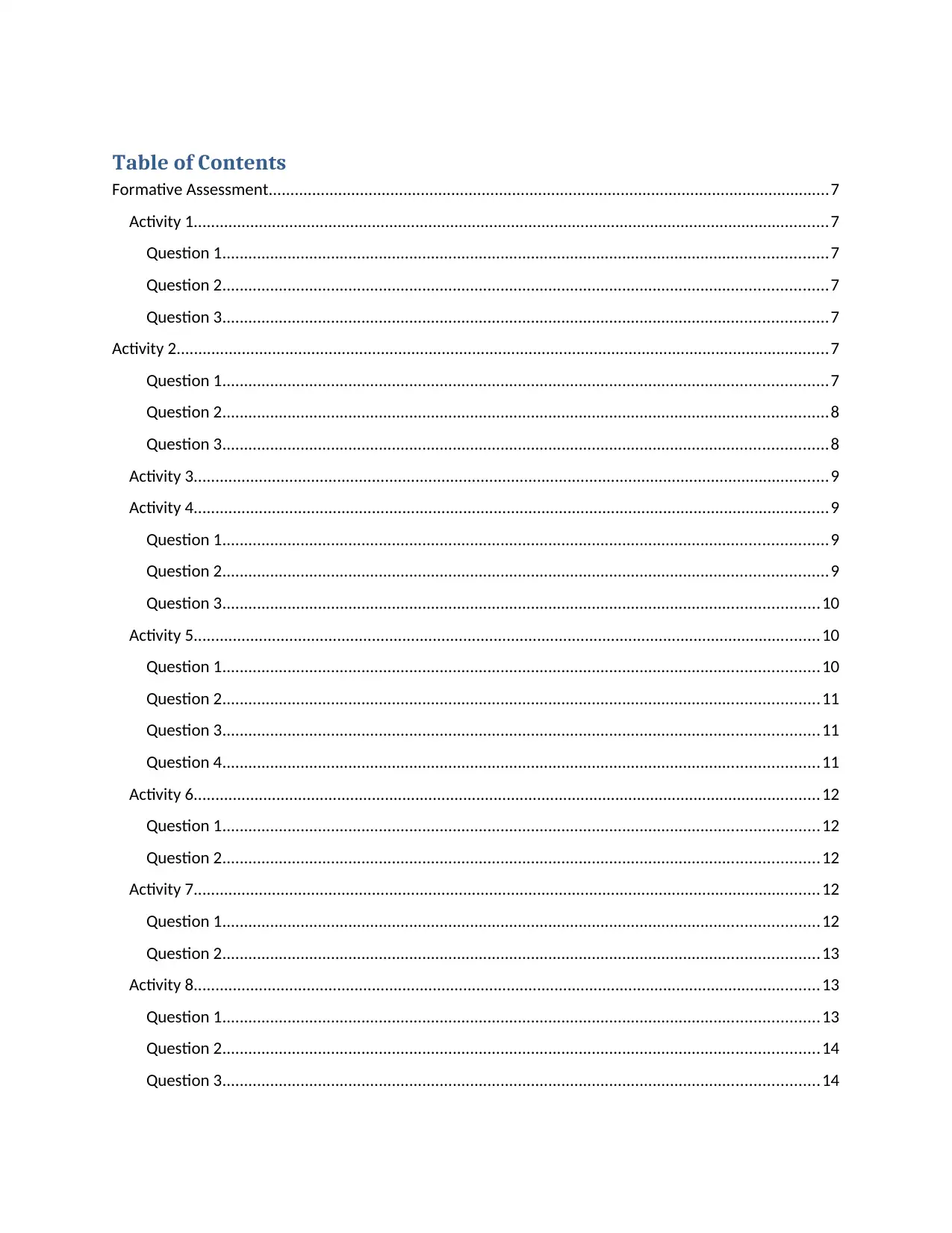
Table of Contents
Formative Assessment.................................................................................................................................7
Activity 1..................................................................................................................................................7
Question 1...........................................................................................................................................7
Question 2...........................................................................................................................................7
Question 3...........................................................................................................................................7
Activity 2......................................................................................................................................................7
Question 1...........................................................................................................................................7
Question 2...........................................................................................................................................8
Question 3...........................................................................................................................................8
Activity 3..................................................................................................................................................9
Activity 4..................................................................................................................................................9
Question 1...........................................................................................................................................9
Question 2...........................................................................................................................................9
Question 3.........................................................................................................................................10
Activity 5................................................................................................................................................10
Question 1.........................................................................................................................................10
Question 2.........................................................................................................................................11
Question 3.........................................................................................................................................11
Question 4.........................................................................................................................................11
Activity 6................................................................................................................................................12
Question 1.........................................................................................................................................12
Question 2.........................................................................................................................................12
Activity 7................................................................................................................................................12
Question 1.........................................................................................................................................12
Question 2.........................................................................................................................................13
Activity 8................................................................................................................................................13
Question 1.........................................................................................................................................13
Question 2.........................................................................................................................................14
Question 3.........................................................................................................................................14
Formative Assessment.................................................................................................................................7
Activity 1..................................................................................................................................................7
Question 1...........................................................................................................................................7
Question 2...........................................................................................................................................7
Question 3...........................................................................................................................................7
Activity 2......................................................................................................................................................7
Question 1...........................................................................................................................................7
Question 2...........................................................................................................................................8
Question 3...........................................................................................................................................8
Activity 3..................................................................................................................................................9
Activity 4..................................................................................................................................................9
Question 1...........................................................................................................................................9
Question 2...........................................................................................................................................9
Question 3.........................................................................................................................................10
Activity 5................................................................................................................................................10
Question 1.........................................................................................................................................10
Question 2.........................................................................................................................................11
Question 3.........................................................................................................................................11
Question 4.........................................................................................................................................11
Activity 6................................................................................................................................................12
Question 1.........................................................................................................................................12
Question 2.........................................................................................................................................12
Activity 7................................................................................................................................................12
Question 1.........................................................................................................................................12
Question 2.........................................................................................................................................13
Activity 8................................................................................................................................................13
Question 1.........................................................................................................................................13
Question 2.........................................................................................................................................14
Question 3.........................................................................................................................................14
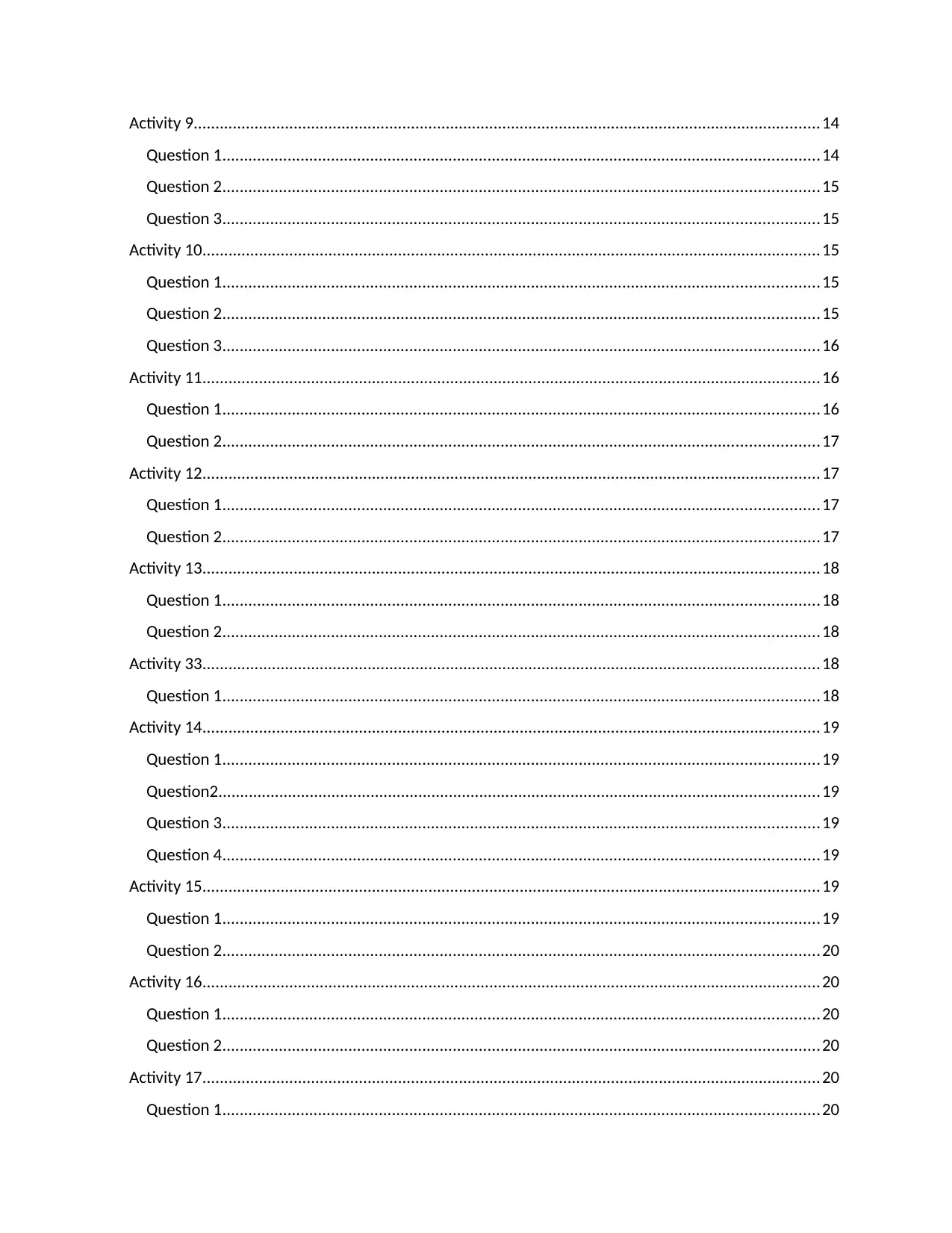
Activity 9................................................................................................................................................14
Question 1.........................................................................................................................................14
Question 2.........................................................................................................................................15
Question 3.........................................................................................................................................15
Activity 10..............................................................................................................................................15
Question 1.........................................................................................................................................15
Question 2.........................................................................................................................................15
Question 3.........................................................................................................................................16
Activity 11..............................................................................................................................................16
Question 1.........................................................................................................................................16
Question 2.........................................................................................................................................17
Activity 12..............................................................................................................................................17
Question 1.........................................................................................................................................17
Question 2.........................................................................................................................................17
Activity 13..............................................................................................................................................18
Question 1.........................................................................................................................................18
Question 2.........................................................................................................................................18
Activity 33..............................................................................................................................................18
Question 1.........................................................................................................................................18
Activity 14..............................................................................................................................................19
Question 1.........................................................................................................................................19
Question2..........................................................................................................................................19
Question 3.........................................................................................................................................19
Question 4.........................................................................................................................................19
Activity 15..............................................................................................................................................19
Question 1.........................................................................................................................................19
Question 2.........................................................................................................................................20
Activity 16..............................................................................................................................................20
Question 1.........................................................................................................................................20
Question 2.........................................................................................................................................20
Activity 17..............................................................................................................................................20
Question 1.........................................................................................................................................20
Question 1.........................................................................................................................................14
Question 2.........................................................................................................................................15
Question 3.........................................................................................................................................15
Activity 10..............................................................................................................................................15
Question 1.........................................................................................................................................15
Question 2.........................................................................................................................................15
Question 3.........................................................................................................................................16
Activity 11..............................................................................................................................................16
Question 1.........................................................................................................................................16
Question 2.........................................................................................................................................17
Activity 12..............................................................................................................................................17
Question 1.........................................................................................................................................17
Question 2.........................................................................................................................................17
Activity 13..............................................................................................................................................18
Question 1.........................................................................................................................................18
Question 2.........................................................................................................................................18
Activity 33..............................................................................................................................................18
Question 1.........................................................................................................................................18
Activity 14..............................................................................................................................................19
Question 1.........................................................................................................................................19
Question2..........................................................................................................................................19
Question 3.........................................................................................................................................19
Question 4.........................................................................................................................................19
Activity 15..............................................................................................................................................19
Question 1.........................................................................................................................................19
Question 2.........................................................................................................................................20
Activity 16..............................................................................................................................................20
Question 1.........................................................................................................................................20
Question 2.........................................................................................................................................20
Activity 17..............................................................................................................................................20
Question 1.........................................................................................................................................20
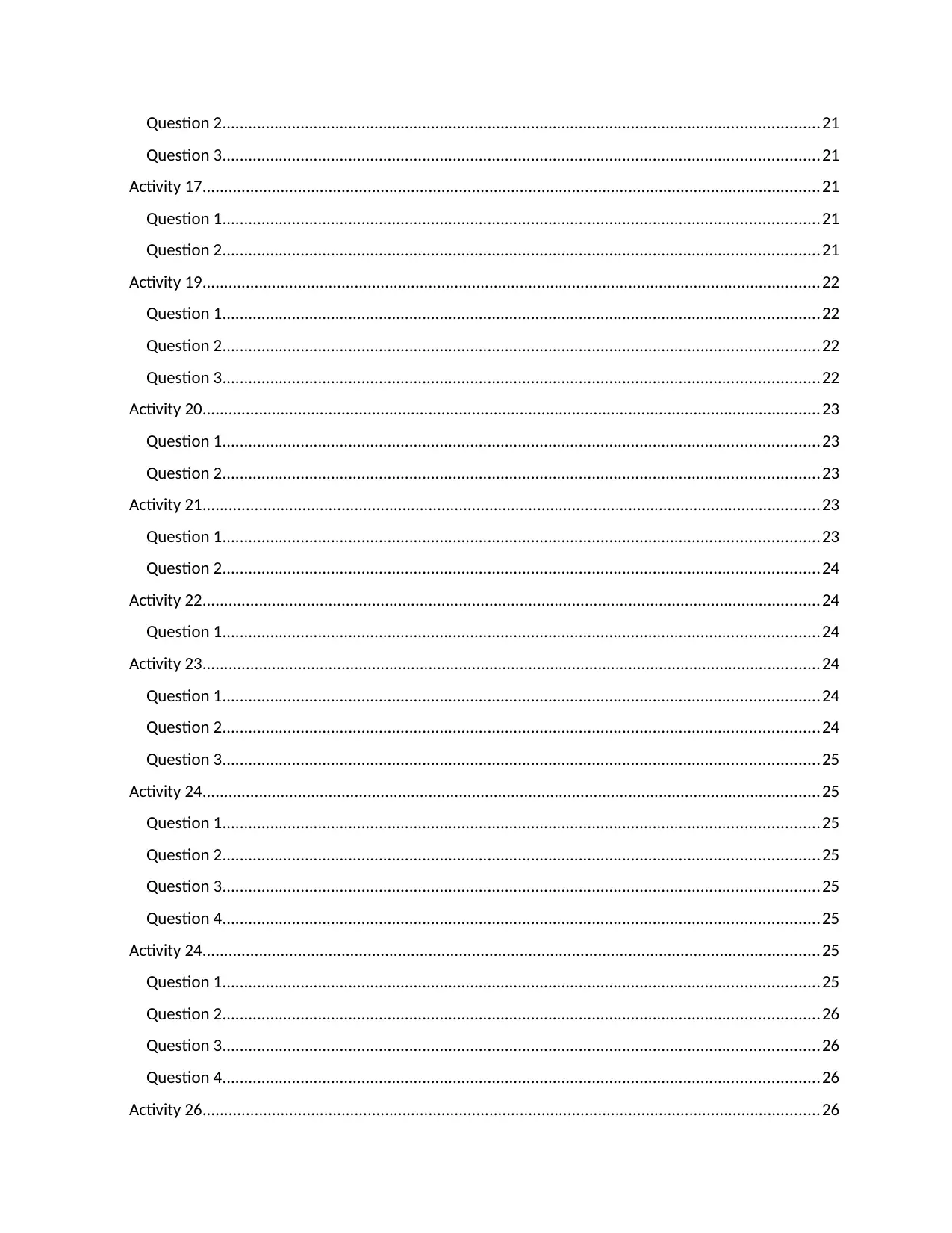
Question 2.........................................................................................................................................21
Question 3.........................................................................................................................................21
Activity 17..............................................................................................................................................21
Question 1.........................................................................................................................................21
Question 2.........................................................................................................................................21
Activity 19..............................................................................................................................................22
Question 1.........................................................................................................................................22
Question 2.........................................................................................................................................22
Question 3.........................................................................................................................................22
Activity 20..............................................................................................................................................23
Question 1.........................................................................................................................................23
Question 2.........................................................................................................................................23
Activity 21..............................................................................................................................................23
Question 1.........................................................................................................................................23
Question 2.........................................................................................................................................24
Activity 22..............................................................................................................................................24
Question 1.........................................................................................................................................24
Activity 23..............................................................................................................................................24
Question 1.........................................................................................................................................24
Question 2.........................................................................................................................................24
Question 3.........................................................................................................................................25
Activity 24..............................................................................................................................................25
Question 1.........................................................................................................................................25
Question 2.........................................................................................................................................25
Question 3.........................................................................................................................................25
Question 4.........................................................................................................................................25
Activity 24..............................................................................................................................................25
Question 1.........................................................................................................................................25
Question 2.........................................................................................................................................26
Question 3.........................................................................................................................................26
Question 4.........................................................................................................................................26
Activity 26..............................................................................................................................................26
Question 3.........................................................................................................................................21
Activity 17..............................................................................................................................................21
Question 1.........................................................................................................................................21
Question 2.........................................................................................................................................21
Activity 19..............................................................................................................................................22
Question 1.........................................................................................................................................22
Question 2.........................................................................................................................................22
Question 3.........................................................................................................................................22
Activity 20..............................................................................................................................................23
Question 1.........................................................................................................................................23
Question 2.........................................................................................................................................23
Activity 21..............................................................................................................................................23
Question 1.........................................................................................................................................23
Question 2.........................................................................................................................................24
Activity 22..............................................................................................................................................24
Question 1.........................................................................................................................................24
Activity 23..............................................................................................................................................24
Question 1.........................................................................................................................................24
Question 2.........................................................................................................................................24
Question 3.........................................................................................................................................25
Activity 24..............................................................................................................................................25
Question 1.........................................................................................................................................25
Question 2.........................................................................................................................................25
Question 3.........................................................................................................................................25
Question 4.........................................................................................................................................25
Activity 24..............................................................................................................................................25
Question 1.........................................................................................................................................25
Question 2.........................................................................................................................................26
Question 3.........................................................................................................................................26
Question 4.........................................................................................................................................26
Activity 26..............................................................................................................................................26
Secure Best Marks with AI Grader
Need help grading? Try our AI Grader for instant feedback on your assignments.
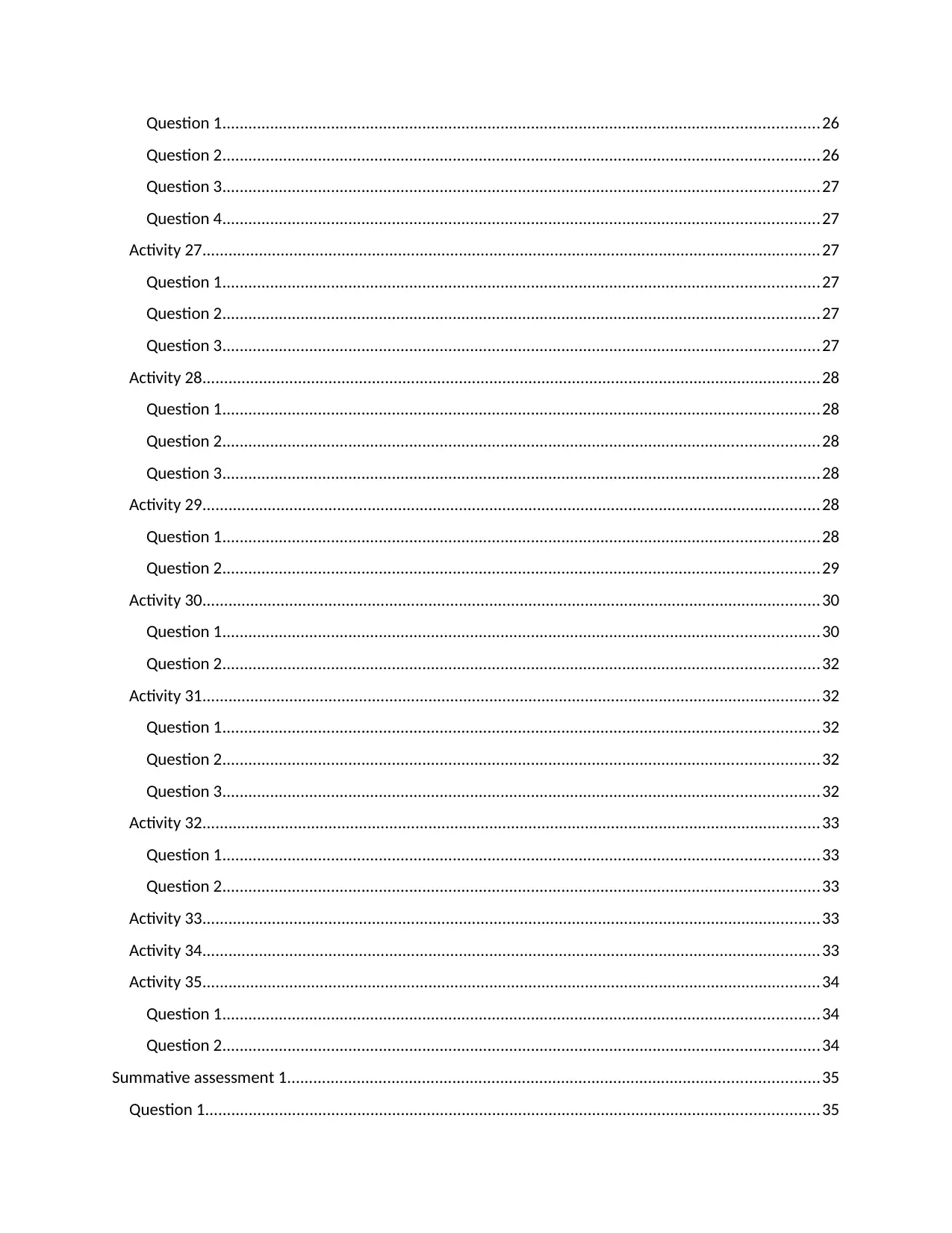
Question 1.........................................................................................................................................26
Question 2.........................................................................................................................................26
Question 3.........................................................................................................................................27
Question 4.........................................................................................................................................27
Activity 27..............................................................................................................................................27
Question 1.........................................................................................................................................27
Question 2.........................................................................................................................................27
Question 3.........................................................................................................................................27
Activity 28..............................................................................................................................................28
Question 1.........................................................................................................................................28
Question 2.........................................................................................................................................28
Question 3.........................................................................................................................................28
Activity 29..............................................................................................................................................28
Question 1.........................................................................................................................................28
Question 2.........................................................................................................................................29
Activity 30..............................................................................................................................................30
Question 1.........................................................................................................................................30
Question 2.........................................................................................................................................32
Activity 31..............................................................................................................................................32
Question 1.........................................................................................................................................32
Question 2.........................................................................................................................................32
Question 3.........................................................................................................................................32
Activity 32..............................................................................................................................................33
Question 1.........................................................................................................................................33
Question 2.........................................................................................................................................33
Activity 33..............................................................................................................................................33
Activity 34..............................................................................................................................................33
Activity 35..............................................................................................................................................34
Question 1.........................................................................................................................................34
Question 2.........................................................................................................................................34
Summative assessment 1..........................................................................................................................35
Question 1.............................................................................................................................................35
Question 2.........................................................................................................................................26
Question 3.........................................................................................................................................27
Question 4.........................................................................................................................................27
Activity 27..............................................................................................................................................27
Question 1.........................................................................................................................................27
Question 2.........................................................................................................................................27
Question 3.........................................................................................................................................27
Activity 28..............................................................................................................................................28
Question 1.........................................................................................................................................28
Question 2.........................................................................................................................................28
Question 3.........................................................................................................................................28
Activity 29..............................................................................................................................................28
Question 1.........................................................................................................................................28
Question 2.........................................................................................................................................29
Activity 30..............................................................................................................................................30
Question 1.........................................................................................................................................30
Question 2.........................................................................................................................................32
Activity 31..............................................................................................................................................32
Question 1.........................................................................................................................................32
Question 2.........................................................................................................................................32
Question 3.........................................................................................................................................32
Activity 32..............................................................................................................................................33
Question 1.........................................................................................................................................33
Question 2.........................................................................................................................................33
Activity 33..............................................................................................................................................33
Activity 34..............................................................................................................................................33
Activity 35..............................................................................................................................................34
Question 1.........................................................................................................................................34
Question 2.........................................................................................................................................34
Summative assessment 1..........................................................................................................................35
Question 1.............................................................................................................................................35
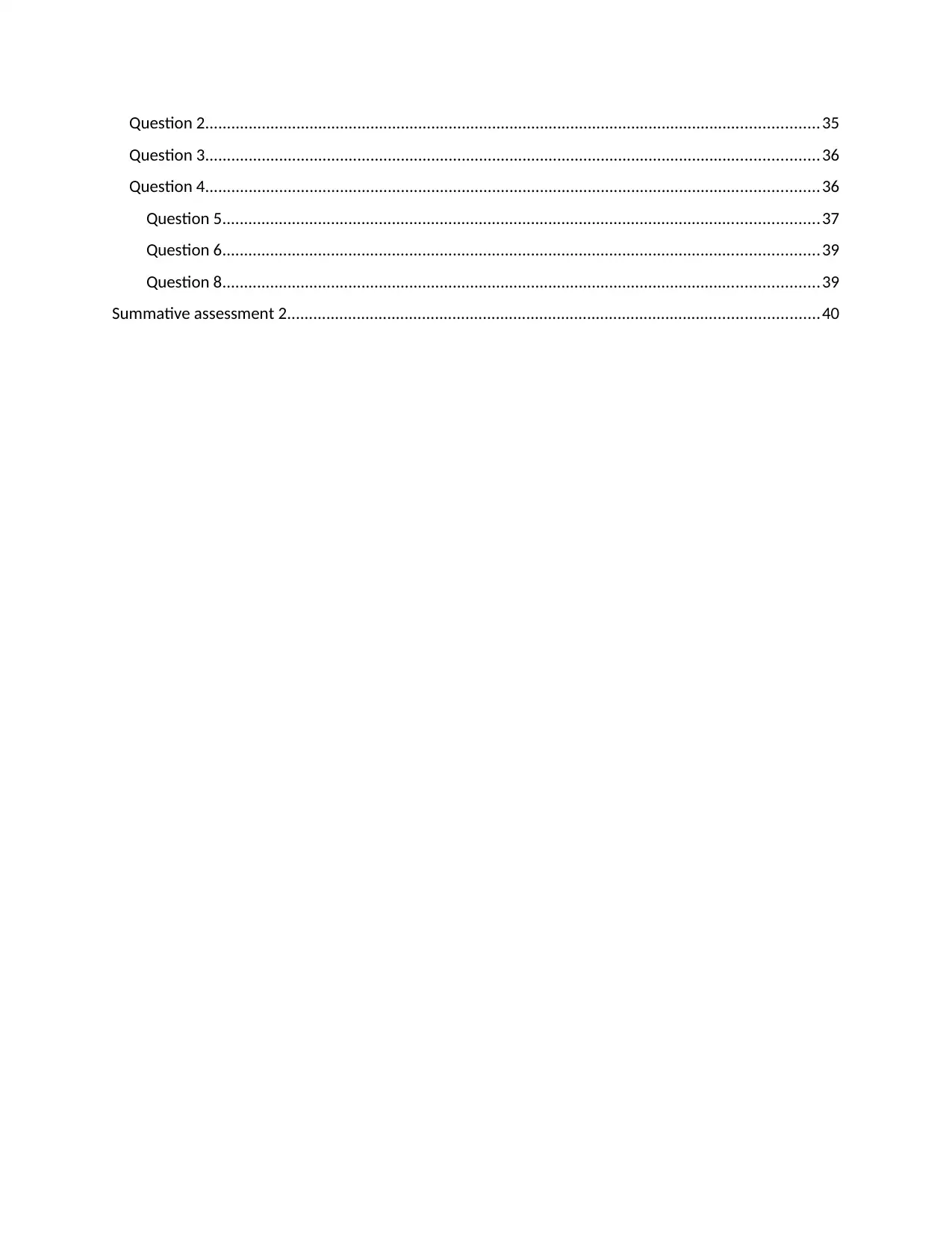
Question 2.............................................................................................................................................35
Question 3.............................................................................................................................................36
Question 4.............................................................................................................................................36
Question 5.........................................................................................................................................37
Question 6.........................................................................................................................................39
Question 8.........................................................................................................................................39
Summative assessment 2..........................................................................................................................40
Question 3.............................................................................................................................................36
Question 4.............................................................................................................................................36
Question 5.........................................................................................................................................37
Question 6.........................................................................................................................................39
Question 8.........................................................................................................................................39
Summative assessment 2..........................................................................................................................40
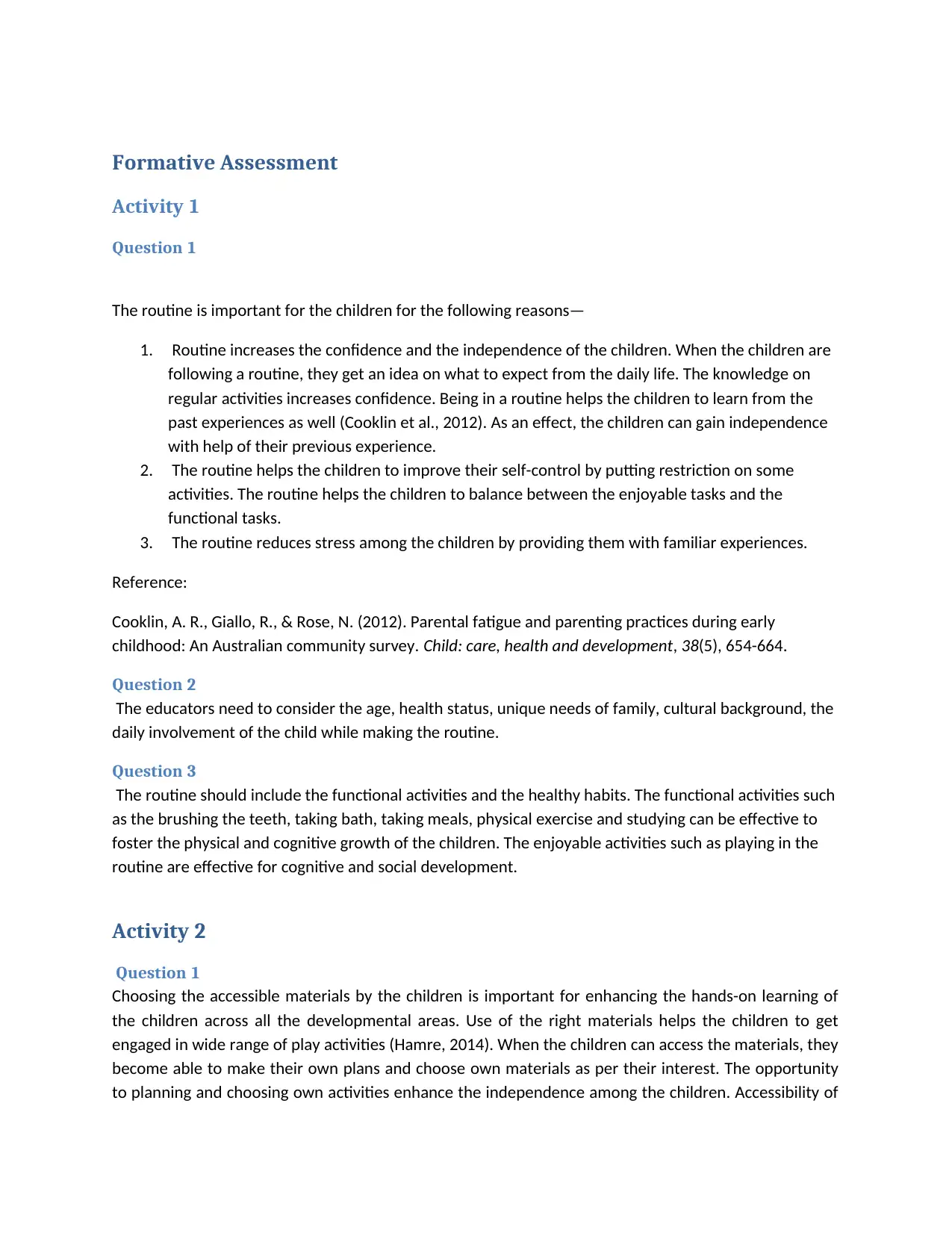
Formative Assessment
Activity 1
Question 1
The routine is important for the children for the following reasons—
1. Routine increases the confidence and the independence of the children. When the children are
following a routine, they get an idea on what to expect from the daily life. The knowledge on
regular activities increases confidence. Being in a routine helps the children to learn from the
past experiences as well (Cooklin et al., 2012). As an effect, the children can gain independence
with help of their previous experience.
2. The routine helps the children to improve their self-control by putting restriction on some
activities. The routine helps the children to balance between the enjoyable tasks and the
functional tasks.
3. The routine reduces stress among the children by providing them with familiar experiences.
Reference:
Cooklin, A. R., Giallo, R., & Rose, N. (2012). Parental fatigue and parenting practices during early
childhood: An Australian community survey. Child: care, health and development, 38(5), 654-664.
Question 2
The educators need to consider the age, health status, unique needs of family, cultural background, the
daily involvement of the child while making the routine.
Question 3
The routine should include the functional activities and the healthy habits. The functional activities such
as the brushing the teeth, taking bath, taking meals, physical exercise and studying can be effective to
foster the physical and cognitive growth of the children. The enjoyable activities such as playing in the
routine are effective for cognitive and social development.
Activity 2
Question 1
Choosing the accessible materials by the children is important for enhancing the hands-on learning of
the children across all the developmental areas. Use of the right materials helps the children to get
engaged in wide range of play activities (Hamre, 2014). When the children can access the materials, they
become able to make their own plans and choose own materials as per their interest. The opportunity
to planning and choosing own activities enhance the independence among the children. Accessibility of
Activity 1
Question 1
The routine is important for the children for the following reasons—
1. Routine increases the confidence and the independence of the children. When the children are
following a routine, they get an idea on what to expect from the daily life. The knowledge on
regular activities increases confidence. Being in a routine helps the children to learn from the
past experiences as well (Cooklin et al., 2012). As an effect, the children can gain independence
with help of their previous experience.
2. The routine helps the children to improve their self-control by putting restriction on some
activities. The routine helps the children to balance between the enjoyable tasks and the
functional tasks.
3. The routine reduces stress among the children by providing them with familiar experiences.
Reference:
Cooklin, A. R., Giallo, R., & Rose, N. (2012). Parental fatigue and parenting practices during early
childhood: An Australian community survey. Child: care, health and development, 38(5), 654-664.
Question 2
The educators need to consider the age, health status, unique needs of family, cultural background, the
daily involvement of the child while making the routine.
Question 3
The routine should include the functional activities and the healthy habits. The functional activities such
as the brushing the teeth, taking bath, taking meals, physical exercise and studying can be effective to
foster the physical and cognitive growth of the children. The enjoyable activities such as playing in the
routine are effective for cognitive and social development.
Activity 2
Question 1
Choosing the accessible materials by the children is important for enhancing the hands-on learning of
the children across all the developmental areas. Use of the right materials helps the children to get
engaged in wide range of play activities (Hamre, 2014). When the children can access the materials, they
become able to make their own plans and choose own materials as per their interest. The opportunity
to planning and choosing own activities enhance the independence among the children. Accessibility of
Paraphrase This Document
Need a fresh take? Get an instant paraphrase of this document with our AI Paraphraser
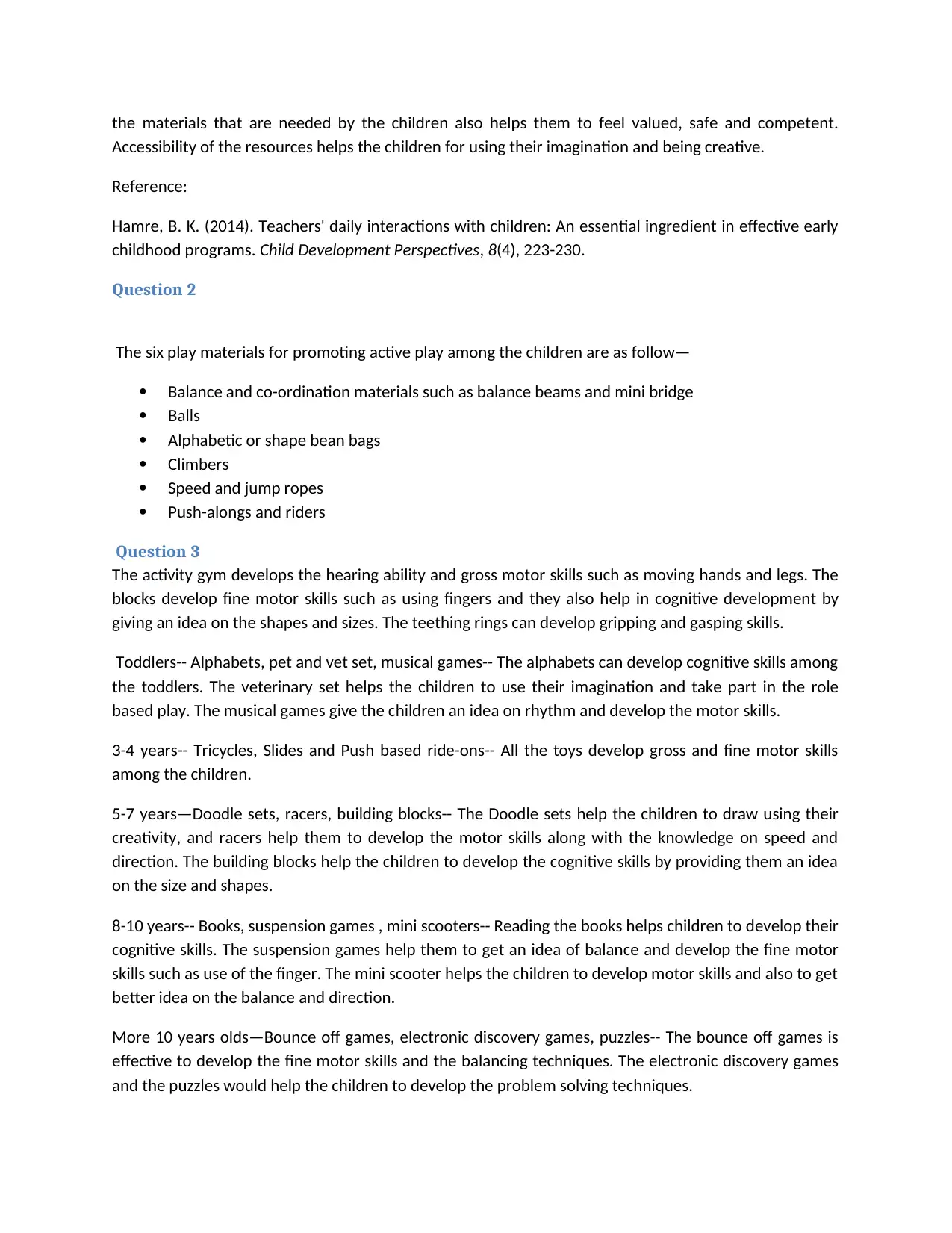
the materials that are needed by the children also helps them to feel valued, safe and competent.
Accessibility of the resources helps the children for using their imagination and being creative.
Reference:
Hamre, B. K. (2014). Teachers' daily interactions with children: An essential ingredient in effective early
childhood programs. Child Development Perspectives, 8(4), 223-230.
Question 2
The six play materials for promoting active play among the children are as follow—
Balance and co-ordination materials such as balance beams and mini bridge
Balls
Alphabetic or shape bean bags
Climbers
Speed and jump ropes
Push-alongs and riders
Question 3
The activity gym develops the hearing ability and gross motor skills such as moving hands and legs. The
blocks develop fine motor skills such as using fingers and they also help in cognitive development by
giving an idea on the shapes and sizes. The teething rings can develop gripping and gasping skills.
Toddlers-- Alphabets, pet and vet set, musical games-- The alphabets can develop cognitive skills among
the toddlers. The veterinary set helps the children to use their imagination and take part in the role
based play. The musical games give the children an idea on rhythm and develop the motor skills.
3-4 years-- Tricycles, Slides and Push based ride-ons-- All the toys develop gross and fine motor skills
among the children.
5-7 years—Doodle sets, racers, building blocks-- The Doodle sets help the children to draw using their
creativity, and racers help them to develop the motor skills along with the knowledge on speed and
direction. The building blocks help the children to develop the cognitive skills by providing them an idea
on the size and shapes.
8-10 years-- Books, suspension games , mini scooters-- Reading the books helps children to develop their
cognitive skills. The suspension games help them to get an idea of balance and develop the fine motor
skills such as use of the finger. The mini scooter helps the children to develop motor skills and also to get
better idea on the balance and direction.
More 10 years olds—Bounce off games, electronic discovery games, puzzles-- The bounce off games is
effective to develop the fine motor skills and the balancing techniques. The electronic discovery games
and the puzzles would help the children to develop the problem solving techniques.
Accessibility of the resources helps the children for using their imagination and being creative.
Reference:
Hamre, B. K. (2014). Teachers' daily interactions with children: An essential ingredient in effective early
childhood programs. Child Development Perspectives, 8(4), 223-230.
Question 2
The six play materials for promoting active play among the children are as follow—
Balance and co-ordination materials such as balance beams and mini bridge
Balls
Alphabetic or shape bean bags
Climbers
Speed and jump ropes
Push-alongs and riders
Question 3
The activity gym develops the hearing ability and gross motor skills such as moving hands and legs. The
blocks develop fine motor skills such as using fingers and they also help in cognitive development by
giving an idea on the shapes and sizes. The teething rings can develop gripping and gasping skills.
Toddlers-- Alphabets, pet and vet set, musical games-- The alphabets can develop cognitive skills among
the toddlers. The veterinary set helps the children to use their imagination and take part in the role
based play. The musical games give the children an idea on rhythm and develop the motor skills.
3-4 years-- Tricycles, Slides and Push based ride-ons-- All the toys develop gross and fine motor skills
among the children.
5-7 years—Doodle sets, racers, building blocks-- The Doodle sets help the children to draw using their
creativity, and racers help them to develop the motor skills along with the knowledge on speed and
direction. The building blocks help the children to develop the cognitive skills by providing them an idea
on the size and shapes.
8-10 years-- Books, suspension games , mini scooters-- Reading the books helps children to develop their
cognitive skills. The suspension games help them to get an idea of balance and develop the fine motor
skills such as use of the finger. The mini scooter helps the children to develop motor skills and also to get
better idea on the balance and direction.
More 10 years olds—Bounce off games, electronic discovery games, puzzles-- The bounce off games is
effective to develop the fine motor skills and the balancing techniques. The electronic discovery games
and the puzzles would help the children to develop the problem solving techniques.
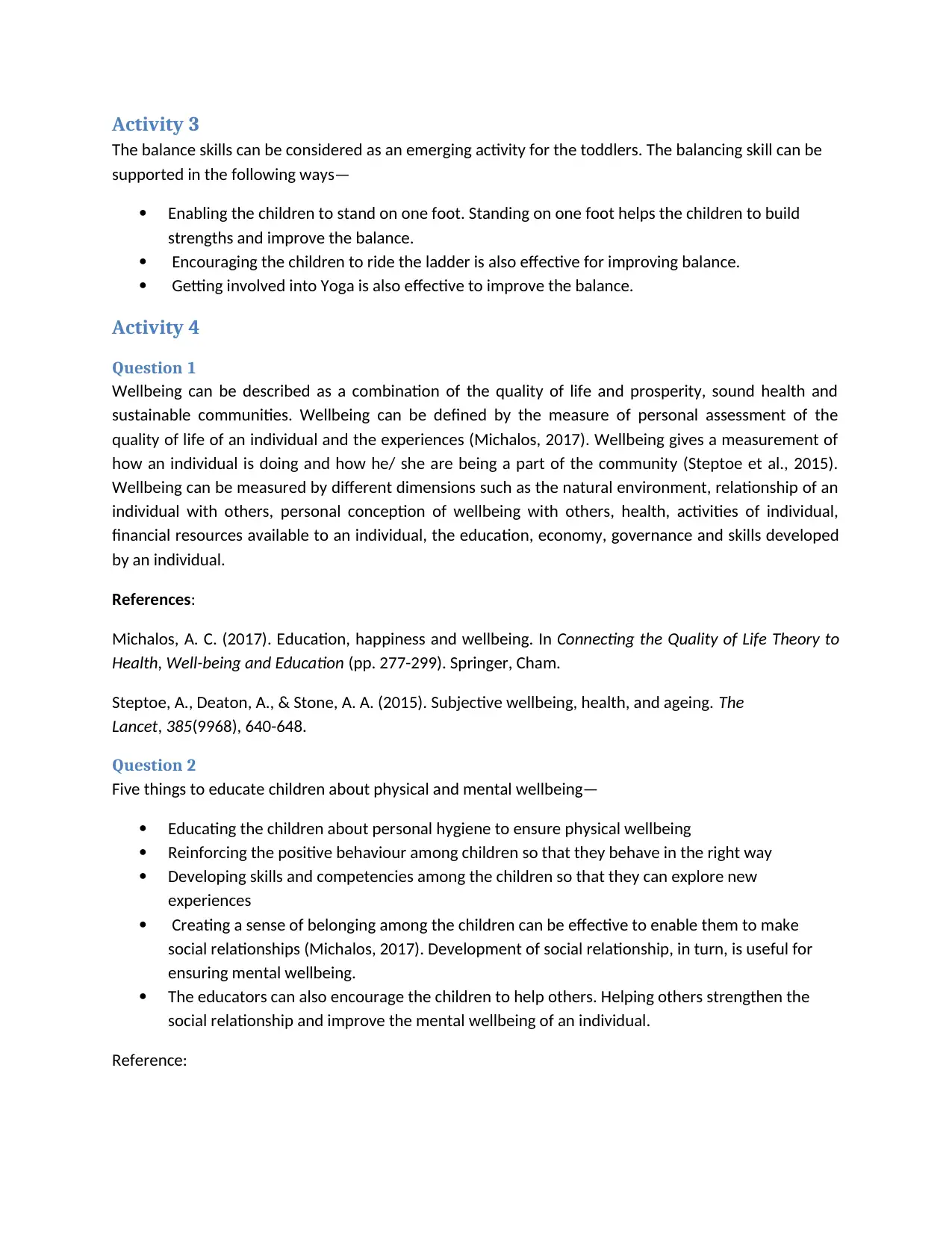
Activity 3
The balance skills can be considered as an emerging activity for the toddlers. The balancing skill can be
supported in the following ways—
Enabling the children to stand on one foot. Standing on one foot helps the children to build
strengths and improve the balance.
Encouraging the children to ride the ladder is also effective for improving balance.
Getting involved into Yoga is also effective to improve the balance.
Activity 4
Question 1
Wellbeing can be described as a combination of the quality of life and prosperity, sound health and
sustainable communities. Wellbeing can be defined by the measure of personal assessment of the
quality of life of an individual and the experiences (Michalos, 2017). Wellbeing gives a measurement of
how an individual is doing and how he/ she are being a part of the community (Steptoe et al., 2015).
Wellbeing can be measured by different dimensions such as the natural environment, relationship of an
individual with others, personal conception of wellbeing with others, health, activities of individual,
financial resources available to an individual, the education, economy, governance and skills developed
by an individual.
References:
Michalos, A. C. (2017). Education, happiness and wellbeing. In Connecting the Quality of Life Theory to
Health, Well-being and Education (pp. 277-299). Springer, Cham.
Steptoe, A., Deaton, A., & Stone, A. A. (2015). Subjective wellbeing, health, and ageing. The
Lancet, 385(9968), 640-648.
Question 2
Five things to educate children about physical and mental wellbeing—
Educating the children about personal hygiene to ensure physical wellbeing
Reinforcing the positive behaviour among children so that they behave in the right way
Developing skills and competencies among the children so that they can explore new
experiences
Creating a sense of belonging among the children can be effective to enable them to make
social relationships (Michalos, 2017). Development of social relationship, in turn, is useful for
ensuring mental wellbeing.
The educators can also encourage the children to help others. Helping others strengthen the
social relationship and improve the mental wellbeing of an individual.
Reference:
The balance skills can be considered as an emerging activity for the toddlers. The balancing skill can be
supported in the following ways—
Enabling the children to stand on one foot. Standing on one foot helps the children to build
strengths and improve the balance.
Encouraging the children to ride the ladder is also effective for improving balance.
Getting involved into Yoga is also effective to improve the balance.
Activity 4
Question 1
Wellbeing can be described as a combination of the quality of life and prosperity, sound health and
sustainable communities. Wellbeing can be defined by the measure of personal assessment of the
quality of life of an individual and the experiences (Michalos, 2017). Wellbeing gives a measurement of
how an individual is doing and how he/ she are being a part of the community (Steptoe et al., 2015).
Wellbeing can be measured by different dimensions such as the natural environment, relationship of an
individual with others, personal conception of wellbeing with others, health, activities of individual,
financial resources available to an individual, the education, economy, governance and skills developed
by an individual.
References:
Michalos, A. C. (2017). Education, happiness and wellbeing. In Connecting the Quality of Life Theory to
Health, Well-being and Education (pp. 277-299). Springer, Cham.
Steptoe, A., Deaton, A., & Stone, A. A. (2015). Subjective wellbeing, health, and ageing. The
Lancet, 385(9968), 640-648.
Question 2
Five things to educate children about physical and mental wellbeing—
Educating the children about personal hygiene to ensure physical wellbeing
Reinforcing the positive behaviour among children so that they behave in the right way
Developing skills and competencies among the children so that they can explore new
experiences
Creating a sense of belonging among the children can be effective to enable them to make
social relationships (Michalos, 2017). Development of social relationship, in turn, is useful for
ensuring mental wellbeing.
The educators can also encourage the children to help others. Helping others strengthen the
social relationship and improve the mental wellbeing of an individual.
Reference:
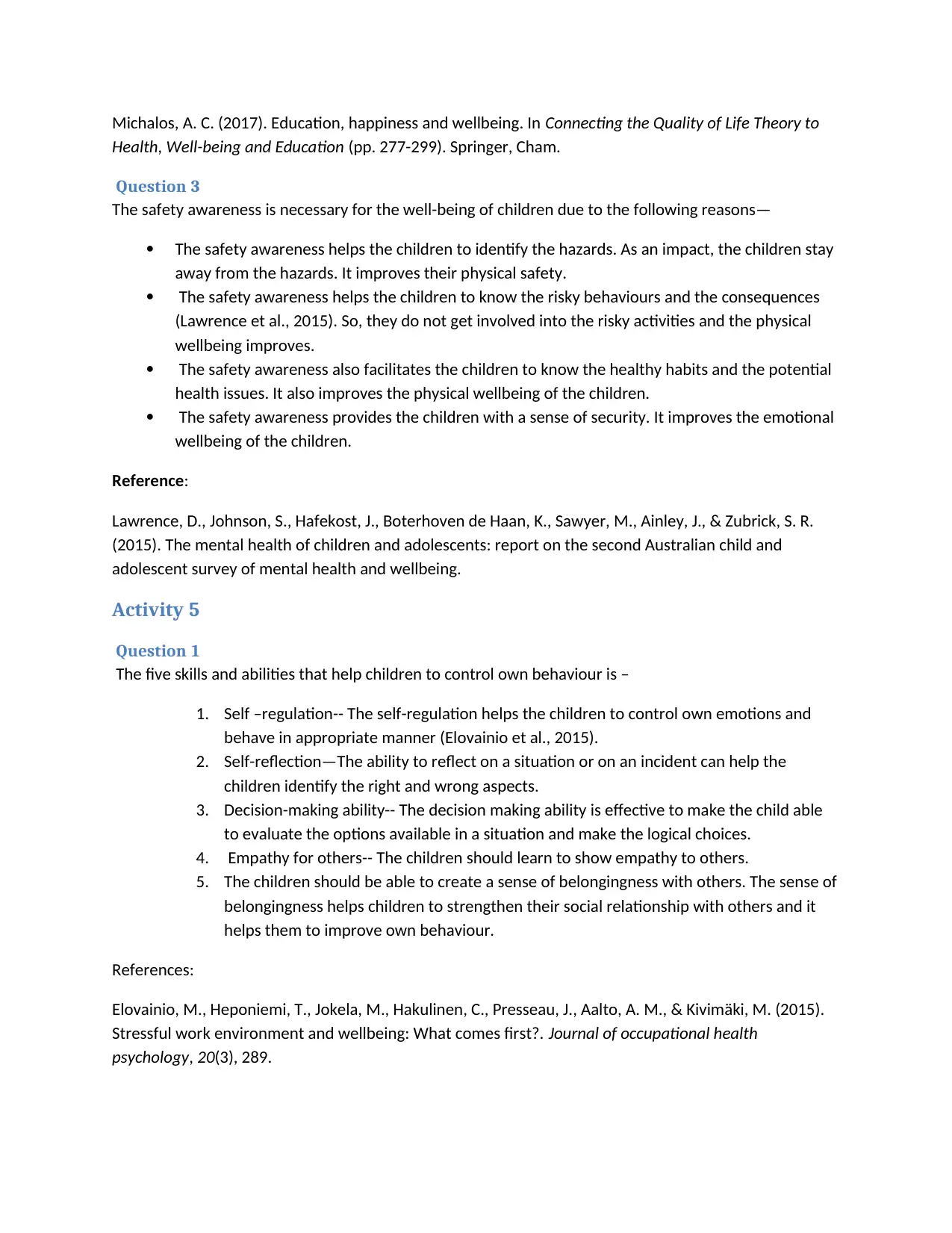
Michalos, A. C. (2017). Education, happiness and wellbeing. In Connecting the Quality of Life Theory to
Health, Well-being and Education (pp. 277-299). Springer, Cham.
Question 3
The safety awareness is necessary for the well-being of children due to the following reasons—
The safety awareness helps the children to identify the hazards. As an impact, the children stay
away from the hazards. It improves their physical safety.
The safety awareness helps the children to know the risky behaviours and the consequences
(Lawrence et al., 2015). So, they do not get involved into the risky activities and the physical
wellbeing improves.
The safety awareness also facilitates the children to know the healthy habits and the potential
health issues. It also improves the physical wellbeing of the children.
The safety awareness provides the children with a sense of security. It improves the emotional
wellbeing of the children.
Reference:
Lawrence, D., Johnson, S., Hafekost, J., Boterhoven de Haan, K., Sawyer, M., Ainley, J., & Zubrick, S. R.
(2015). The mental health of children and adolescents: report on the second Australian child and
adolescent survey of mental health and wellbeing.
Activity 5
Question 1
The five skills and abilities that help children to control own behaviour is –
1. Self –regulation-- The self-regulation helps the children to control own emotions and
behave in appropriate manner (Elovainio et al., 2015).
2. Self-reflection—The ability to reflect on a situation or on an incident can help the
children identify the right and wrong aspects.
3. Decision-making ability-- The decision making ability is effective to make the child able
to evaluate the options available in a situation and make the logical choices.
4. Empathy for others-- The children should learn to show empathy to others.
5. The children should be able to create a sense of belongingness with others. The sense of
belongingness helps children to strengthen their social relationship with others and it
helps them to improve own behaviour.
References:
Elovainio, M., Heponiemi, T., Jokela, M., Hakulinen, C., Presseau, J., Aalto, A. M., & Kivimäki, M. (2015).
Stressful work environment and wellbeing: What comes first?. Journal of occupational health
psychology, 20(3), 289.
Health, Well-being and Education (pp. 277-299). Springer, Cham.
Question 3
The safety awareness is necessary for the well-being of children due to the following reasons—
The safety awareness helps the children to identify the hazards. As an impact, the children stay
away from the hazards. It improves their physical safety.
The safety awareness helps the children to know the risky behaviours and the consequences
(Lawrence et al., 2015). So, they do not get involved into the risky activities and the physical
wellbeing improves.
The safety awareness also facilitates the children to know the healthy habits and the potential
health issues. It also improves the physical wellbeing of the children.
The safety awareness provides the children with a sense of security. It improves the emotional
wellbeing of the children.
Reference:
Lawrence, D., Johnson, S., Hafekost, J., Boterhoven de Haan, K., Sawyer, M., Ainley, J., & Zubrick, S. R.
(2015). The mental health of children and adolescents: report on the second Australian child and
adolescent survey of mental health and wellbeing.
Activity 5
Question 1
The five skills and abilities that help children to control own behaviour is –
1. Self –regulation-- The self-regulation helps the children to control own emotions and
behave in appropriate manner (Elovainio et al., 2015).
2. Self-reflection—The ability to reflect on a situation or on an incident can help the
children identify the right and wrong aspects.
3. Decision-making ability-- The decision making ability is effective to make the child able
to evaluate the options available in a situation and make the logical choices.
4. Empathy for others-- The children should learn to show empathy to others.
5. The children should be able to create a sense of belongingness with others. The sense of
belongingness helps children to strengthen their social relationship with others and it
helps them to improve own behaviour.
References:
Elovainio, M., Heponiemi, T., Jokela, M., Hakulinen, C., Presseau, J., Aalto, A. M., & Kivimäki, M. (2015).
Stressful work environment and wellbeing: What comes first?. Journal of occupational health
psychology, 20(3), 289.
Secure Best Marks with AI Grader
Need help grading? Try our AI Grader for instant feedback on your assignments.
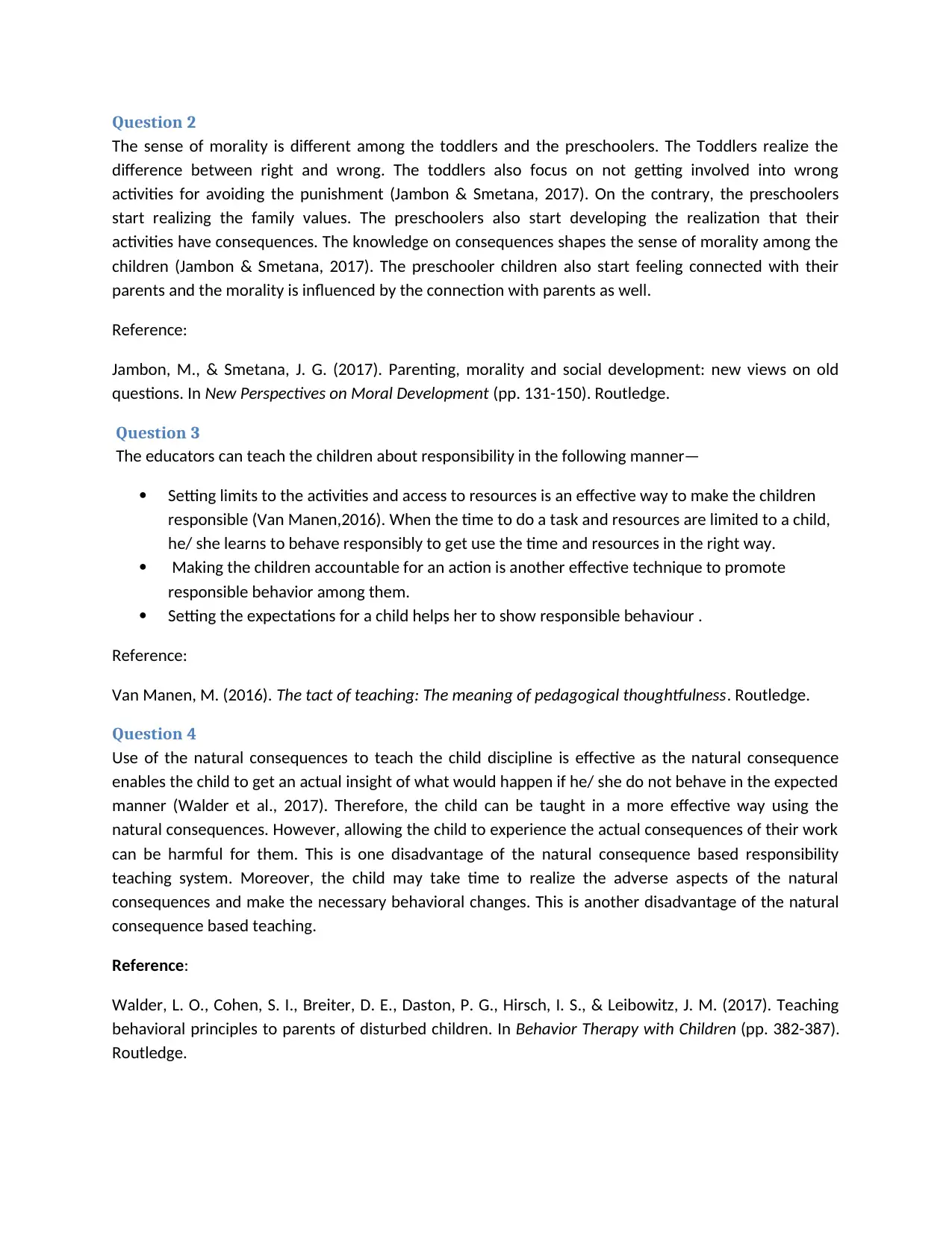
Question 2
The sense of morality is different among the toddlers and the preschoolers. The Toddlers realize the
difference between right and wrong. The toddlers also focus on not getting involved into wrong
activities for avoiding the punishment (Jambon & Smetana, 2017). On the contrary, the preschoolers
start realizing the family values. The preschoolers also start developing the realization that their
activities have consequences. The knowledge on consequences shapes the sense of morality among the
children (Jambon & Smetana, 2017). The preschooler children also start feeling connected with their
parents and the morality is influenced by the connection with parents as well.
Reference:
Jambon, M., & Smetana, J. G. (2017). Parenting, morality and social development: new views on old
questions. In New Perspectives on Moral Development (pp. 131-150). Routledge.
Question 3
The educators can teach the children about responsibility in the following manner—
Setting limits to the activities and access to resources is an effective way to make the children
responsible (Van Manen,2016). When the time to do a task and resources are limited to a child,
he/ she learns to behave responsibly to get use the time and resources in the right way.
Making the children accountable for an action is another effective technique to promote
responsible behavior among them.
Setting the expectations for a child helps her to show responsible behaviour .
Reference:
Van Manen, M. (2016). The tact of teaching: The meaning of pedagogical thoughtfulness. Routledge.
Question 4
Use of the natural consequences to teach the child discipline is effective as the natural consequence
enables the child to get an actual insight of what would happen if he/ she do not behave in the expected
manner (Walder et al., 2017). Therefore, the child can be taught in a more effective way using the
natural consequences. However, allowing the child to experience the actual consequences of their work
can be harmful for them. This is one disadvantage of the natural consequence based responsibility
teaching system. Moreover, the child may take time to realize the adverse aspects of the natural
consequences and make the necessary behavioral changes. This is another disadvantage of the natural
consequence based teaching.
Reference:
Walder, L. O., Cohen, S. I., Breiter, D. E., Daston, P. G., Hirsch, I. S., & Leibowitz, J. M. (2017). Teaching
behavioral principles to parents of disturbed children. In Behavior Therapy with Children (pp. 382-387).
Routledge.
The sense of morality is different among the toddlers and the preschoolers. The Toddlers realize the
difference between right and wrong. The toddlers also focus on not getting involved into wrong
activities for avoiding the punishment (Jambon & Smetana, 2017). On the contrary, the preschoolers
start realizing the family values. The preschoolers also start developing the realization that their
activities have consequences. The knowledge on consequences shapes the sense of morality among the
children (Jambon & Smetana, 2017). The preschooler children also start feeling connected with their
parents and the morality is influenced by the connection with parents as well.
Reference:
Jambon, M., & Smetana, J. G. (2017). Parenting, morality and social development: new views on old
questions. In New Perspectives on Moral Development (pp. 131-150). Routledge.
Question 3
The educators can teach the children about responsibility in the following manner—
Setting limits to the activities and access to resources is an effective way to make the children
responsible (Van Manen,2016). When the time to do a task and resources are limited to a child,
he/ she learns to behave responsibly to get use the time and resources in the right way.
Making the children accountable for an action is another effective technique to promote
responsible behavior among them.
Setting the expectations for a child helps her to show responsible behaviour .
Reference:
Van Manen, M. (2016). The tact of teaching: The meaning of pedagogical thoughtfulness. Routledge.
Question 4
Use of the natural consequences to teach the child discipline is effective as the natural consequence
enables the child to get an actual insight of what would happen if he/ she do not behave in the expected
manner (Walder et al., 2017). Therefore, the child can be taught in a more effective way using the
natural consequences. However, allowing the child to experience the actual consequences of their work
can be harmful for them. This is one disadvantage of the natural consequence based responsibility
teaching system. Moreover, the child may take time to realize the adverse aspects of the natural
consequences and make the necessary behavioral changes. This is another disadvantage of the natural
consequence based teaching.
Reference:
Walder, L. O., Cohen, S. I., Breiter, D. E., Daston, P. G., Hirsch, I. S., & Leibowitz, J. M. (2017). Teaching
behavioral principles to parents of disturbed children. In Behavior Therapy with Children (pp. 382-387).
Routledge.
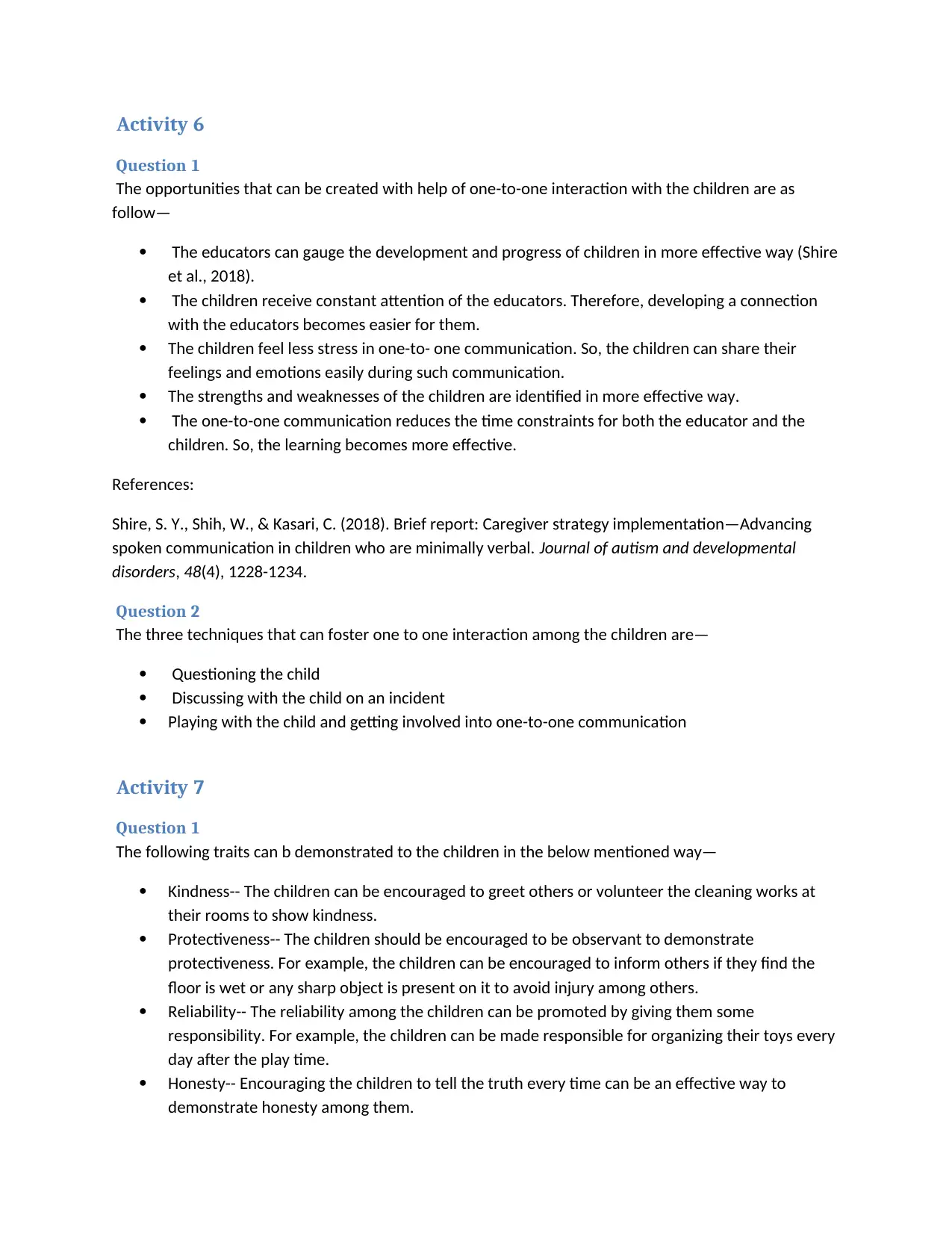
Activity 6
Question 1
The opportunities that can be created with help of one-to-one interaction with the children are as
follow—
The educators can gauge the development and progress of children in more effective way (Shire
et al., 2018).
The children receive constant attention of the educators. Therefore, developing a connection
with the educators becomes easier for them.
The children feel less stress in one-to- one communication. So, the children can share their
feelings and emotions easily during such communication.
The strengths and weaknesses of the children are identified in more effective way.
The one-to-one communication reduces the time constraints for both the educator and the
children. So, the learning becomes more effective.
References:
Shire, S. Y., Shih, W., & Kasari, C. (2018). Brief report: Caregiver strategy implementation—Advancing
spoken communication in children who are minimally verbal. Journal of autism and developmental
disorders, 48(4), 1228-1234.
Question 2
The three techniques that can foster one to one interaction among the children are—
Questioning the child
Discussing with the child on an incident
Playing with the child and getting involved into one-to-one communication
Activity 7
Question 1
The following traits can b demonstrated to the children in the below mentioned way—
Kindness-- The children can be encouraged to greet others or volunteer the cleaning works at
their rooms to show kindness.
Protectiveness-- The children should be encouraged to be observant to demonstrate
protectiveness. For example, the children can be encouraged to inform others if they find the
floor is wet or any sharp object is present on it to avoid injury among others.
Reliability-- The reliability among the children can be promoted by giving them some
responsibility. For example, the children can be made responsible for organizing their toys every
day after the play time.
Honesty-- Encouraging the children to tell the truth every time can be an effective way to
demonstrate honesty among them.
Question 1
The opportunities that can be created with help of one-to-one interaction with the children are as
follow—
The educators can gauge the development and progress of children in more effective way (Shire
et al., 2018).
The children receive constant attention of the educators. Therefore, developing a connection
with the educators becomes easier for them.
The children feel less stress in one-to- one communication. So, the children can share their
feelings and emotions easily during such communication.
The strengths and weaknesses of the children are identified in more effective way.
The one-to-one communication reduces the time constraints for both the educator and the
children. So, the learning becomes more effective.
References:
Shire, S. Y., Shih, W., & Kasari, C. (2018). Brief report: Caregiver strategy implementation—Advancing
spoken communication in children who are minimally verbal. Journal of autism and developmental
disorders, 48(4), 1228-1234.
Question 2
The three techniques that can foster one to one interaction among the children are—
Questioning the child
Discussing with the child on an incident
Playing with the child and getting involved into one-to-one communication
Activity 7
Question 1
The following traits can b demonstrated to the children in the below mentioned way—
Kindness-- The children can be encouraged to greet others or volunteer the cleaning works at
their rooms to show kindness.
Protectiveness-- The children should be encouraged to be observant to demonstrate
protectiveness. For example, the children can be encouraged to inform others if they find the
floor is wet or any sharp object is present on it to avoid injury among others.
Reliability-- The reliability among the children can be promoted by giving them some
responsibility. For example, the children can be made responsible for organizing their toys every
day after the play time.
Honesty-- Encouraging the children to tell the truth every time can be an effective way to
demonstrate honesty among them.
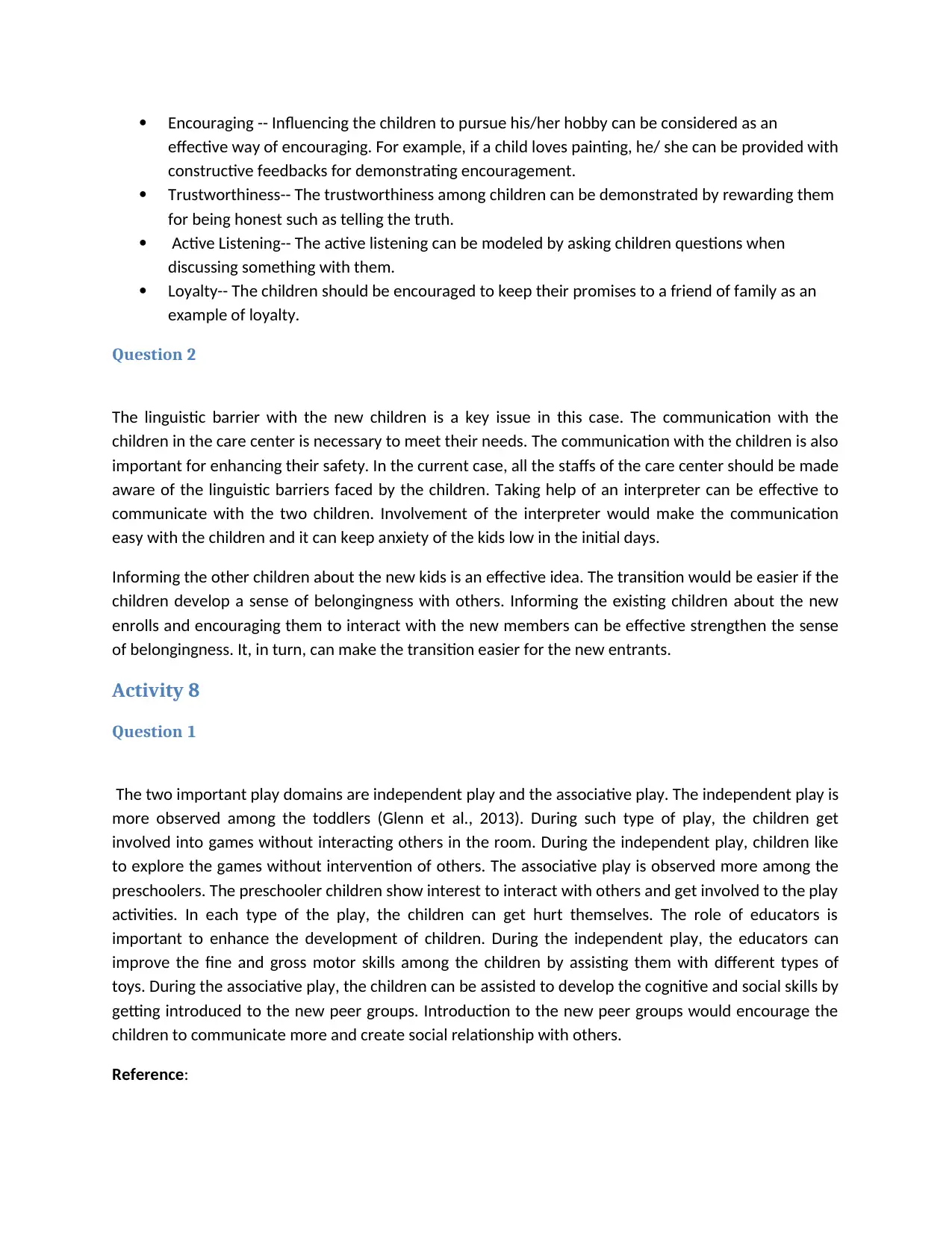
Encouraging -- Influencing the children to pursue his/her hobby can be considered as an
effective way of encouraging. For example, if a child loves painting, he/ she can be provided with
constructive feedbacks for demonstrating encouragement.
Trustworthiness-- The trustworthiness among children can be demonstrated by rewarding them
for being honest such as telling the truth.
Active Listening-- The active listening can be modeled by asking children questions when
discussing something with them.
Loyalty-- The children should be encouraged to keep their promises to a friend of family as an
example of loyalty.
Question 2
The linguistic barrier with the new children is a key issue in this case. The communication with the
children in the care center is necessary to meet their needs. The communication with the children is also
important for enhancing their safety. In the current case, all the staffs of the care center should be made
aware of the linguistic barriers faced by the children. Taking help of an interpreter can be effective to
communicate with the two children. Involvement of the interpreter would make the communication
easy with the children and it can keep anxiety of the kids low in the initial days.
Informing the other children about the new kids is an effective idea. The transition would be easier if the
children develop a sense of belongingness with others. Informing the existing children about the new
enrolls and encouraging them to interact with the new members can be effective strengthen the sense
of belongingness. It, in turn, can make the transition easier for the new entrants.
Activity 8
Question 1
The two important play domains are independent play and the associative play. The independent play is
more observed among the toddlers (Glenn et al., 2013). During such type of play, the children get
involved into games without interacting others in the room. During the independent play, children like
to explore the games without intervention of others. The associative play is observed more among the
preschoolers. The preschooler children show interest to interact with others and get involved to the play
activities. In each type of the play, the children can get hurt themselves. The role of educators is
important to enhance the development of children. During the independent play, the educators can
improve the fine and gross motor skills among the children by assisting them with different types of
toys. During the associative play, the children can be assisted to develop the cognitive and social skills by
getting introduced to the new peer groups. Introduction to the new peer groups would encourage the
children to communicate more and create social relationship with others.
Reference:
effective way of encouraging. For example, if a child loves painting, he/ she can be provided with
constructive feedbacks for demonstrating encouragement.
Trustworthiness-- The trustworthiness among children can be demonstrated by rewarding them
for being honest such as telling the truth.
Active Listening-- The active listening can be modeled by asking children questions when
discussing something with them.
Loyalty-- The children should be encouraged to keep their promises to a friend of family as an
example of loyalty.
Question 2
The linguistic barrier with the new children is a key issue in this case. The communication with the
children in the care center is necessary to meet their needs. The communication with the children is also
important for enhancing their safety. In the current case, all the staffs of the care center should be made
aware of the linguistic barriers faced by the children. Taking help of an interpreter can be effective to
communicate with the two children. Involvement of the interpreter would make the communication
easy with the children and it can keep anxiety of the kids low in the initial days.
Informing the other children about the new kids is an effective idea. The transition would be easier if the
children develop a sense of belongingness with others. Informing the existing children about the new
enrolls and encouraging them to interact with the new members can be effective strengthen the sense
of belongingness. It, in turn, can make the transition easier for the new entrants.
Activity 8
Question 1
The two important play domains are independent play and the associative play. The independent play is
more observed among the toddlers (Glenn et al., 2013). During such type of play, the children get
involved into games without interacting others in the room. During the independent play, children like
to explore the games without intervention of others. The associative play is observed more among the
preschoolers. The preschooler children show interest to interact with others and get involved to the play
activities. In each type of the play, the children can get hurt themselves. The role of educators is
important to enhance the development of children. During the independent play, the educators can
improve the fine and gross motor skills among the children by assisting them with different types of
toys. During the associative play, the children can be assisted to develop the cognitive and social skills by
getting introduced to the new peer groups. Introduction to the new peer groups would encourage the
children to communicate more and create social relationship with others.
Reference:
Paraphrase This Document
Need a fresh take? Get an instant paraphrase of this document with our AI Paraphraser
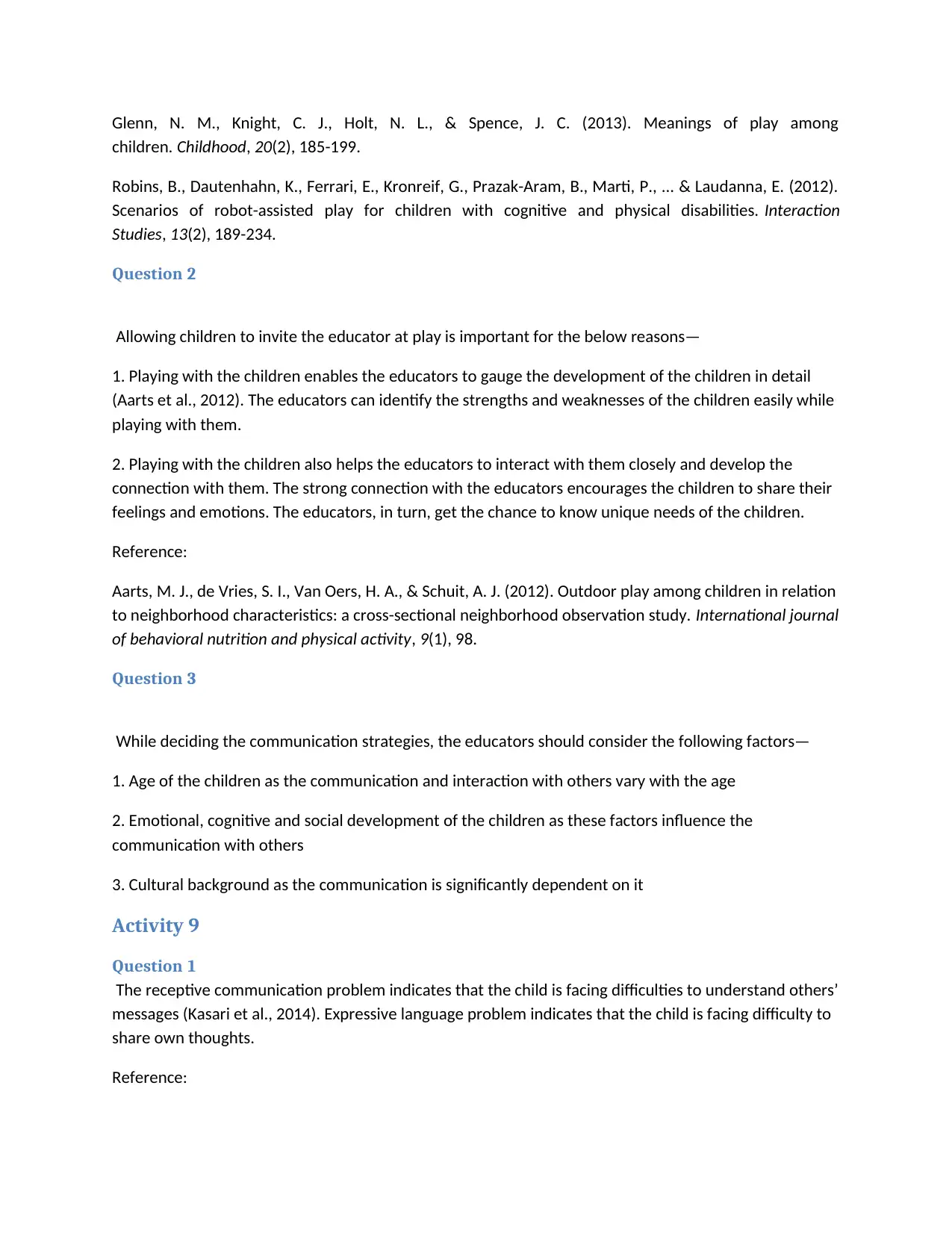
Glenn, N. M., Knight, C. J., Holt, N. L., & Spence, J. C. (2013). Meanings of play among
children. Childhood, 20(2), 185-199.
Robins, B., Dautenhahn, K., Ferrari, E., Kronreif, G., Prazak-Aram, B., Marti, P., ... & Laudanna, E. (2012).
Scenarios of robot-assisted play for children with cognitive and physical disabilities. Interaction
Studies, 13(2), 189-234.
Question 2
Allowing children to invite the educator at play is important for the below reasons—
1. Playing with the children enables the educators to gauge the development of the children in detail
(Aarts et al., 2012). The educators can identify the strengths and weaknesses of the children easily while
playing with them.
2. Playing with the children also helps the educators to interact with them closely and develop the
connection with them. The strong connection with the educators encourages the children to share their
feelings and emotions. The educators, in turn, get the chance to know unique needs of the children.
Reference:
Aarts, M. J., de Vries, S. I., Van Oers, H. A., & Schuit, A. J. (2012). Outdoor play among children in relation
to neighborhood characteristics: a cross-sectional neighborhood observation study. International journal
of behavioral nutrition and physical activity, 9(1), 98.
Question 3
While deciding the communication strategies, the educators should consider the following factors—
1. Age of the children as the communication and interaction with others vary with the age
2. Emotional, cognitive and social development of the children as these factors influence the
communication with others
3. Cultural background as the communication is significantly dependent on it
Activity 9
Question 1
The receptive communication problem indicates that the child is facing difficulties to understand others’
messages (Kasari et al., 2014). Expressive language problem indicates that the child is facing difficulty to
share own thoughts.
Reference:
children. Childhood, 20(2), 185-199.
Robins, B., Dautenhahn, K., Ferrari, E., Kronreif, G., Prazak-Aram, B., Marti, P., ... & Laudanna, E. (2012).
Scenarios of robot-assisted play for children with cognitive and physical disabilities. Interaction
Studies, 13(2), 189-234.
Question 2
Allowing children to invite the educator at play is important for the below reasons—
1. Playing with the children enables the educators to gauge the development of the children in detail
(Aarts et al., 2012). The educators can identify the strengths and weaknesses of the children easily while
playing with them.
2. Playing with the children also helps the educators to interact with them closely and develop the
connection with them. The strong connection with the educators encourages the children to share their
feelings and emotions. The educators, in turn, get the chance to know unique needs of the children.
Reference:
Aarts, M. J., de Vries, S. I., Van Oers, H. A., & Schuit, A. J. (2012). Outdoor play among children in relation
to neighborhood characteristics: a cross-sectional neighborhood observation study. International journal
of behavioral nutrition and physical activity, 9(1), 98.
Question 3
While deciding the communication strategies, the educators should consider the following factors—
1. Age of the children as the communication and interaction with others vary with the age
2. Emotional, cognitive and social development of the children as these factors influence the
communication with others
3. Cultural background as the communication is significantly dependent on it
Activity 9
Question 1
The receptive communication problem indicates that the child is facing difficulties to understand others’
messages (Kasari et al., 2014). Expressive language problem indicates that the child is facing difficulty to
share own thoughts.
Reference:
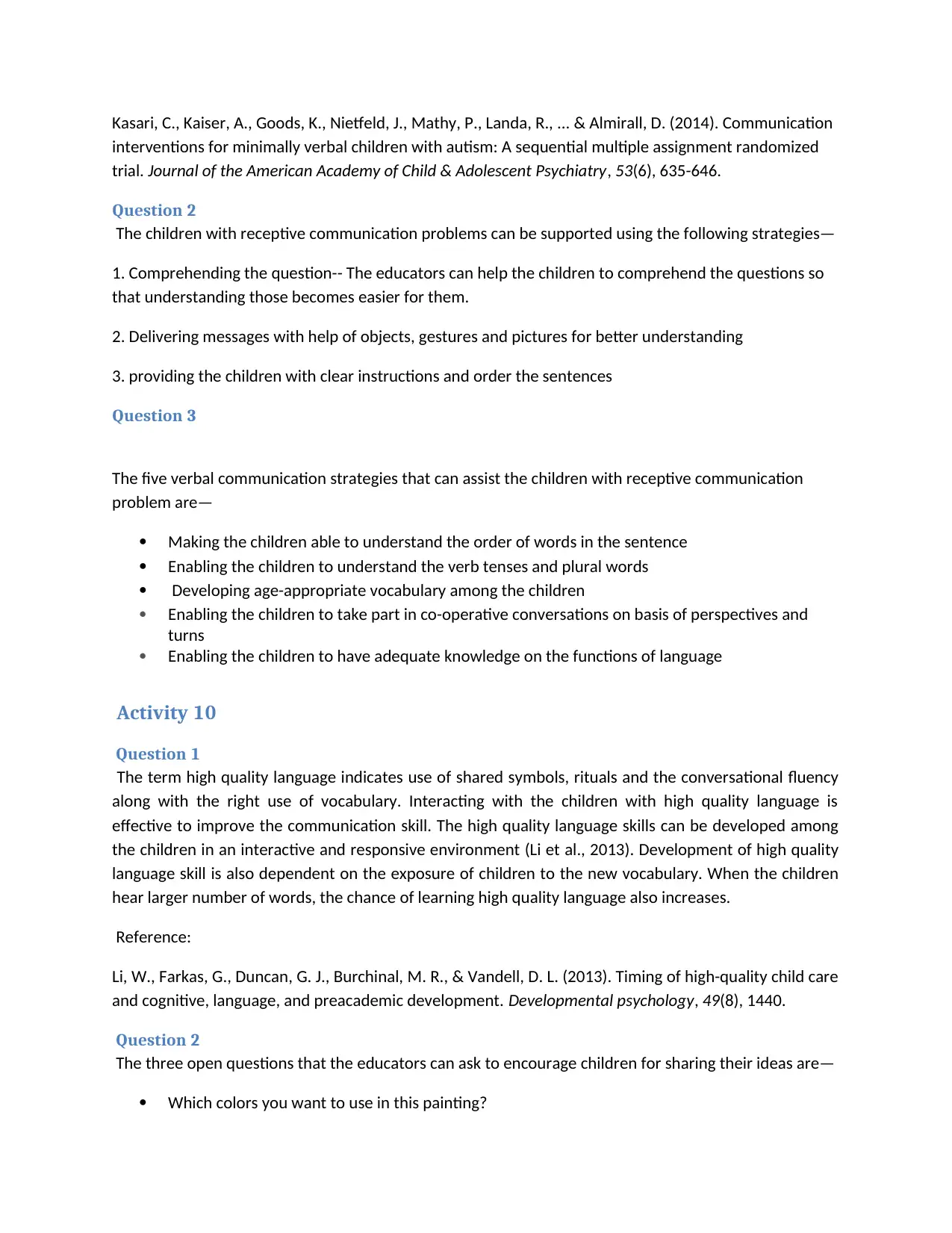
Kasari, C., Kaiser, A., Goods, K., Nietfeld, J., Mathy, P., Landa, R., ... & Almirall, D. (2014). Communication
interventions for minimally verbal children with autism: A sequential multiple assignment randomized
trial. Journal of the American Academy of Child & Adolescent Psychiatry, 53(6), 635-646.
Question 2
The children with receptive communication problems can be supported using the following strategies—
1. Comprehending the question-- The educators can help the children to comprehend the questions so
that understanding those becomes easier for them.
2. Delivering messages with help of objects, gestures and pictures for better understanding
3. providing the children with clear instructions and order the sentences
Question 3
The five verbal communication strategies that can assist the children with receptive communication
problem are—
Making the children able to understand the order of words in the sentence
Enabling the children to understand the verb tenses and plural words
Developing age-appropriate vocabulary among the children
Enabling the children to take part in co-operative conversations on basis of perspectives and
turns
Enabling the children to have adequate knowledge on the functions of language
Activity 10
Question 1
The term high quality language indicates use of shared symbols, rituals and the conversational fluency
along with the right use of vocabulary. Interacting with the children with high quality language is
effective to improve the communication skill. The high quality language skills can be developed among
the children in an interactive and responsive environment (Li et al., 2013). Development of high quality
language skill is also dependent on the exposure of children to the new vocabulary. When the children
hear larger number of words, the chance of learning high quality language also increases.
Reference:
Li, W., Farkas, G., Duncan, G. J., Burchinal, M. R., & Vandell, D. L. (2013). Timing of high-quality child care
and cognitive, language, and preacademic development. Developmental psychology, 49(8), 1440.
Question 2
The three open questions that the educators can ask to encourage children for sharing their ideas are—
Which colors you want to use in this painting?
interventions for minimally verbal children with autism: A sequential multiple assignment randomized
trial. Journal of the American Academy of Child & Adolescent Psychiatry, 53(6), 635-646.
Question 2
The children with receptive communication problems can be supported using the following strategies—
1. Comprehending the question-- The educators can help the children to comprehend the questions so
that understanding those becomes easier for them.
2. Delivering messages with help of objects, gestures and pictures for better understanding
3. providing the children with clear instructions and order the sentences
Question 3
The five verbal communication strategies that can assist the children with receptive communication
problem are—
Making the children able to understand the order of words in the sentence
Enabling the children to understand the verb tenses and plural words
Developing age-appropriate vocabulary among the children
Enabling the children to take part in co-operative conversations on basis of perspectives and
turns
Enabling the children to have adequate knowledge on the functions of language
Activity 10
Question 1
The term high quality language indicates use of shared symbols, rituals and the conversational fluency
along with the right use of vocabulary. Interacting with the children with high quality language is
effective to improve the communication skill. The high quality language skills can be developed among
the children in an interactive and responsive environment (Li et al., 2013). Development of high quality
language skill is also dependent on the exposure of children to the new vocabulary. When the children
hear larger number of words, the chance of learning high quality language also increases.
Reference:
Li, W., Farkas, G., Duncan, G. J., Burchinal, M. R., & Vandell, D. L. (2013). Timing of high-quality child care
and cognitive, language, and preacademic development. Developmental psychology, 49(8), 1440.
Question 2
The three open questions that the educators can ask to encourage children for sharing their ideas are—
Which colors you want to use in this painting?
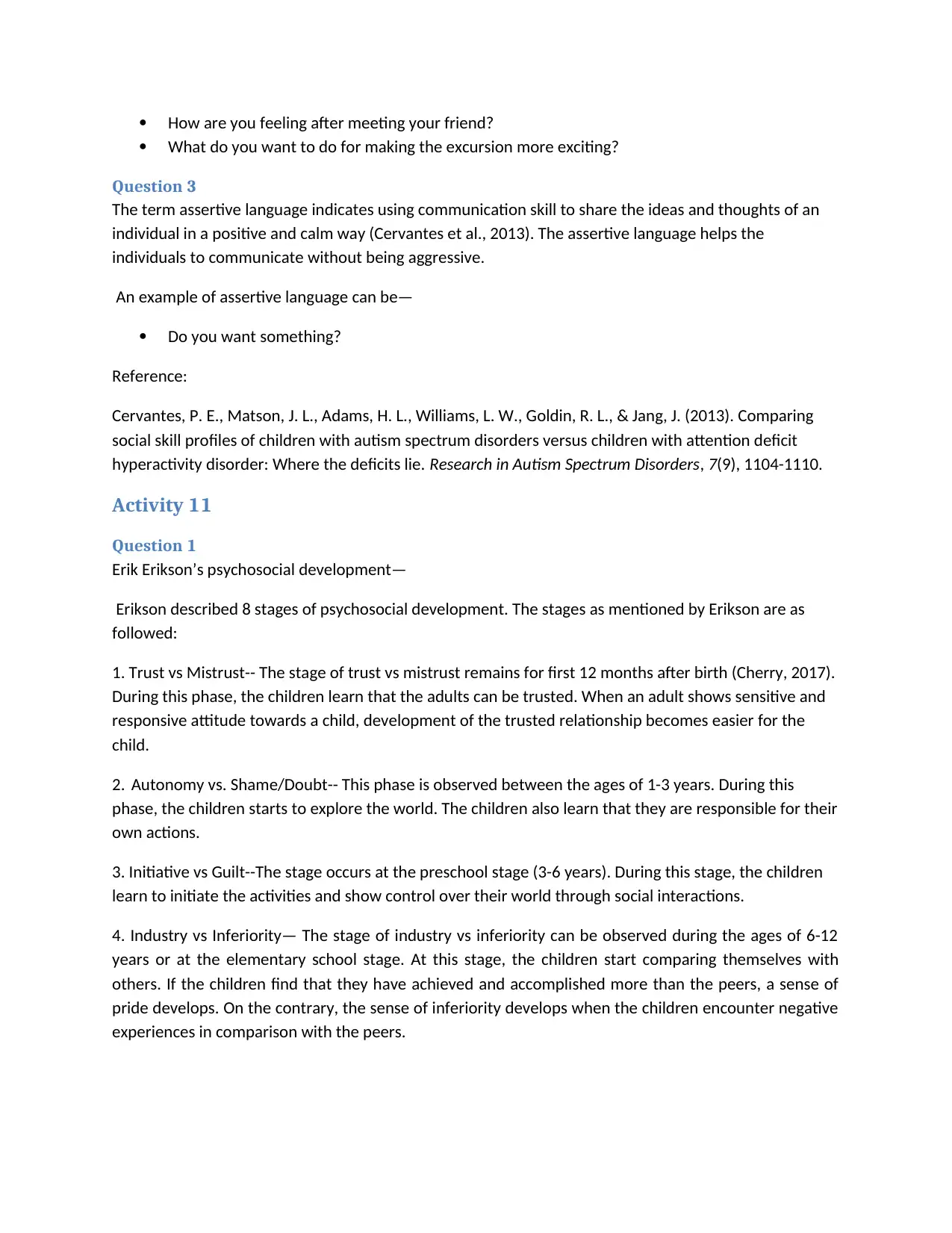
How are you feeling after meeting your friend?
What do you want to do for making the excursion more exciting?
Question 3
The term assertive language indicates using communication skill to share the ideas and thoughts of an
individual in a positive and calm way (Cervantes et al., 2013). The assertive language helps the
individuals to communicate without being aggressive.
An example of assertive language can be—
Do you want something?
Reference:
Cervantes, P. E., Matson, J. L., Adams, H. L., Williams, L. W., Goldin, R. L., & Jang, J. (2013). Comparing
social skill profiles of children with autism spectrum disorders versus children with attention deficit
hyperactivity disorder: Where the deficits lie. Research in Autism Spectrum Disorders, 7(9), 1104-1110.
Activity 11
Question 1
Erik Erikson’s psychosocial development—
Erikson described 8 stages of psychosocial development. The stages as mentioned by Erikson are as
followed:
1. Trust vs Mistrust-- The stage of trust vs mistrust remains for first 12 months after birth (Cherry, 2017).
During this phase, the children learn that the adults can be trusted. When an adult shows sensitive and
responsive attitude towards a child, development of the trusted relationship becomes easier for the
child.
2. Autonomy vs. Shame/Doubt-- This phase is observed between the ages of 1-3 years. During this
phase, the children starts to explore the world. The children also learn that they are responsible for their
own actions.
3. Initiative vs Guilt--The stage occurs at the preschool stage (3-6 years). During this stage, the children
learn to initiate the activities and show control over their world through social interactions.
4. Industry vs Inferiority— The stage of industry vs inferiority can be observed during the ages of 6-12
years or at the elementary school stage. At this stage, the children start comparing themselves with
others. If the children find that they have achieved and accomplished more than the peers, a sense of
pride develops. On the contrary, the sense of inferiority develops when the children encounter negative
experiences in comparison with the peers.
What do you want to do for making the excursion more exciting?
Question 3
The term assertive language indicates using communication skill to share the ideas and thoughts of an
individual in a positive and calm way (Cervantes et al., 2013). The assertive language helps the
individuals to communicate without being aggressive.
An example of assertive language can be—
Do you want something?
Reference:
Cervantes, P. E., Matson, J. L., Adams, H. L., Williams, L. W., Goldin, R. L., & Jang, J. (2013). Comparing
social skill profiles of children with autism spectrum disorders versus children with attention deficit
hyperactivity disorder: Where the deficits lie. Research in Autism Spectrum Disorders, 7(9), 1104-1110.
Activity 11
Question 1
Erik Erikson’s psychosocial development—
Erikson described 8 stages of psychosocial development. The stages as mentioned by Erikson are as
followed:
1. Trust vs Mistrust-- The stage of trust vs mistrust remains for first 12 months after birth (Cherry, 2017).
During this phase, the children learn that the adults can be trusted. When an adult shows sensitive and
responsive attitude towards a child, development of the trusted relationship becomes easier for the
child.
2. Autonomy vs. Shame/Doubt-- This phase is observed between the ages of 1-3 years. During this
phase, the children starts to explore the world. The children also learn that they are responsible for their
own actions.
3. Initiative vs Guilt--The stage occurs at the preschool stage (3-6 years). During this stage, the children
learn to initiate the activities and show control over their world through social interactions.
4. Industry vs Inferiority— The stage of industry vs inferiority can be observed during the ages of 6-12
years or at the elementary school stage. At this stage, the children start comparing themselves with
others. If the children find that they have achieved and accomplished more than the peers, a sense of
pride develops. On the contrary, the sense of inferiority develops when the children encounter negative
experiences in comparison with the peers.
Secure Best Marks with AI Grader
Need help grading? Try our AI Grader for instant feedback on your assignments.
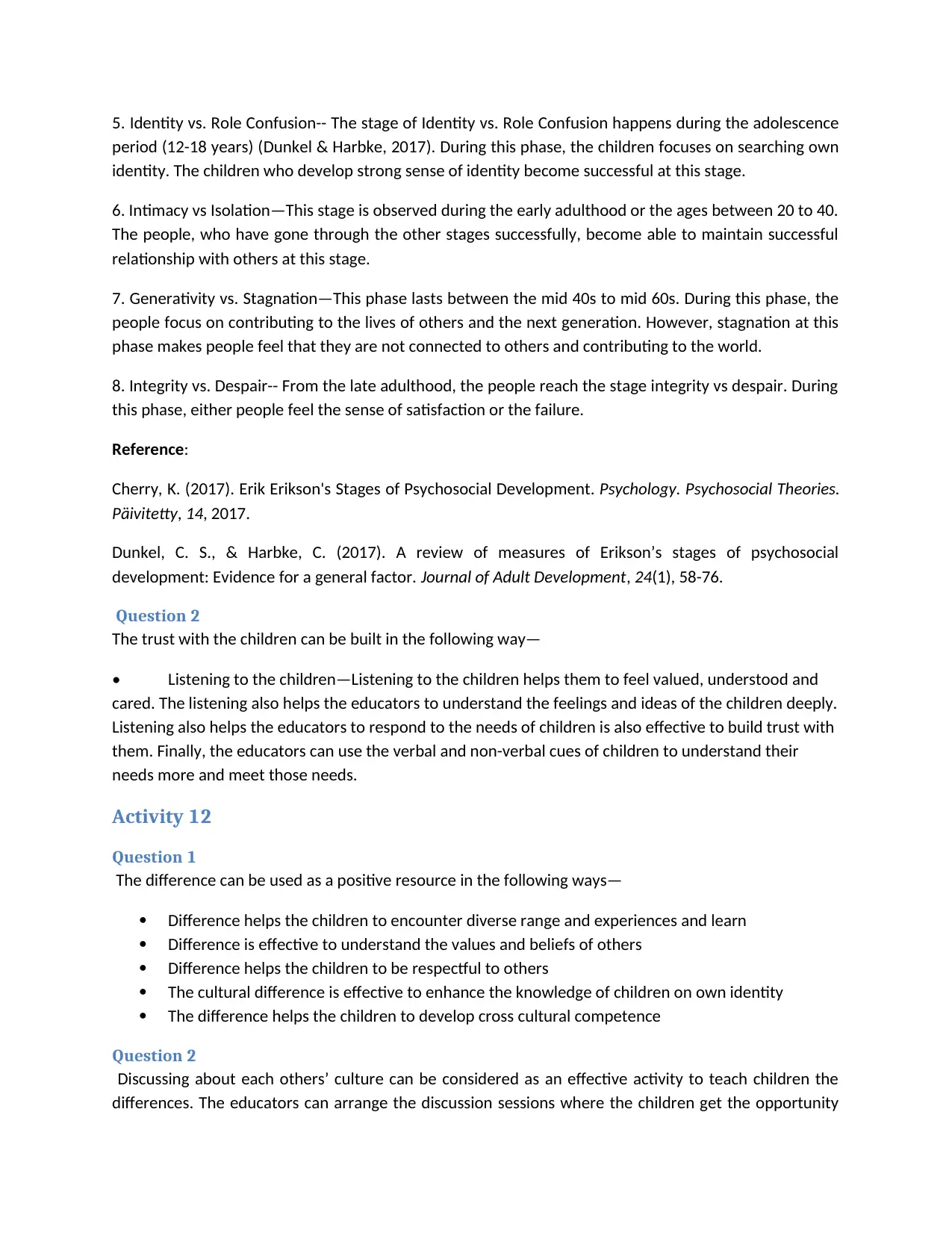
5. Identity vs. Role Confusion-- The stage of Identity vs. Role Confusion happens during the adolescence
period (12-18 years) (Dunkel & Harbke, 2017). During this phase, the children focuses on searching own
identity. The children who develop strong sense of identity become successful at this stage.
6. Intimacy vs Isolation—This stage is observed during the early adulthood or the ages between 20 to 40.
The people, who have gone through the other stages successfully, become able to maintain successful
relationship with others at this stage.
7. Generativity vs. Stagnation—This phase lasts between the mid 40s to mid 60s. During this phase, the
people focus on contributing to the lives of others and the next generation. However, stagnation at this
phase makes people feel that they are not connected to others and contributing to the world.
8. Integrity vs. Despair-- From the late adulthood, the people reach the stage integrity vs despair. During
this phase, either people feel the sense of satisfaction or the failure.
Reference:
Cherry, K. (2017). Erik Erikson's Stages of Psychosocial Development. Psychology. Psychosocial Theories.
Päivitetty, 14, 2017.
Dunkel, C. S., & Harbke, C. (2017). A review of measures of Erikson’s stages of psychosocial
development: Evidence for a general factor. Journal of Adult Development, 24(1), 58-76.
Question 2
The trust with the children can be built in the following way—
• Listening to the children—Listening to the children helps them to feel valued, understood and
cared. The listening also helps the educators to understand the feelings and ideas of the children deeply.
Listening also helps the educators to respond to the needs of children is also effective to build trust with
them. Finally, the educators can use the verbal and non-verbal cues of children to understand their
needs more and meet those needs.
Activity 12
Question 1
The difference can be used as a positive resource in the following ways—
Difference helps the children to encounter diverse range and experiences and learn
Difference is effective to understand the values and beliefs of others
Difference helps the children to be respectful to others
The cultural difference is effective to enhance the knowledge of children on own identity
The difference helps the children to develop cross cultural competence
Question 2
Discussing about each others’ culture can be considered as an effective activity to teach children the
differences. The educators can arrange the discussion sessions where the children get the opportunity
period (12-18 years) (Dunkel & Harbke, 2017). During this phase, the children focuses on searching own
identity. The children who develop strong sense of identity become successful at this stage.
6. Intimacy vs Isolation—This stage is observed during the early adulthood or the ages between 20 to 40.
The people, who have gone through the other stages successfully, become able to maintain successful
relationship with others at this stage.
7. Generativity vs. Stagnation—This phase lasts between the mid 40s to mid 60s. During this phase, the
people focus on contributing to the lives of others and the next generation. However, stagnation at this
phase makes people feel that they are not connected to others and contributing to the world.
8. Integrity vs. Despair-- From the late adulthood, the people reach the stage integrity vs despair. During
this phase, either people feel the sense of satisfaction or the failure.
Reference:
Cherry, K. (2017). Erik Erikson's Stages of Psychosocial Development. Psychology. Psychosocial Theories.
Päivitetty, 14, 2017.
Dunkel, C. S., & Harbke, C. (2017). A review of measures of Erikson’s stages of psychosocial
development: Evidence for a general factor. Journal of Adult Development, 24(1), 58-76.
Question 2
The trust with the children can be built in the following way—
• Listening to the children—Listening to the children helps them to feel valued, understood and
cared. The listening also helps the educators to understand the feelings and ideas of the children deeply.
Listening also helps the educators to respond to the needs of children is also effective to build trust with
them. Finally, the educators can use the verbal and non-verbal cues of children to understand their
needs more and meet those needs.
Activity 12
Question 1
The difference can be used as a positive resource in the following ways—
Difference helps the children to encounter diverse range and experiences and learn
Difference is effective to understand the values and beliefs of others
Difference helps the children to be respectful to others
The cultural difference is effective to enhance the knowledge of children on own identity
The difference helps the children to develop cross cultural competence
Question 2
Discussing about each others’ culture can be considered as an effective activity to teach children the
differences. The educators can arrange the discussion sessions where the children get the opportunity
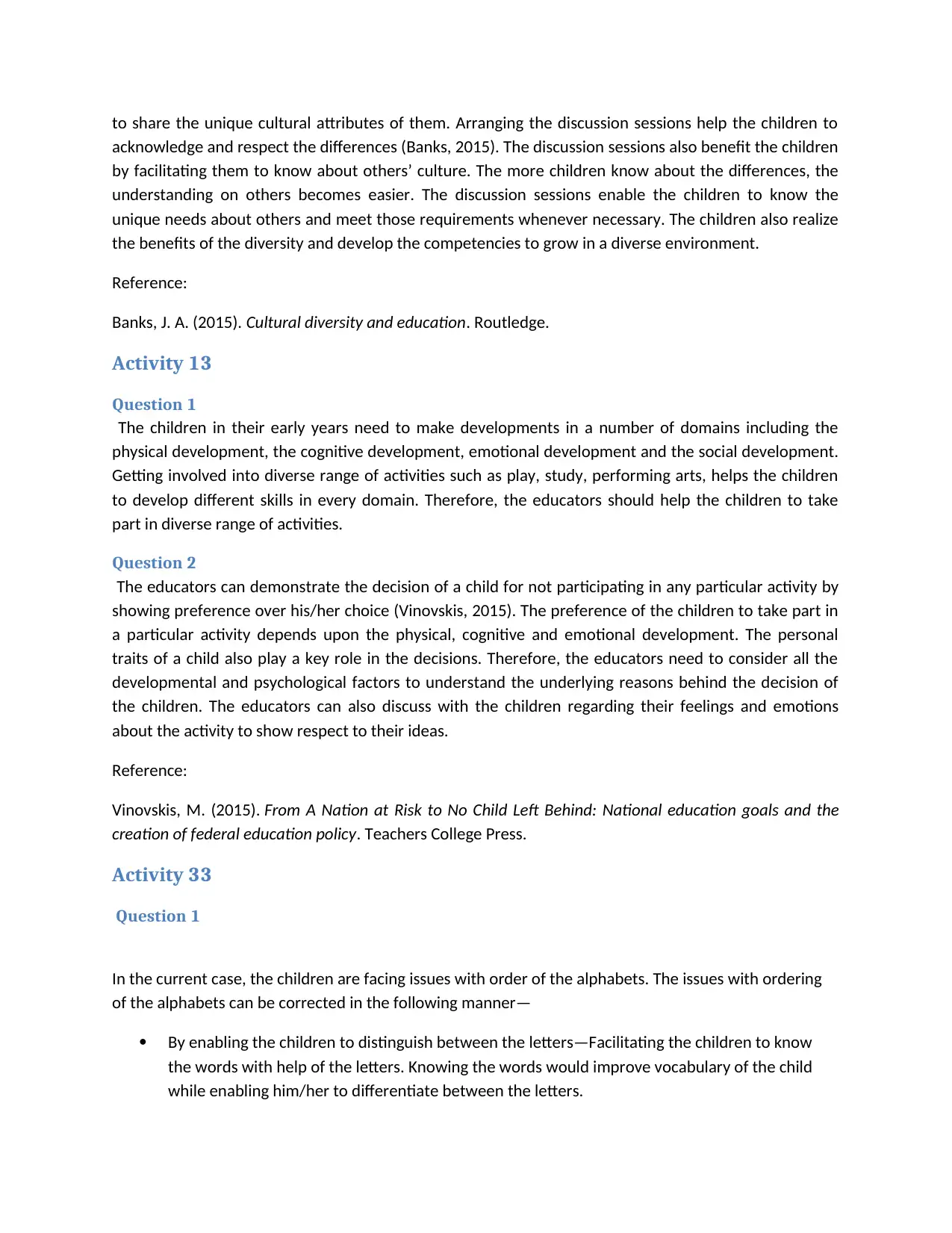
to share the unique cultural attributes of them. Arranging the discussion sessions help the children to
acknowledge and respect the differences (Banks, 2015). The discussion sessions also benefit the children
by facilitating them to know about others’ culture. The more children know about the differences, the
understanding on others becomes easier. The discussion sessions enable the children to know the
unique needs about others and meet those requirements whenever necessary. The children also realize
the benefits of the diversity and develop the competencies to grow in a diverse environment.
Reference:
Banks, J. A. (2015). Cultural diversity and education. Routledge.
Activity 13
Question 1
The children in their early years need to make developments in a number of domains including the
physical development, the cognitive development, emotional development and the social development.
Getting involved into diverse range of activities such as play, study, performing arts, helps the children
to develop different skills in every domain. Therefore, the educators should help the children to take
part in diverse range of activities.
Question 2
The educators can demonstrate the decision of a child for not participating in any particular activity by
showing preference over his/her choice (Vinovskis, 2015). The preference of the children to take part in
a particular activity depends upon the physical, cognitive and emotional development. The personal
traits of a child also play a key role in the decisions. Therefore, the educators need to consider all the
developmental and psychological factors to understand the underlying reasons behind the decision of
the children. The educators can also discuss with the children regarding their feelings and emotions
about the activity to show respect to their ideas.
Reference:
Vinovskis, M. (2015). From A Nation at Risk to No Child Left Behind: National education goals and the
creation of federal education policy. Teachers College Press.
Activity 33
Question 1
In the current case, the children are facing issues with order of the alphabets. The issues with ordering
of the alphabets can be corrected in the following manner—
By enabling the children to distinguish between the letters—Facilitating the children to know
the words with help of the letters. Knowing the words would improve vocabulary of the child
while enabling him/her to differentiate between the letters.
acknowledge and respect the differences (Banks, 2015). The discussion sessions also benefit the children
by facilitating them to know about others’ culture. The more children know about the differences, the
understanding on others becomes easier. The discussion sessions enable the children to know the
unique needs about others and meet those requirements whenever necessary. The children also realize
the benefits of the diversity and develop the competencies to grow in a diverse environment.
Reference:
Banks, J. A. (2015). Cultural diversity and education. Routledge.
Activity 13
Question 1
The children in their early years need to make developments in a number of domains including the
physical development, the cognitive development, emotional development and the social development.
Getting involved into diverse range of activities such as play, study, performing arts, helps the children
to develop different skills in every domain. Therefore, the educators should help the children to take
part in diverse range of activities.
Question 2
The educators can demonstrate the decision of a child for not participating in any particular activity by
showing preference over his/her choice (Vinovskis, 2015). The preference of the children to take part in
a particular activity depends upon the physical, cognitive and emotional development. The personal
traits of a child also play a key role in the decisions. Therefore, the educators need to consider all the
developmental and psychological factors to understand the underlying reasons behind the decision of
the children. The educators can also discuss with the children regarding their feelings and emotions
about the activity to show respect to their ideas.
Reference:
Vinovskis, M. (2015). From A Nation at Risk to No Child Left Behind: National education goals and the
creation of federal education policy. Teachers College Press.
Activity 33
Question 1
In the current case, the children are facing issues with order of the alphabets. The issues with ordering
of the alphabets can be corrected in the following manner—
By enabling the children to distinguish between the letters—Facilitating the children to know
the words with help of the letters. Knowing the words would improve vocabulary of the child
while enabling him/her to differentiate between the letters.
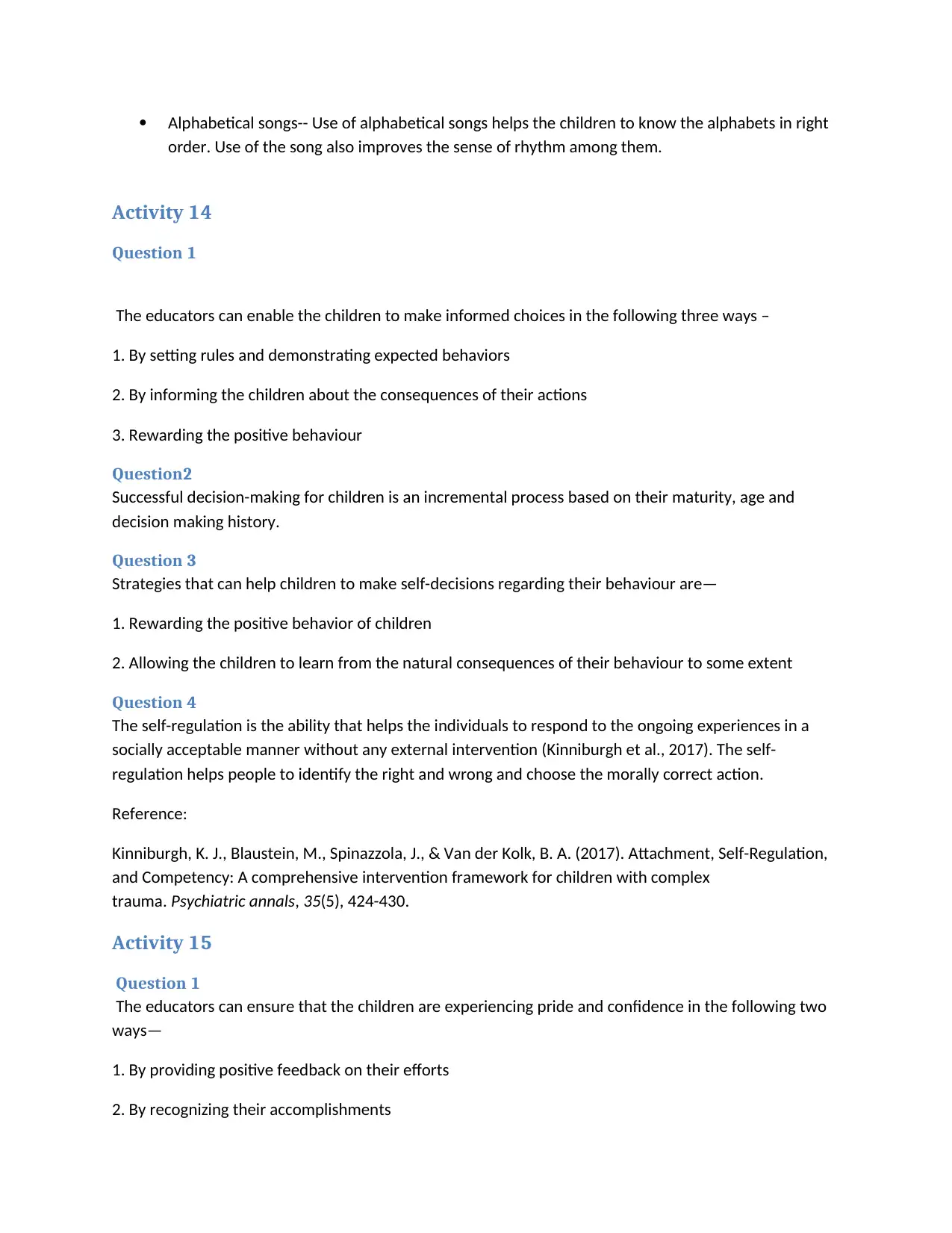
Alphabetical songs-- Use of alphabetical songs helps the children to know the alphabets in right
order. Use of the song also improves the sense of rhythm among them.
Activity 14
Question 1
The educators can enable the children to make informed choices in the following three ways –
1. By setting rules and demonstrating expected behaviors
2. By informing the children about the consequences of their actions
3. Rewarding the positive behaviour
Question2
Successful decision-making for children is an incremental process based on their maturity, age and
decision making history.
Question 3
Strategies that can help children to make self-decisions regarding their behaviour are—
1. Rewarding the positive behavior of children
2. Allowing the children to learn from the natural consequences of their behaviour to some extent
Question 4
The self-regulation is the ability that helps the individuals to respond to the ongoing experiences in a
socially acceptable manner without any external intervention (Kinniburgh et al., 2017). The self-
regulation helps people to identify the right and wrong and choose the morally correct action.
Reference:
Kinniburgh, K. J., Blaustein, M., Spinazzola, J., & Van der Kolk, B. A. (2017). Attachment, Self-Regulation,
and Competency: A comprehensive intervention framework for children with complex
trauma. Psychiatric annals, 35(5), 424-430.
Activity 15
Question 1
The educators can ensure that the children are experiencing pride and confidence in the following two
ways—
1. By providing positive feedback on their efforts
2. By recognizing their accomplishments
order. Use of the song also improves the sense of rhythm among them.
Activity 14
Question 1
The educators can enable the children to make informed choices in the following three ways –
1. By setting rules and demonstrating expected behaviors
2. By informing the children about the consequences of their actions
3. Rewarding the positive behaviour
Question2
Successful decision-making for children is an incremental process based on their maturity, age and
decision making history.
Question 3
Strategies that can help children to make self-decisions regarding their behaviour are—
1. Rewarding the positive behavior of children
2. Allowing the children to learn from the natural consequences of their behaviour to some extent
Question 4
The self-regulation is the ability that helps the individuals to respond to the ongoing experiences in a
socially acceptable manner without any external intervention (Kinniburgh et al., 2017). The self-
regulation helps people to identify the right and wrong and choose the morally correct action.
Reference:
Kinniburgh, K. J., Blaustein, M., Spinazzola, J., & Van der Kolk, B. A. (2017). Attachment, Self-Regulation,
and Competency: A comprehensive intervention framework for children with complex
trauma. Psychiatric annals, 35(5), 424-430.
Activity 15
Question 1
The educators can ensure that the children are experiencing pride and confidence in the following two
ways—
1. By providing positive feedback on their efforts
2. By recognizing their accomplishments
Paraphrase This Document
Need a fresh take? Get an instant paraphrase of this document with our AI Paraphraser
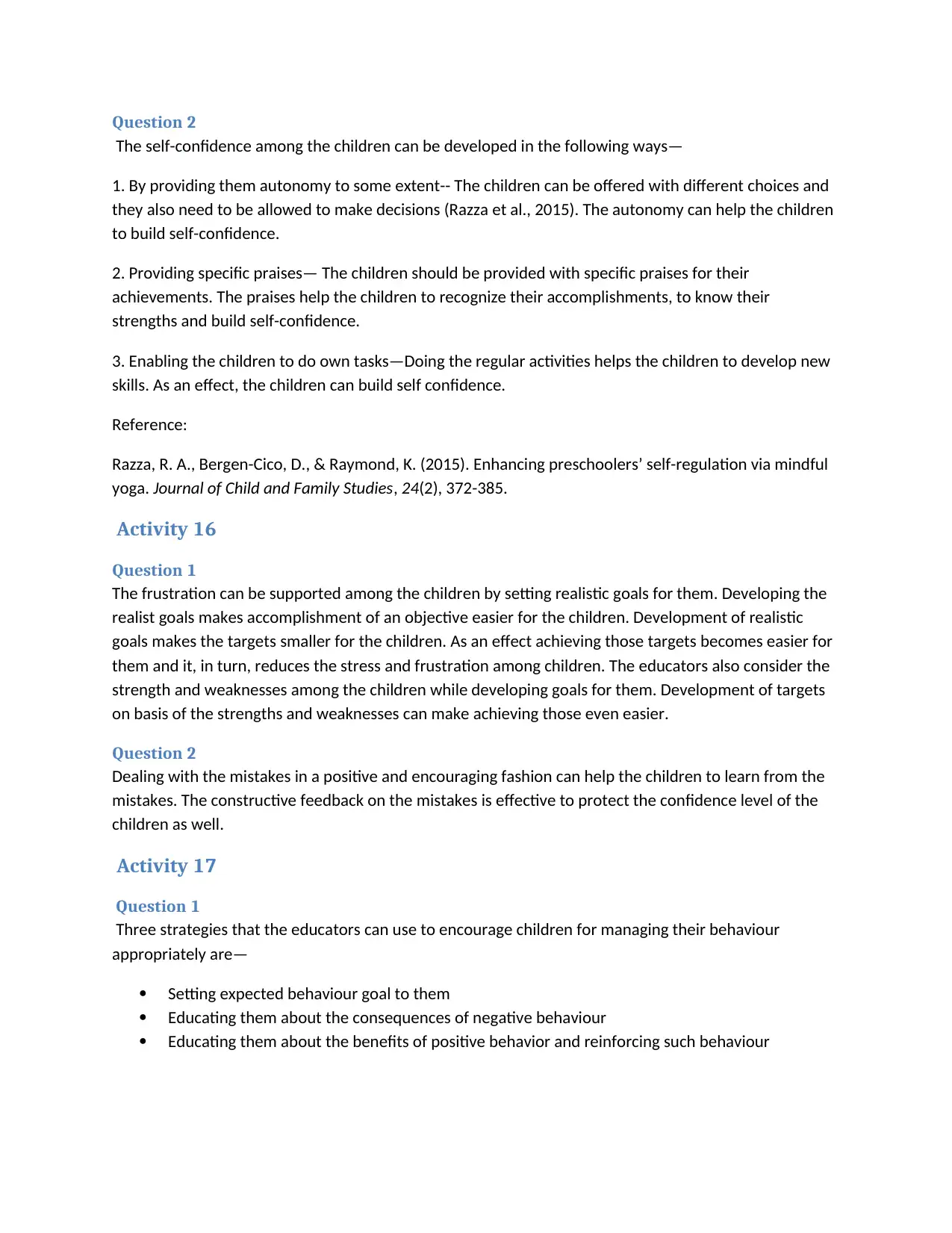
Question 2
The self-confidence among the children can be developed in the following ways—
1. By providing them autonomy to some extent-- The children can be offered with different choices and
they also need to be allowed to make decisions (Razza et al., 2015). The autonomy can help the children
to build self-confidence.
2. Providing specific praises— The children should be provided with specific praises for their
achievements. The praises help the children to recognize their accomplishments, to know their
strengths and build self-confidence.
3. Enabling the children to do own tasks—Doing the regular activities helps the children to develop new
skills. As an effect, the children can build self confidence.
Reference:
Razza, R. A., Bergen-Cico, D., & Raymond, K. (2015). Enhancing preschoolers’ self-regulation via mindful
yoga. Journal of Child and Family Studies, 24(2), 372-385.
Activity 16
Question 1
The frustration can be supported among the children by setting realistic goals for them. Developing the
realist goals makes accomplishment of an objective easier for the children. Development of realistic
goals makes the targets smaller for the children. As an effect achieving those targets becomes easier for
them and it, in turn, reduces the stress and frustration among children. The educators also consider the
strength and weaknesses among the children while developing goals for them. Development of targets
on basis of the strengths and weaknesses can make achieving those even easier.
Question 2
Dealing with the mistakes in a positive and encouraging fashion can help the children to learn from the
mistakes. The constructive feedback on the mistakes is effective to protect the confidence level of the
children as well.
Activity 17
Question 1
Three strategies that the educators can use to encourage children for managing their behaviour
appropriately are—
Setting expected behaviour goal to them
Educating them about the consequences of negative behaviour
Educating them about the benefits of positive behavior and reinforcing such behaviour
The self-confidence among the children can be developed in the following ways—
1. By providing them autonomy to some extent-- The children can be offered with different choices and
they also need to be allowed to make decisions (Razza et al., 2015). The autonomy can help the children
to build self-confidence.
2. Providing specific praises— The children should be provided with specific praises for their
achievements. The praises help the children to recognize their accomplishments, to know their
strengths and build self-confidence.
3. Enabling the children to do own tasks—Doing the regular activities helps the children to develop new
skills. As an effect, the children can build self confidence.
Reference:
Razza, R. A., Bergen-Cico, D., & Raymond, K. (2015). Enhancing preschoolers’ self-regulation via mindful
yoga. Journal of Child and Family Studies, 24(2), 372-385.
Activity 16
Question 1
The frustration can be supported among the children by setting realistic goals for them. Developing the
realist goals makes accomplishment of an objective easier for the children. Development of realistic
goals makes the targets smaller for the children. As an effect achieving those targets becomes easier for
them and it, in turn, reduces the stress and frustration among children. The educators also consider the
strength and weaknesses among the children while developing goals for them. Development of targets
on basis of the strengths and weaknesses can make achieving those even easier.
Question 2
Dealing with the mistakes in a positive and encouraging fashion can help the children to learn from the
mistakes. The constructive feedback on the mistakes is effective to protect the confidence level of the
children as well.
Activity 17
Question 1
Three strategies that the educators can use to encourage children for managing their behaviour
appropriately are—
Setting expected behaviour goal to them
Educating them about the consequences of negative behaviour
Educating them about the benefits of positive behavior and reinforcing such behaviour
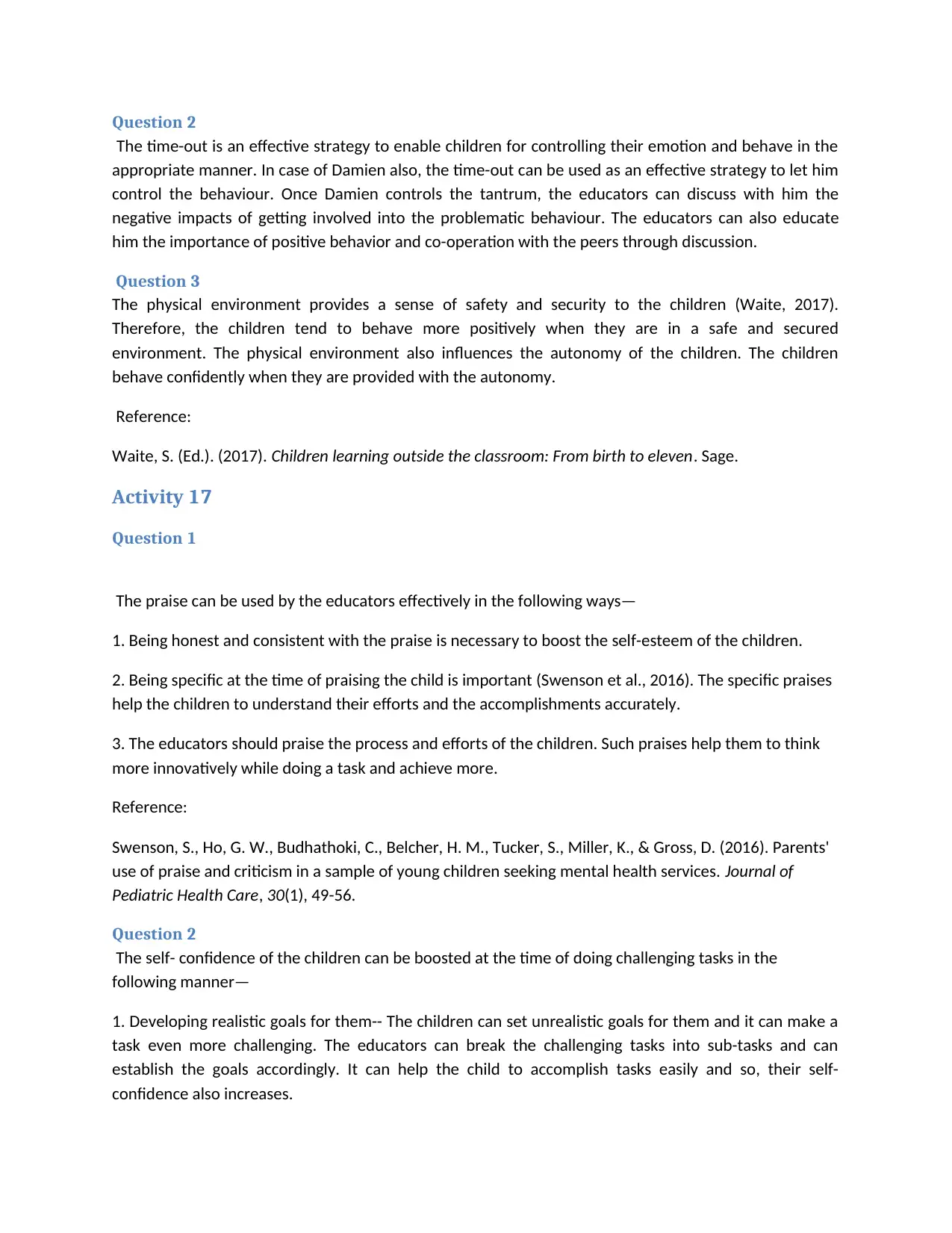
Question 2
The time-out is an effective strategy to enable children for controlling their emotion and behave in the
appropriate manner. In case of Damien also, the time-out can be used as an effective strategy to let him
control the behaviour. Once Damien controls the tantrum, the educators can discuss with him the
negative impacts of getting involved into the problematic behaviour. The educators can also educate
him the importance of positive behavior and co-operation with the peers through discussion.
Question 3
The physical environment provides a sense of safety and security to the children (Waite, 2017).
Therefore, the children tend to behave more positively when they are in a safe and secured
environment. The physical environment also influences the autonomy of the children. The children
behave confidently when they are provided with the autonomy.
Reference:
Waite, S. (Ed.). (2017). Children learning outside the classroom: From birth to eleven. Sage.
Activity 17
Question 1
The praise can be used by the educators effectively in the following ways—
1. Being honest and consistent with the praise is necessary to boost the self-esteem of the children.
2. Being specific at the time of praising the child is important (Swenson et al., 2016). The specific praises
help the children to understand their efforts and the accomplishments accurately.
3. The educators should praise the process and efforts of the children. Such praises help them to think
more innovatively while doing a task and achieve more.
Reference:
Swenson, S., Ho, G. W., Budhathoki, C., Belcher, H. M., Tucker, S., Miller, K., & Gross, D. (2016). Parents'
use of praise and criticism in a sample of young children seeking mental health services. Journal of
Pediatric Health Care, 30(1), 49-56.
Question 2
The self- confidence of the children can be boosted at the time of doing challenging tasks in the
following manner—
1. Developing realistic goals for them-- The children can set unrealistic goals for them and it can make a
task even more challenging. The educators can break the challenging tasks into sub-tasks and can
establish the goals accordingly. It can help the child to accomplish tasks easily and so, their self-
confidence also increases.
The time-out is an effective strategy to enable children for controlling their emotion and behave in the
appropriate manner. In case of Damien also, the time-out can be used as an effective strategy to let him
control the behaviour. Once Damien controls the tantrum, the educators can discuss with him the
negative impacts of getting involved into the problematic behaviour. The educators can also educate
him the importance of positive behavior and co-operation with the peers through discussion.
Question 3
The physical environment provides a sense of safety and security to the children (Waite, 2017).
Therefore, the children tend to behave more positively when they are in a safe and secured
environment. The physical environment also influences the autonomy of the children. The children
behave confidently when they are provided with the autonomy.
Reference:
Waite, S. (Ed.). (2017). Children learning outside the classroom: From birth to eleven. Sage.
Activity 17
Question 1
The praise can be used by the educators effectively in the following ways—
1. Being honest and consistent with the praise is necessary to boost the self-esteem of the children.
2. Being specific at the time of praising the child is important (Swenson et al., 2016). The specific praises
help the children to understand their efforts and the accomplishments accurately.
3. The educators should praise the process and efforts of the children. Such praises help them to think
more innovatively while doing a task and achieve more.
Reference:
Swenson, S., Ho, G. W., Budhathoki, C., Belcher, H. M., Tucker, S., Miller, K., & Gross, D. (2016). Parents'
use of praise and criticism in a sample of young children seeking mental health services. Journal of
Pediatric Health Care, 30(1), 49-56.
Question 2
The self- confidence of the children can be boosted at the time of doing challenging tasks in the
following manner—
1. Developing realistic goals for them-- The children can set unrealistic goals for them and it can make a
task even more challenging. The educators can break the challenging tasks into sub-tasks and can
establish the goals accordingly. It can help the child to accomplish tasks easily and so, their self-
confidence also increases.
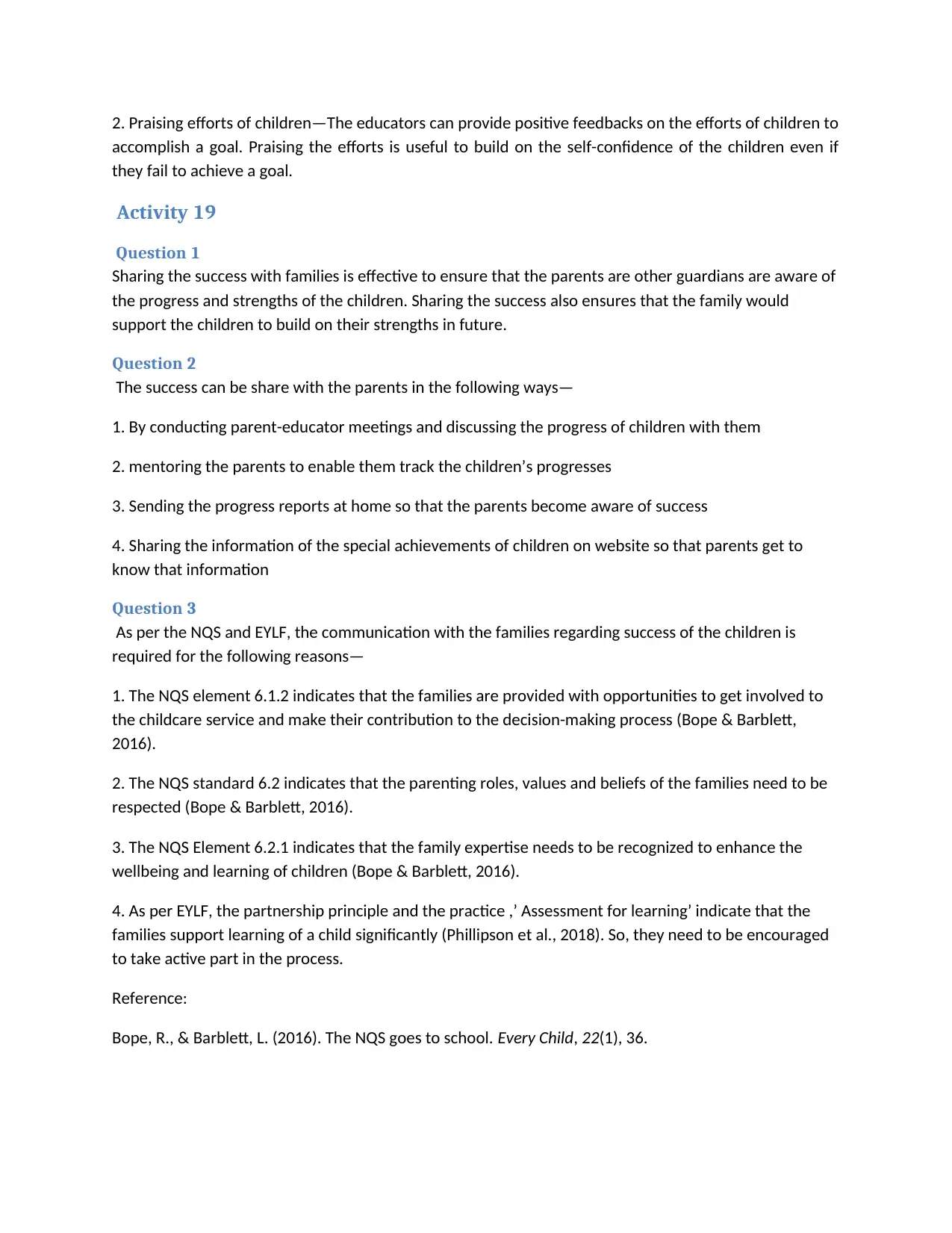
2. Praising efforts of children—The educators can provide positive feedbacks on the efforts of children to
accomplish a goal. Praising the efforts is useful to build on the self-confidence of the children even if
they fail to achieve a goal.
Activity 19
Question 1
Sharing the success with families is effective to ensure that the parents are other guardians are aware of
the progress and strengths of the children. Sharing the success also ensures that the family would
support the children to build on their strengths in future.
Question 2
The success can be share with the parents in the following ways—
1. By conducting parent-educator meetings and discussing the progress of children with them
2. mentoring the parents to enable them track the children’s progresses
3. Sending the progress reports at home so that the parents become aware of success
4. Sharing the information of the special achievements of children on website so that parents get to
know that information
Question 3
As per the NQS and EYLF, the communication with the families regarding success of the children is
required for the following reasons—
1. The NQS element 6.1.2 indicates that the families are provided with opportunities to get involved to
the childcare service and make their contribution to the decision-making process (Bope & Barblett,
2016).
2. The NQS standard 6.2 indicates that the parenting roles, values and beliefs of the families need to be
respected (Bope & Barblett, 2016).
3. The NQS Element 6.2.1 indicates that the family expertise needs to be recognized to enhance the
wellbeing and learning of children (Bope & Barblett, 2016).
4. As per EYLF, the partnership principle and the practice ,’ Assessment for learning’ indicate that the
families support learning of a child significantly (Phillipson et al., 2018). So, they need to be encouraged
to take active part in the process.
Reference:
Bope, R., & Barblett, L. (2016). The NQS goes to school. Every Child, 22(1), 36.
accomplish a goal. Praising the efforts is useful to build on the self-confidence of the children even if
they fail to achieve a goal.
Activity 19
Question 1
Sharing the success with families is effective to ensure that the parents are other guardians are aware of
the progress and strengths of the children. Sharing the success also ensures that the family would
support the children to build on their strengths in future.
Question 2
The success can be share with the parents in the following ways—
1. By conducting parent-educator meetings and discussing the progress of children with them
2. mentoring the parents to enable them track the children’s progresses
3. Sending the progress reports at home so that the parents become aware of success
4. Sharing the information of the special achievements of children on website so that parents get to
know that information
Question 3
As per the NQS and EYLF, the communication with the families regarding success of the children is
required for the following reasons—
1. The NQS element 6.1.2 indicates that the families are provided with opportunities to get involved to
the childcare service and make their contribution to the decision-making process (Bope & Barblett,
2016).
2. The NQS standard 6.2 indicates that the parenting roles, values and beliefs of the families need to be
respected (Bope & Barblett, 2016).
3. The NQS Element 6.2.1 indicates that the family expertise needs to be recognized to enhance the
wellbeing and learning of children (Bope & Barblett, 2016).
4. As per EYLF, the partnership principle and the practice ,’ Assessment for learning’ indicate that the
families support learning of a child significantly (Phillipson et al., 2018). So, they need to be encouraged
to take active part in the process.
Reference:
Bope, R., & Barblett, L. (2016). The NQS goes to school. Every Child, 22(1), 36.
Secure Best Marks with AI Grader
Need help grading? Try our AI Grader for instant feedback on your assignments.
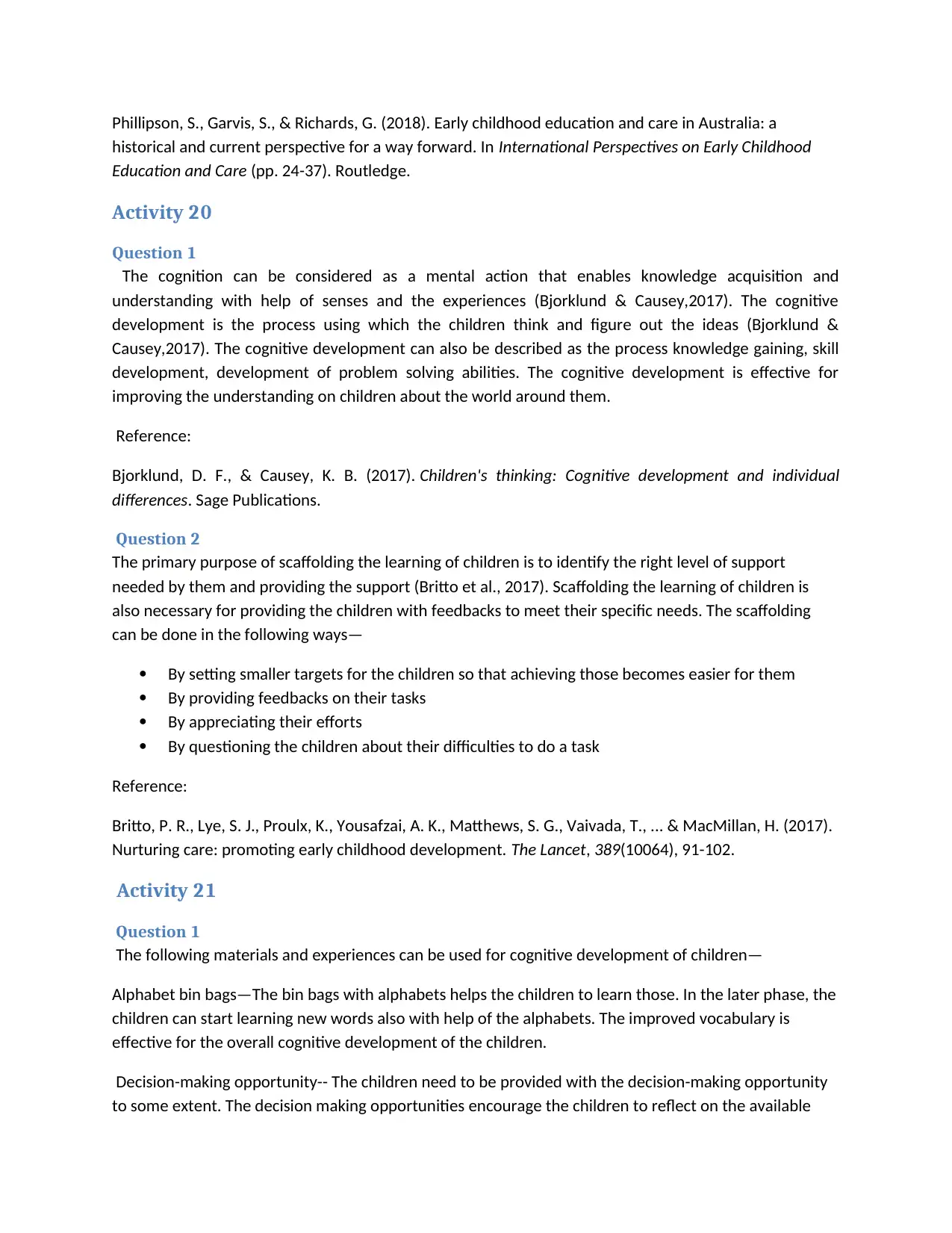
Phillipson, S., Garvis, S., & Richards, G. (2018). Early childhood education and care in Australia: a
historical and current perspective for a way forward. In International Perspectives on Early Childhood
Education and Care (pp. 24-37). Routledge.
Activity 20
Question 1
The cognition can be considered as a mental action that enables knowledge acquisition and
understanding with help of senses and the experiences (Bjorklund & Causey,2017). The cognitive
development is the process using which the children think and figure out the ideas (Bjorklund &
Causey,2017). The cognitive development can also be described as the process knowledge gaining, skill
development, development of problem solving abilities. The cognitive development is effective for
improving the understanding on children about the world around them.
Reference:
Bjorklund, D. F., & Causey, K. B. (2017). Children's thinking: Cognitive development and individual
differences. Sage Publications.
Question 2
The primary purpose of scaffolding the learning of children is to identify the right level of support
needed by them and providing the support (Britto et al., 2017). Scaffolding the learning of children is
also necessary for providing the children with feedbacks to meet their specific needs. The scaffolding
can be done in the following ways—
By setting smaller targets for the children so that achieving those becomes easier for them
By providing feedbacks on their tasks
By appreciating their efforts
By questioning the children about their difficulties to do a task
Reference:
Britto, P. R., Lye, S. J., Proulx, K., Yousafzai, A. K., Matthews, S. G., Vaivada, T., ... & MacMillan, H. (2017).
Nurturing care: promoting early childhood development. The Lancet, 389(10064), 91-102.
Activity 21
Question 1
The following materials and experiences can be used for cognitive development of children—
Alphabet bin bags—The bin bags with alphabets helps the children to learn those. In the later phase, the
children can start learning new words also with help of the alphabets. The improved vocabulary is
effective for the overall cognitive development of the children.
Decision-making opportunity-- The children need to be provided with the decision-making opportunity
to some extent. The decision making opportunities encourage the children to reflect on the available
historical and current perspective for a way forward. In International Perspectives on Early Childhood
Education and Care (pp. 24-37). Routledge.
Activity 20
Question 1
The cognition can be considered as a mental action that enables knowledge acquisition and
understanding with help of senses and the experiences (Bjorklund & Causey,2017). The cognitive
development is the process using which the children think and figure out the ideas (Bjorklund &
Causey,2017). The cognitive development can also be described as the process knowledge gaining, skill
development, development of problem solving abilities. The cognitive development is effective for
improving the understanding on children about the world around them.
Reference:
Bjorklund, D. F., & Causey, K. B. (2017). Children's thinking: Cognitive development and individual
differences. Sage Publications.
Question 2
The primary purpose of scaffolding the learning of children is to identify the right level of support
needed by them and providing the support (Britto et al., 2017). Scaffolding the learning of children is
also necessary for providing the children with feedbacks to meet their specific needs. The scaffolding
can be done in the following ways—
By setting smaller targets for the children so that achieving those becomes easier for them
By providing feedbacks on their tasks
By appreciating their efforts
By questioning the children about their difficulties to do a task
Reference:
Britto, P. R., Lye, S. J., Proulx, K., Yousafzai, A. K., Matthews, S. G., Vaivada, T., ... & MacMillan, H. (2017).
Nurturing care: promoting early childhood development. The Lancet, 389(10064), 91-102.
Activity 21
Question 1
The following materials and experiences can be used for cognitive development of children—
Alphabet bin bags—The bin bags with alphabets helps the children to learn those. In the later phase, the
children can start learning new words also with help of the alphabets. The improved vocabulary is
effective for the overall cognitive development of the children.
Decision-making opportunity-- The children need to be provided with the decision-making opportunity
to some extent. The decision making opportunities encourage the children to reflect on the available
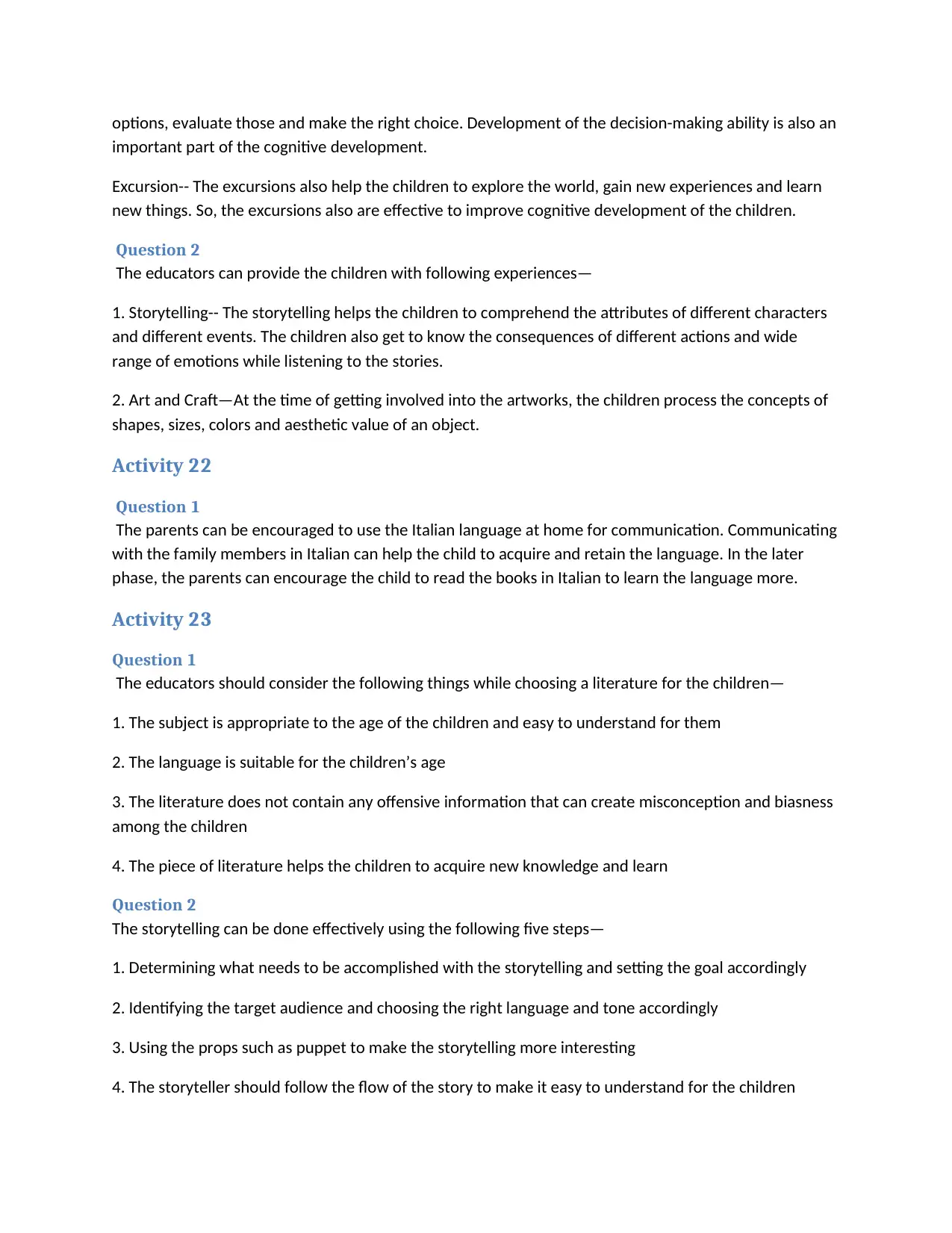
options, evaluate those and make the right choice. Development of the decision-making ability is also an
important part of the cognitive development.
Excursion-- The excursions also help the children to explore the world, gain new experiences and learn
new things. So, the excursions also are effective to improve cognitive development of the children.
Question 2
The educators can provide the children with following experiences—
1. Storytelling-- The storytelling helps the children to comprehend the attributes of different characters
and different events. The children also get to know the consequences of different actions and wide
range of emotions while listening to the stories.
2. Art and Craft—At the time of getting involved into the artworks, the children process the concepts of
shapes, sizes, colors and aesthetic value of an object.
Activity 22
Question 1
The parents can be encouraged to use the Italian language at home for communication. Communicating
with the family members in Italian can help the child to acquire and retain the language. In the later
phase, the parents can encourage the child to read the books in Italian to learn the language more.
Activity 23
Question 1
The educators should consider the following things while choosing a literature for the children—
1. The subject is appropriate to the age of the children and easy to understand for them
2. The language is suitable for the children’s age
3. The literature does not contain any offensive information that can create misconception and biasness
among the children
4. The piece of literature helps the children to acquire new knowledge and learn
Question 2
The storytelling can be done effectively using the following five steps—
1. Determining what needs to be accomplished with the storytelling and setting the goal accordingly
2. Identifying the target audience and choosing the right language and tone accordingly
3. Using the props such as puppet to make the storytelling more interesting
4. The storyteller should follow the flow of the story to make it easy to understand for the children
important part of the cognitive development.
Excursion-- The excursions also help the children to explore the world, gain new experiences and learn
new things. So, the excursions also are effective to improve cognitive development of the children.
Question 2
The educators can provide the children with following experiences—
1. Storytelling-- The storytelling helps the children to comprehend the attributes of different characters
and different events. The children also get to know the consequences of different actions and wide
range of emotions while listening to the stories.
2. Art and Craft—At the time of getting involved into the artworks, the children process the concepts of
shapes, sizes, colors and aesthetic value of an object.
Activity 22
Question 1
The parents can be encouraged to use the Italian language at home for communication. Communicating
with the family members in Italian can help the child to acquire and retain the language. In the later
phase, the parents can encourage the child to read the books in Italian to learn the language more.
Activity 23
Question 1
The educators should consider the following things while choosing a literature for the children—
1. The subject is appropriate to the age of the children and easy to understand for them
2. The language is suitable for the children’s age
3. The literature does not contain any offensive information that can create misconception and biasness
among the children
4. The piece of literature helps the children to acquire new knowledge and learn
Question 2
The storytelling can be done effectively using the following five steps—
1. Determining what needs to be accomplished with the storytelling and setting the goal accordingly
2. Identifying the target audience and choosing the right language and tone accordingly
3. Using the props such as puppet to make the storytelling more interesting
4. The storyteller should follow the flow of the story to make it easy to understand for the children
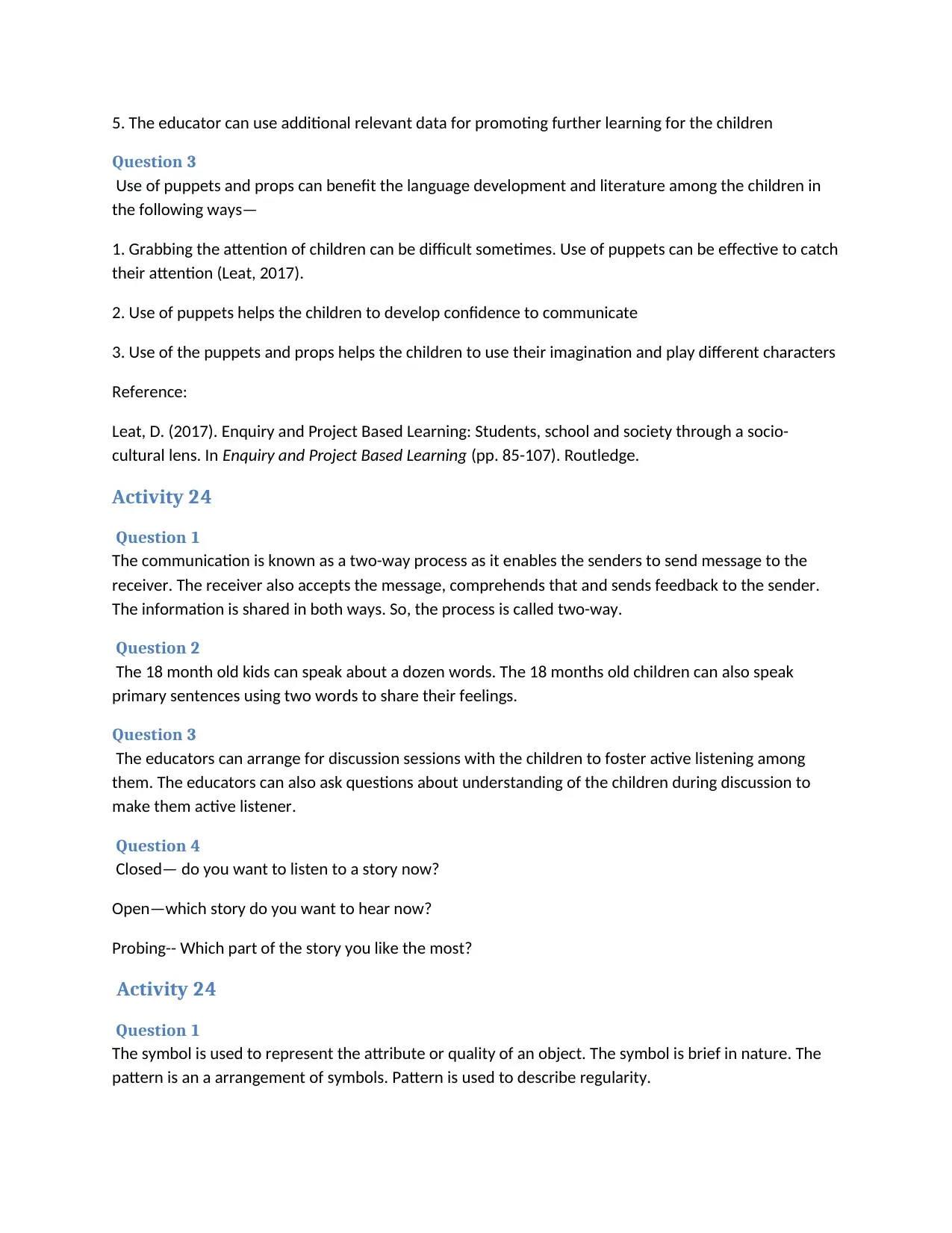
5. The educator can use additional relevant data for promoting further learning for the children
Question 3
Use of puppets and props can benefit the language development and literature among the children in
the following ways—
1. Grabbing the attention of children can be difficult sometimes. Use of puppets can be effective to catch
their attention (Leat, 2017).
2. Use of puppets helps the children to develop confidence to communicate
3. Use of the puppets and props helps the children to use their imagination and play different characters
Reference:
Leat, D. (2017). Enquiry and Project Based Learning: Students, school and society through a socio-
cultural lens. In Enquiry and Project Based Learning (pp. 85-107). Routledge.
Activity 24
Question 1
The communication is known as a two-way process as it enables the senders to send message to the
receiver. The receiver also accepts the message, comprehends that and sends feedback to the sender.
The information is shared in both ways. So, the process is called two-way.
Question 2
The 18 month old kids can speak about a dozen words. The 18 months old children can also speak
primary sentences using two words to share their feelings.
Question 3
The educators can arrange for discussion sessions with the children to foster active listening among
them. The educators can also ask questions about understanding of the children during discussion to
make them active listener.
Question 4
Closed— do you want to listen to a story now?
Open—which story do you want to hear now?
Probing-- Which part of the story you like the most?
Activity 24
Question 1
The symbol is used to represent the attribute or quality of an object. The symbol is brief in nature. The
pattern is an a arrangement of symbols. Pattern is used to describe regularity.
Question 3
Use of puppets and props can benefit the language development and literature among the children in
the following ways—
1. Grabbing the attention of children can be difficult sometimes. Use of puppets can be effective to catch
their attention (Leat, 2017).
2. Use of puppets helps the children to develop confidence to communicate
3. Use of the puppets and props helps the children to use their imagination and play different characters
Reference:
Leat, D. (2017). Enquiry and Project Based Learning: Students, school and society through a socio-
cultural lens. In Enquiry and Project Based Learning (pp. 85-107). Routledge.
Activity 24
Question 1
The communication is known as a two-way process as it enables the senders to send message to the
receiver. The receiver also accepts the message, comprehends that and sends feedback to the sender.
The information is shared in both ways. So, the process is called two-way.
Question 2
The 18 month old kids can speak about a dozen words. The 18 months old children can also speak
primary sentences using two words to share their feelings.
Question 3
The educators can arrange for discussion sessions with the children to foster active listening among
them. The educators can also ask questions about understanding of the children during discussion to
make them active listener.
Question 4
Closed— do you want to listen to a story now?
Open—which story do you want to hear now?
Probing-- Which part of the story you like the most?
Activity 24
Question 1
The symbol is used to represent the attribute or quality of an object. The symbol is brief in nature. The
pattern is an a arrangement of symbols. Pattern is used to describe regularity.
Paraphrase This Document
Need a fresh take? Get an instant paraphrase of this document with our AI Paraphraser
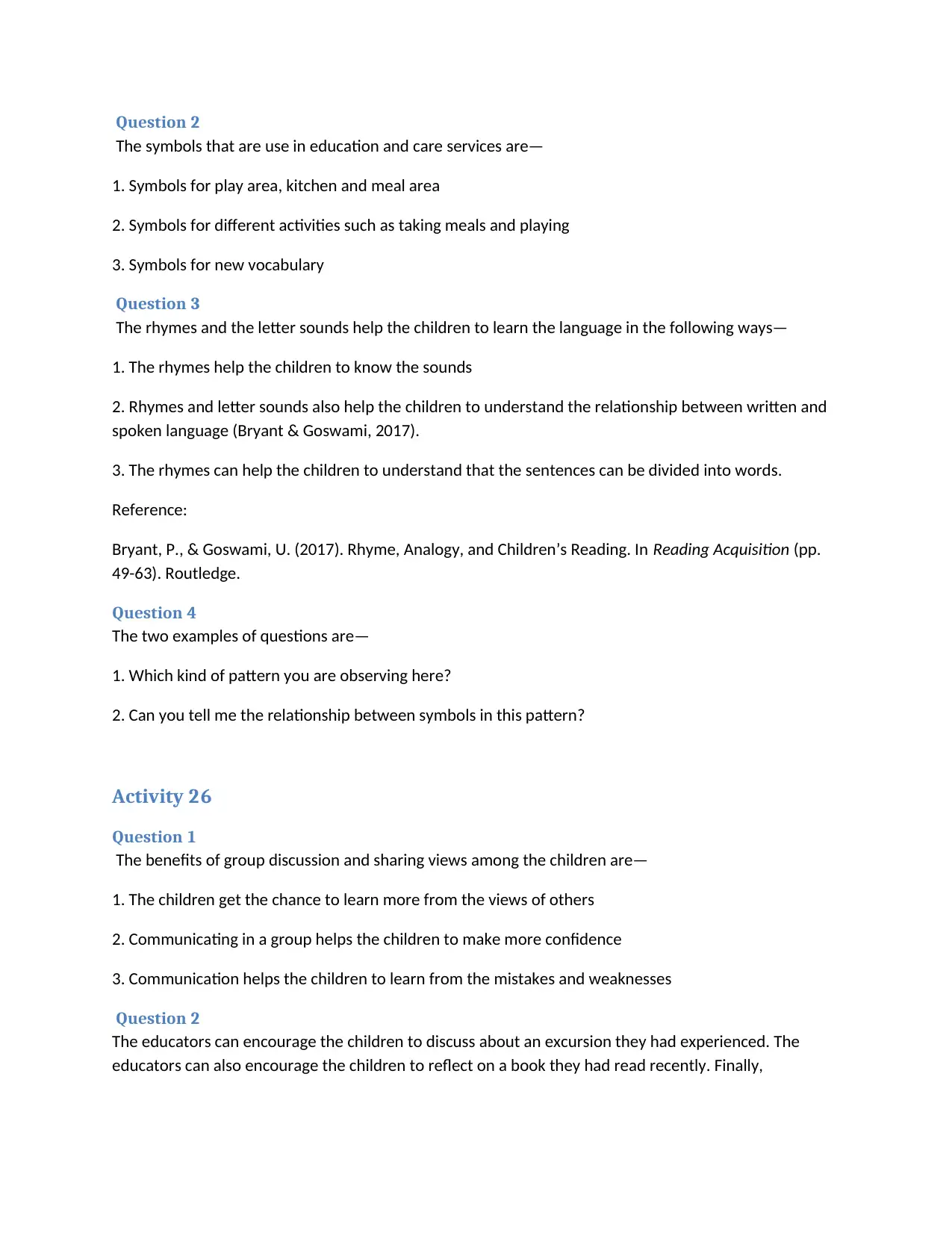
Question 2
The symbols that are use in education and care services are—
1. Symbols for play area, kitchen and meal area
2. Symbols for different activities such as taking meals and playing
3. Symbols for new vocabulary
Question 3
The rhymes and the letter sounds help the children to learn the language in the following ways—
1. The rhymes help the children to know the sounds
2. Rhymes and letter sounds also help the children to understand the relationship between written and
spoken language (Bryant & Goswami, 2017).
3. The rhymes can help the children to understand that the sentences can be divided into words.
Reference:
Bryant, P., & Goswami, U. (2017). Rhyme, Analogy, and Children’s Reading. In Reading Acquisition (pp.
49-63). Routledge.
Question 4
The two examples of questions are—
1. Which kind of pattern you are observing here?
2. Can you tell me the relationship between symbols in this pattern?
Activity 26
Question 1
The benefits of group discussion and sharing views among the children are—
1. The children get the chance to learn more from the views of others
2. Communicating in a group helps the children to make more confidence
3. Communication helps the children to learn from the mistakes and weaknesses
Question 2
The educators can encourage the children to discuss about an excursion they had experienced. The
educators can also encourage the children to reflect on a book they had read recently. Finally,
The symbols that are use in education and care services are—
1. Symbols for play area, kitchen and meal area
2. Symbols for different activities such as taking meals and playing
3. Symbols for new vocabulary
Question 3
The rhymes and the letter sounds help the children to learn the language in the following ways—
1. The rhymes help the children to know the sounds
2. Rhymes and letter sounds also help the children to understand the relationship between written and
spoken language (Bryant & Goswami, 2017).
3. The rhymes can help the children to understand that the sentences can be divided into words.
Reference:
Bryant, P., & Goswami, U. (2017). Rhyme, Analogy, and Children’s Reading. In Reading Acquisition (pp.
49-63). Routledge.
Question 4
The two examples of questions are—
1. Which kind of pattern you are observing here?
2. Can you tell me the relationship between symbols in this pattern?
Activity 26
Question 1
The benefits of group discussion and sharing views among the children are—
1. The children get the chance to learn more from the views of others
2. Communicating in a group helps the children to make more confidence
3. Communication helps the children to learn from the mistakes and weaknesses
Question 2
The educators can encourage the children to discuss about an excursion they had experienced. The
educators can also encourage the children to reflect on a book they had read recently. Finally,
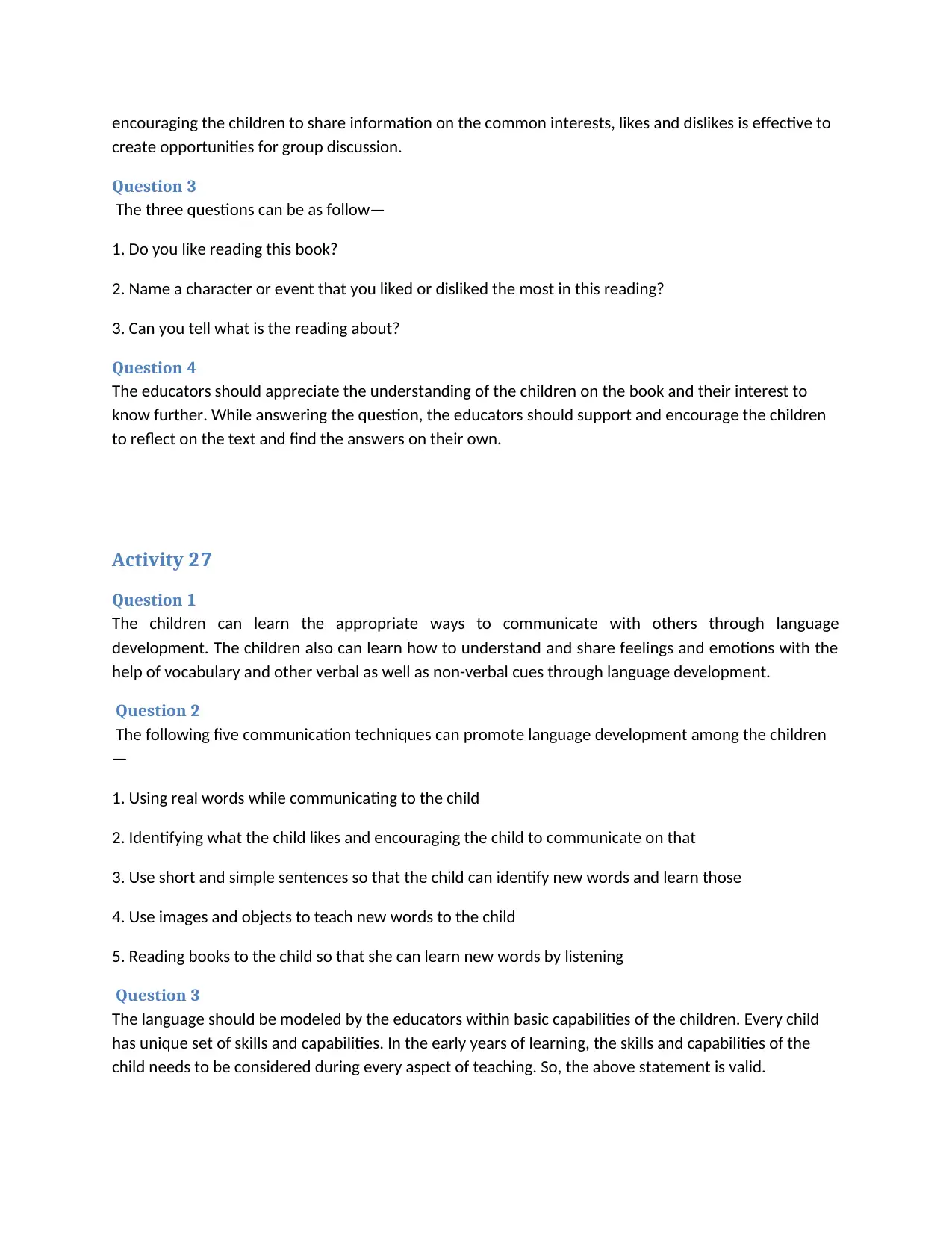
encouraging the children to share information on the common interests, likes and dislikes is effective to
create opportunities for group discussion.
Question 3
The three questions can be as follow—
1. Do you like reading this book?
2. Name a character or event that you liked or disliked the most in this reading?
3. Can you tell what is the reading about?
Question 4
The educators should appreciate the understanding of the children on the book and their interest to
know further. While answering the question, the educators should support and encourage the children
to reflect on the text and find the answers on their own.
Activity 27
Question 1
The children can learn the appropriate ways to communicate with others through language
development. The children also can learn how to understand and share feelings and emotions with the
help of vocabulary and other verbal as well as non-verbal cues through language development.
Question 2
The following five communication techniques can promote language development among the children
—
1. Using real words while communicating to the child
2. Identifying what the child likes and encouraging the child to communicate on that
3. Use short and simple sentences so that the child can identify new words and learn those
4. Use images and objects to teach new words to the child
5. Reading books to the child so that she can learn new words by listening
Question 3
The language should be modeled by the educators within basic capabilities of the children. Every child
has unique set of skills and capabilities. In the early years of learning, the skills and capabilities of the
child needs to be considered during every aspect of teaching. So, the above statement is valid.
create opportunities for group discussion.
Question 3
The three questions can be as follow—
1. Do you like reading this book?
2. Name a character or event that you liked or disliked the most in this reading?
3. Can you tell what is the reading about?
Question 4
The educators should appreciate the understanding of the children on the book and their interest to
know further. While answering the question, the educators should support and encourage the children
to reflect on the text and find the answers on their own.
Activity 27
Question 1
The children can learn the appropriate ways to communicate with others through language
development. The children also can learn how to understand and share feelings and emotions with the
help of vocabulary and other verbal as well as non-verbal cues through language development.
Question 2
The following five communication techniques can promote language development among the children
—
1. Using real words while communicating to the child
2. Identifying what the child likes and encouraging the child to communicate on that
3. Use short and simple sentences so that the child can identify new words and learn those
4. Use images and objects to teach new words to the child
5. Reading books to the child so that she can learn new words by listening
Question 3
The language should be modeled by the educators within basic capabilities of the children. Every child
has unique set of skills and capabilities. In the early years of learning, the skills and capabilities of the
child needs to be considered during every aspect of teaching. So, the above statement is valid.
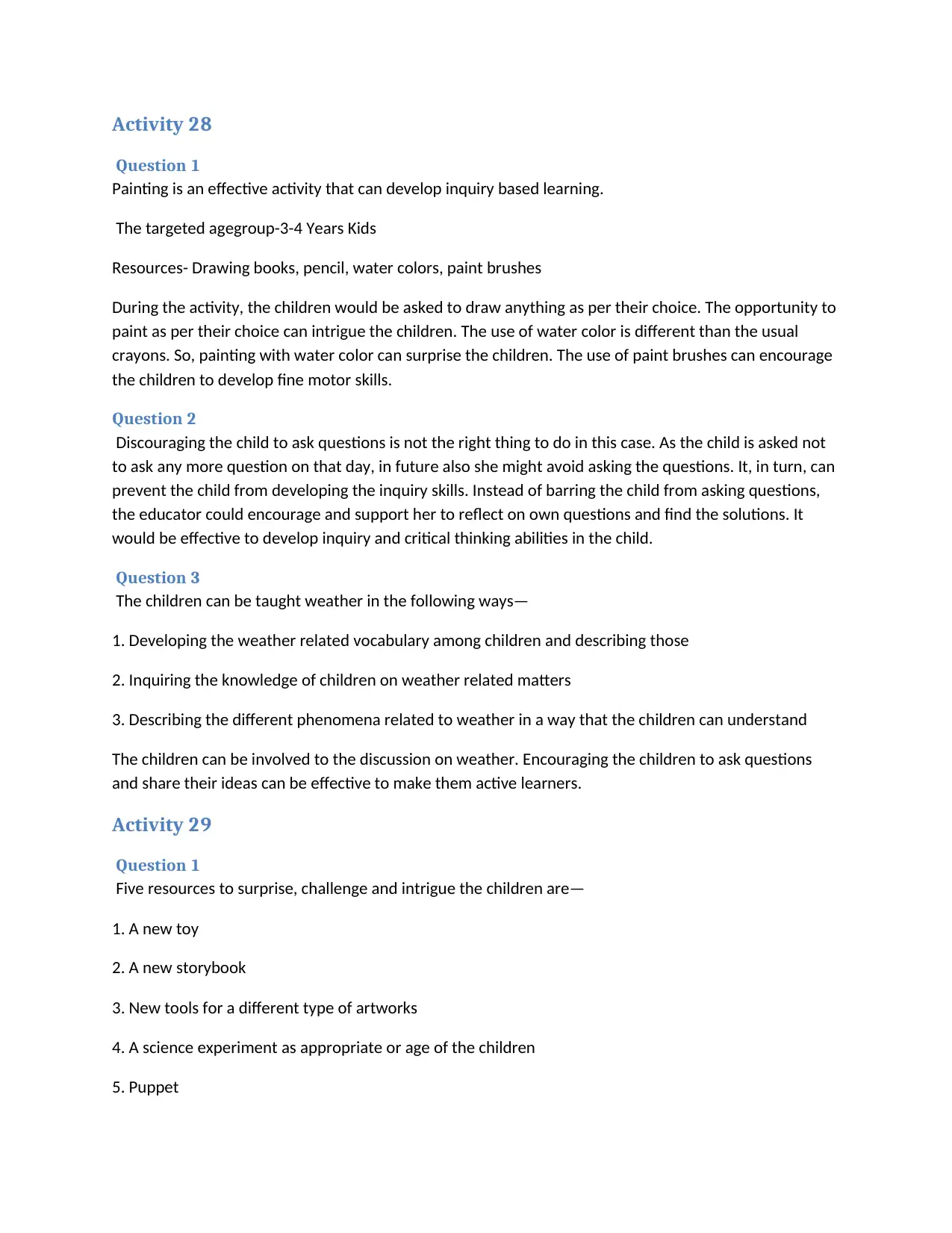
Activity 28
Question 1
Painting is an effective activity that can develop inquiry based learning.
The targeted agegroup-3-4 Years Kids
Resources- Drawing books, pencil, water colors, paint brushes
During the activity, the children would be asked to draw anything as per their choice. The opportunity to
paint as per their choice can intrigue the children. The use of water color is different than the usual
crayons. So, painting with water color can surprise the children. The use of paint brushes can encourage
the children to develop fine motor skills.
Question 2
Discouraging the child to ask questions is not the right thing to do in this case. As the child is asked not
to ask any more question on that day, in future also she might avoid asking the questions. It, in turn, can
prevent the child from developing the inquiry skills. Instead of barring the child from asking questions,
the educator could encourage and support her to reflect on own questions and find the solutions. It
would be effective to develop inquiry and critical thinking abilities in the child.
Question 3
The children can be taught weather in the following ways—
1. Developing the weather related vocabulary among children and describing those
2. Inquiring the knowledge of children on weather related matters
3. Describing the different phenomena related to weather in a way that the children can understand
The children can be involved to the discussion on weather. Encouraging the children to ask questions
and share their ideas can be effective to make them active learners.
Activity 29
Question 1
Five resources to surprise, challenge and intrigue the children are—
1. A new toy
2. A new storybook
3. New tools for a different type of artworks
4. A science experiment as appropriate or age of the children
5. Puppet
Question 1
Painting is an effective activity that can develop inquiry based learning.
The targeted agegroup-3-4 Years Kids
Resources- Drawing books, pencil, water colors, paint brushes
During the activity, the children would be asked to draw anything as per their choice. The opportunity to
paint as per their choice can intrigue the children. The use of water color is different than the usual
crayons. So, painting with water color can surprise the children. The use of paint brushes can encourage
the children to develop fine motor skills.
Question 2
Discouraging the child to ask questions is not the right thing to do in this case. As the child is asked not
to ask any more question on that day, in future also she might avoid asking the questions. It, in turn, can
prevent the child from developing the inquiry skills. Instead of barring the child from asking questions,
the educator could encourage and support her to reflect on own questions and find the solutions. It
would be effective to develop inquiry and critical thinking abilities in the child.
Question 3
The children can be taught weather in the following ways—
1. Developing the weather related vocabulary among children and describing those
2. Inquiring the knowledge of children on weather related matters
3. Describing the different phenomena related to weather in a way that the children can understand
The children can be involved to the discussion on weather. Encouraging the children to ask questions
and share their ideas can be effective to make them active learners.
Activity 29
Question 1
Five resources to surprise, challenge and intrigue the children are—
1. A new toy
2. A new storybook
3. New tools for a different type of artworks
4. A science experiment as appropriate or age of the children
5. Puppet
Secure Best Marks with AI Grader
Need help grading? Try our AI Grader for instant feedback on your assignments.
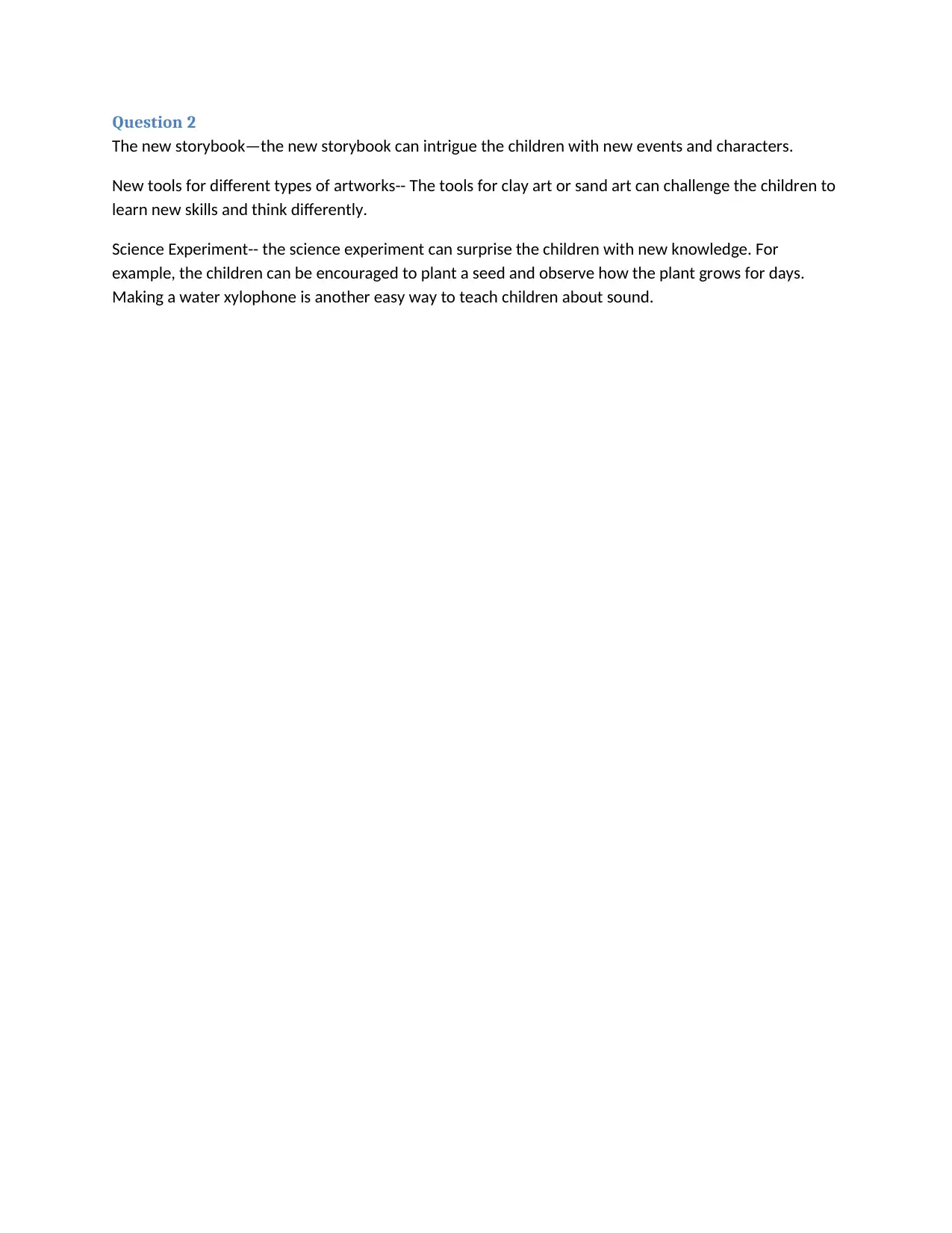
Question 2
The new storybook—the new storybook can intrigue the children with new events and characters.
New tools for different types of artworks-- The tools for clay art or sand art can challenge the children to
learn new skills and think differently.
Science Experiment-- the science experiment can surprise the children with new knowledge. For
example, the children can be encouraged to plant a seed and observe how the plant grows for days.
Making a water xylophone is another easy way to teach children about sound.
The new storybook—the new storybook can intrigue the children with new events and characters.
New tools for different types of artworks-- The tools for clay art or sand art can challenge the children to
learn new skills and think differently.
Science Experiment-- the science experiment can surprise the children with new knowledge. For
example, the children can be encouraged to plant a seed and observe how the plant grows for days.
Making a water xylophone is another easy way to teach children about sound.
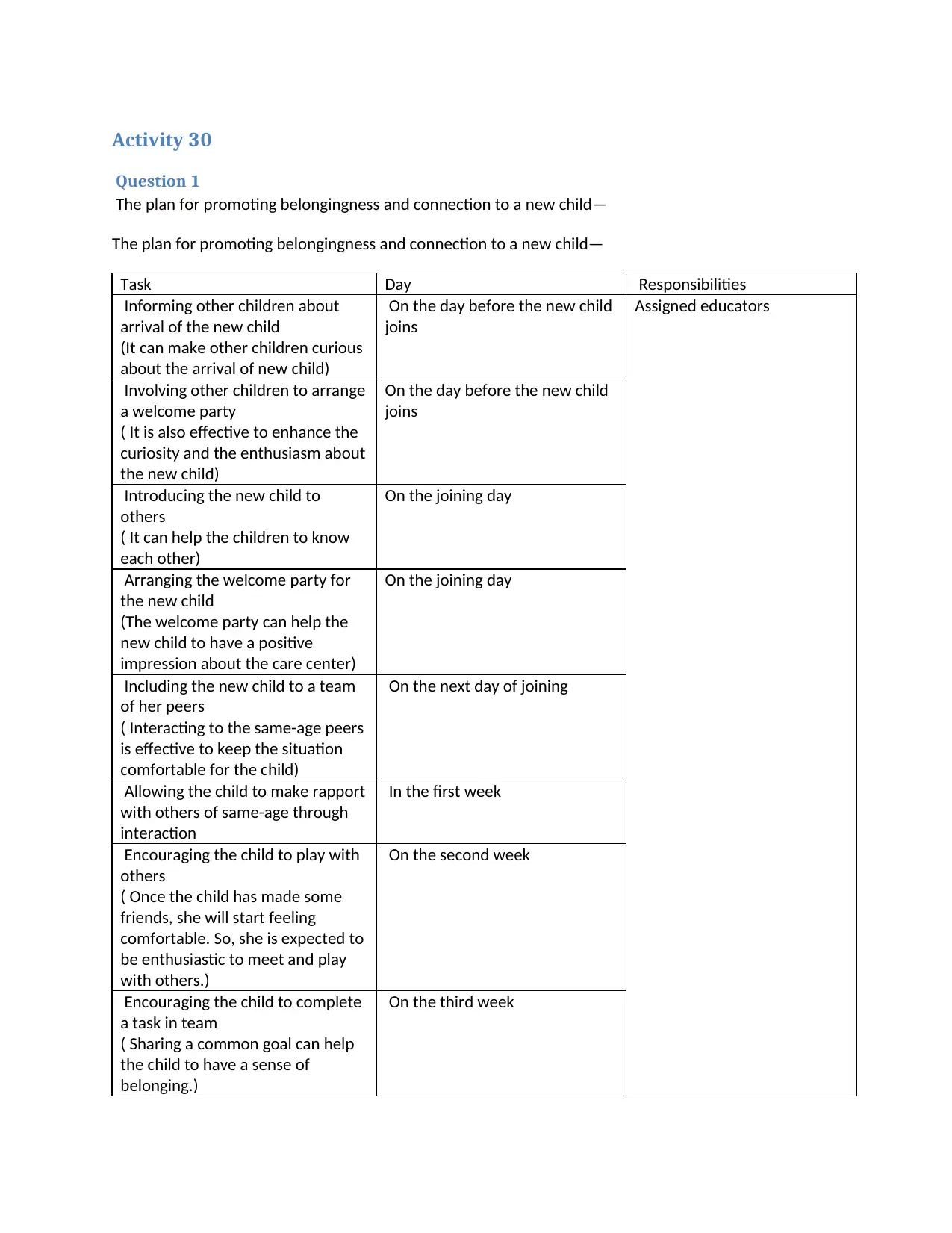
Activity 30
Question 1
The plan for promoting belongingness and connection to a new child—
The plan for promoting belongingness and connection to a new child—
Task Day Responsibilities
Informing other children about
arrival of the new child
(It can make other children curious
about the arrival of new child)
On the day before the new child
joins
Assigned educators
Involving other children to arrange
a welcome party
( It is also effective to enhance the
curiosity and the enthusiasm about
the new child)
On the day before the new child
joins
Introducing the new child to
others
( It can help the children to know
each other)
On the joining day
Arranging the welcome party for
the new child
(The welcome party can help the
new child to have a positive
impression about the care center)
On the joining day
Including the new child to a team
of her peers
( Interacting to the same-age peers
is effective to keep the situation
comfortable for the child)
On the next day of joining
Allowing the child to make rapport
with others of same-age through
interaction
In the first week
Encouraging the child to play with
others
( Once the child has made some
friends, she will start feeling
comfortable. So, she is expected to
be enthusiastic to meet and play
with others.)
On the second week
Encouraging the child to complete
a task in team
( Sharing a common goal can help
the child to have a sense of
belonging.)
On the third week
Question 1
The plan for promoting belongingness and connection to a new child—
The plan for promoting belongingness and connection to a new child—
Task Day Responsibilities
Informing other children about
arrival of the new child
(It can make other children curious
about the arrival of new child)
On the day before the new child
joins
Assigned educators
Involving other children to arrange
a welcome party
( It is also effective to enhance the
curiosity and the enthusiasm about
the new child)
On the day before the new child
joins
Introducing the new child to
others
( It can help the children to know
each other)
On the joining day
Arranging the welcome party for
the new child
(The welcome party can help the
new child to have a positive
impression about the care center)
On the joining day
Including the new child to a team
of her peers
( Interacting to the same-age peers
is effective to keep the situation
comfortable for the child)
On the next day of joining
Allowing the child to make rapport
with others of same-age through
interaction
In the first week
Encouraging the child to play with
others
( Once the child has made some
friends, she will start feeling
comfortable. So, she is expected to
be enthusiastic to meet and play
with others.)
On the second week
Encouraging the child to complete
a task in team
( Sharing a common goal can help
the child to have a sense of
belonging.)
On the third week

Question 2
The three things which can be done to promote the sense of belongingness and connectedness among
the children are as follow—
1. Providing them tasks which need to be completed in teams
2. Encouraging the children to play with others
3. Encouraging the children to read a book and reflect on it with the groups
Activity 31
Question 1
Engaging the children in shared communication during play can be done in the following ways—
1. Asking them questions about their preference
2. Allowing the children to make decisions regarding toys and other props
3. Providing the children suggestions to some extent
4. Encouraging the children to think different ways of using a toy
5. Taking part in the play
6. Asking children about their feelings regarding a particular play activity
Question 2
The enquiry skill is the ability to ask questions. The enquiry skills help the children to interpret and
reflect on the answers to a question. The enquiry skills also help the children to develop higher order
thinking skills, analyzing and synthesis skills (Hill, 2018). The enquiry skills also promote curiosity, critical
thinking and independent thinking (Stacey et al., 2015).
The children can be appreciated for asking questions. The positive feedback can encourage them to ask
more questions. It, in turn, can lead to development of enquiry skill.
Reference:
Hill, H. (2018). A Practical Guide to Enquiry-Based Primary Teaching: A Reflective Journey.
The three things which can be done to promote the sense of belongingness and connectedness among
the children are as follow—
1. Providing them tasks which need to be completed in teams
2. Encouraging the children to play with others
3. Encouraging the children to read a book and reflect on it with the groups
Activity 31
Question 1
Engaging the children in shared communication during play can be done in the following ways—
1. Asking them questions about their preference
2. Allowing the children to make decisions regarding toys and other props
3. Providing the children suggestions to some extent
4. Encouraging the children to think different ways of using a toy
5. Taking part in the play
6. Asking children about their feelings regarding a particular play activity
Question 2
The enquiry skill is the ability to ask questions. The enquiry skills help the children to interpret and
reflect on the answers to a question. The enquiry skills also help the children to develop higher order
thinking skills, analyzing and synthesis skills (Hill, 2018). The enquiry skills also promote curiosity, critical
thinking and independent thinking (Stacey et al., 2015).
The children can be appreciated for asking questions. The positive feedback can encourage them to ask
more questions. It, in turn, can lead to development of enquiry skill.
Reference:
Hill, H. (2018). A Practical Guide to Enquiry-Based Primary Teaching: A Reflective Journey.
Paraphrase This Document
Need a fresh take? Get an instant paraphrase of this document with our AI Paraphraser
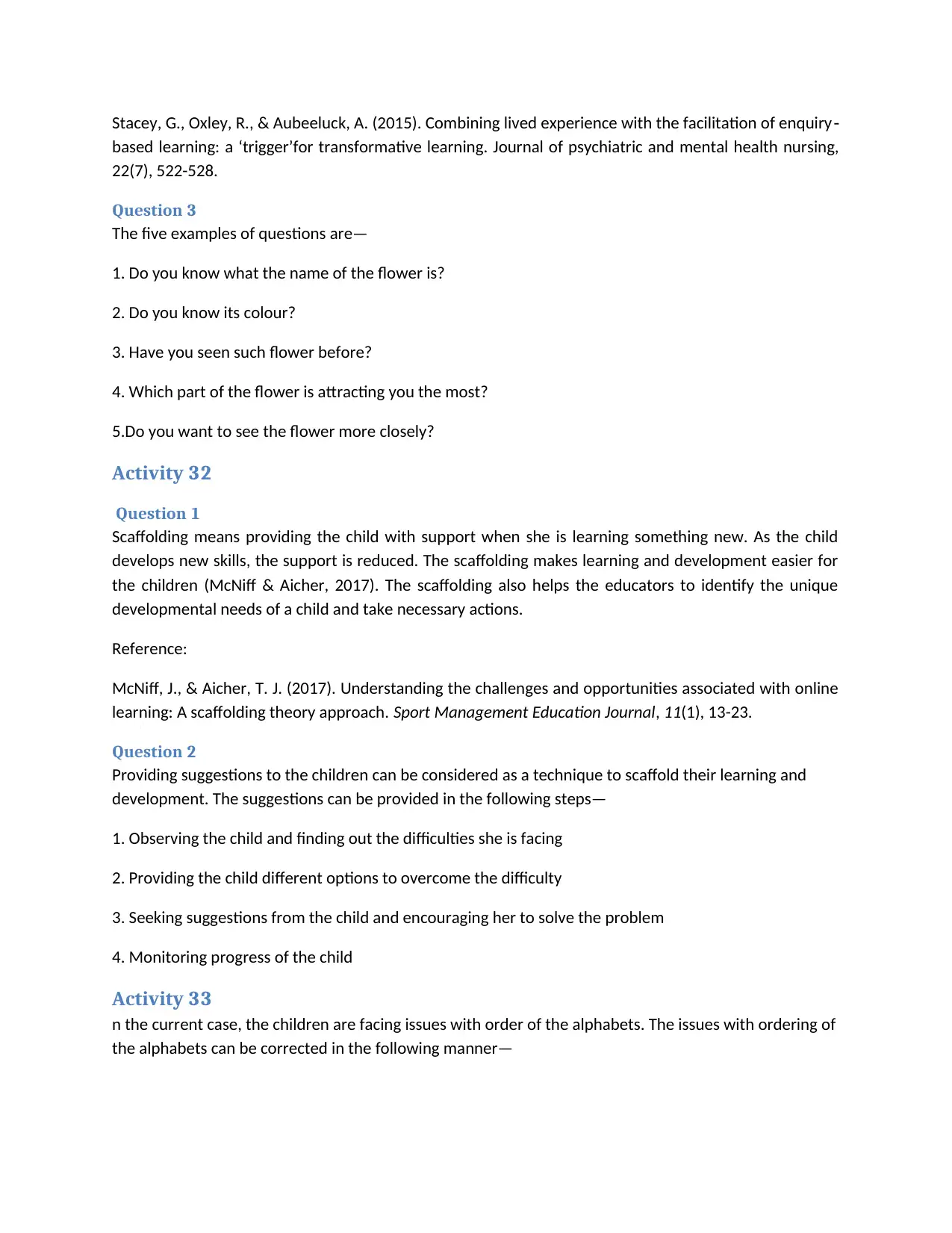
Stacey, G., Oxley, R., & Aubeeluck, A. (2015). Combining lived experience with the facilitation of enquiry‐
based learning: a ‘trigger’for transformative learning. Journal of psychiatric and mental health nursing,
22(7), 522-528.
Question 3
The five examples of questions are—
1. Do you know what the name of the flower is?
2. Do you know its colour?
3. Have you seen such flower before?
4. Which part of the flower is attracting you the most?
5.Do you want to see the flower more closely?
Activity 32
Question 1
Scaffolding means providing the child with support when she is learning something new. As the child
develops new skills, the support is reduced. The scaffolding makes learning and development easier for
the children (McNiff & Aicher, 2017). The scaffolding also helps the educators to identify the unique
developmental needs of a child and take necessary actions.
Reference:
McNiff, J., & Aicher, T. J. (2017). Understanding the challenges and opportunities associated with online
learning: A scaffolding theory approach. Sport Management Education Journal, 11(1), 13-23.
Question 2
Providing suggestions to the children can be considered as a technique to scaffold their learning and
development. The suggestions can be provided in the following steps—
1. Observing the child and finding out the difficulties she is facing
2. Providing the child different options to overcome the difficulty
3. Seeking suggestions from the child and encouraging her to solve the problem
4. Monitoring progress of the child
Activity 33
n the current case, the children are facing issues with order of the alphabets. The issues with ordering of
the alphabets can be corrected in the following manner—
based learning: a ‘trigger’for transformative learning. Journal of psychiatric and mental health nursing,
22(7), 522-528.
Question 3
The five examples of questions are—
1. Do you know what the name of the flower is?
2. Do you know its colour?
3. Have you seen such flower before?
4. Which part of the flower is attracting you the most?
5.Do you want to see the flower more closely?
Activity 32
Question 1
Scaffolding means providing the child with support when she is learning something new. As the child
develops new skills, the support is reduced. The scaffolding makes learning and development easier for
the children (McNiff & Aicher, 2017). The scaffolding also helps the educators to identify the unique
developmental needs of a child and take necessary actions.
Reference:
McNiff, J., & Aicher, T. J. (2017). Understanding the challenges and opportunities associated with online
learning: A scaffolding theory approach. Sport Management Education Journal, 11(1), 13-23.
Question 2
Providing suggestions to the children can be considered as a technique to scaffold their learning and
development. The suggestions can be provided in the following steps—
1. Observing the child and finding out the difficulties she is facing
2. Providing the child different options to overcome the difficulty
3. Seeking suggestions from the child and encouraging her to solve the problem
4. Monitoring progress of the child
Activity 33
n the current case, the children are facing issues with order of the alphabets. The issues with ordering of
the alphabets can be corrected in the following manner—
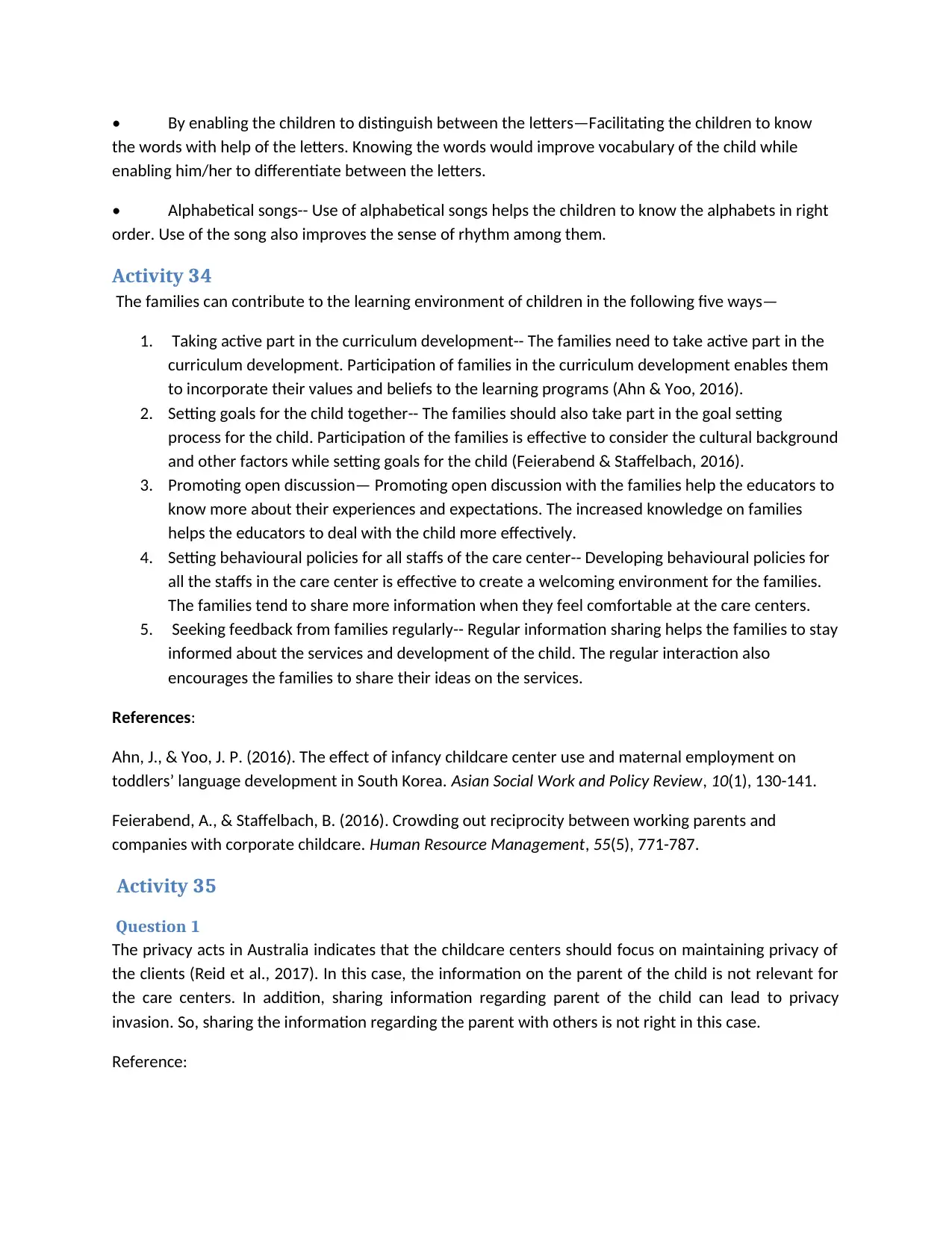
• By enabling the children to distinguish between the letters—Facilitating the children to know
the words with help of the letters. Knowing the words would improve vocabulary of the child while
enabling him/her to differentiate between the letters.
• Alphabetical songs-- Use of alphabetical songs helps the children to know the alphabets in right
order. Use of the song also improves the sense of rhythm among them.
Activity 34
The families can contribute to the learning environment of children in the following five ways—
1. Taking active part in the curriculum development-- The families need to take active part in the
curriculum development. Participation of families in the curriculum development enables them
to incorporate their values and beliefs to the learning programs (Ahn & Yoo, 2016).
2. Setting goals for the child together-- The families should also take part in the goal setting
process for the child. Participation of the families is effective to consider the cultural background
and other factors while setting goals for the child (Feierabend & Staffelbach, 2016).
3. Promoting open discussion— Promoting open discussion with the families help the educators to
know more about their experiences and expectations. The increased knowledge on families
helps the educators to deal with the child more effectively.
4. Setting behavioural policies for all staffs of the care center-- Developing behavioural policies for
all the staffs in the care center is effective to create a welcoming environment for the families.
The families tend to share more information when they feel comfortable at the care centers.
5. Seeking feedback from families regularly-- Regular information sharing helps the families to stay
informed about the services and development of the child. The regular interaction also
encourages the families to share their ideas on the services.
References:
Ahn, J., & Yoo, J. P. (2016). The effect of infancy childcare center use and maternal employment on
toddlers’ language development in South Korea. Asian Social Work and Policy Review, 10(1), 130-141.
Feierabend, A., & Staffelbach, B. (2016). Crowding out reciprocity between working parents and
companies with corporate childcare. Human Resource Management, 55(5), 771-787.
Activity 35
Question 1
The privacy acts in Australia indicates that the childcare centers should focus on maintaining privacy of
the clients (Reid et al., 2017). In this case, the information on the parent of the child is not relevant for
the care centers. In addition, sharing information regarding parent of the child can lead to privacy
invasion. So, sharing the information regarding the parent with others is not right in this case.
Reference:
the words with help of the letters. Knowing the words would improve vocabulary of the child while
enabling him/her to differentiate between the letters.
• Alphabetical songs-- Use of alphabetical songs helps the children to know the alphabets in right
order. Use of the song also improves the sense of rhythm among them.
Activity 34
The families can contribute to the learning environment of children in the following five ways—
1. Taking active part in the curriculum development-- The families need to take active part in the
curriculum development. Participation of families in the curriculum development enables them
to incorporate their values and beliefs to the learning programs (Ahn & Yoo, 2016).
2. Setting goals for the child together-- The families should also take part in the goal setting
process for the child. Participation of the families is effective to consider the cultural background
and other factors while setting goals for the child (Feierabend & Staffelbach, 2016).
3. Promoting open discussion— Promoting open discussion with the families help the educators to
know more about their experiences and expectations. The increased knowledge on families
helps the educators to deal with the child more effectively.
4. Setting behavioural policies for all staffs of the care center-- Developing behavioural policies for
all the staffs in the care center is effective to create a welcoming environment for the families.
The families tend to share more information when they feel comfortable at the care centers.
5. Seeking feedback from families regularly-- Regular information sharing helps the families to stay
informed about the services and development of the child. The regular interaction also
encourages the families to share their ideas on the services.
References:
Ahn, J., & Yoo, J. P. (2016). The effect of infancy childcare center use and maternal employment on
toddlers’ language development in South Korea. Asian Social Work and Policy Review, 10(1), 130-141.
Feierabend, A., & Staffelbach, B. (2016). Crowding out reciprocity between working parents and
companies with corporate childcare. Human Resource Management, 55(5), 771-787.
Activity 35
Question 1
The privacy acts in Australia indicates that the childcare centers should focus on maintaining privacy of
the clients (Reid et al., 2017). In this case, the information on the parent of the child is not relevant for
the care centers. In addition, sharing information regarding parent of the child can lead to privacy
invasion. So, sharing the information regarding the parent with others is not right in this case.
Reference:
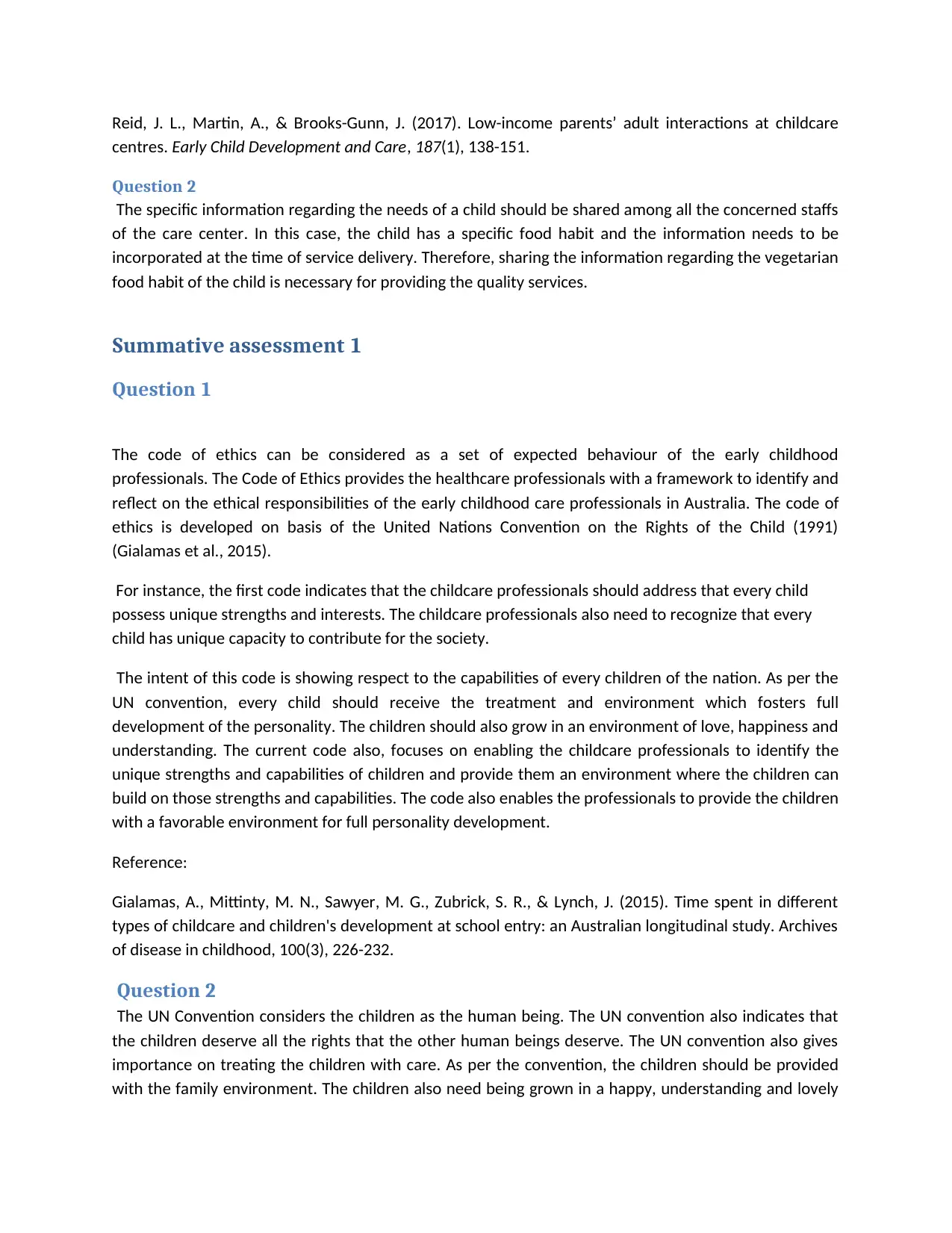
Reid, J. L., Martin, A., & Brooks-Gunn, J. (2017). Low-income parents’ adult interactions at childcare
centres. Early Child Development and Care, 187(1), 138-151.
Question 2
The specific information regarding the needs of a child should be shared among all the concerned staffs
of the care center. In this case, the child has a specific food habit and the information needs to be
incorporated at the time of service delivery. Therefore, sharing the information regarding the vegetarian
food habit of the child is necessary for providing the quality services.
Summative assessment 1
Question 1
The code of ethics can be considered as a set of expected behaviour of the early childhood
professionals. The Code of Ethics provides the healthcare professionals with a framework to identify and
reflect on the ethical responsibilities of the early childhood care professionals in Australia. The code of
ethics is developed on basis of the United Nations Convention on the Rights of the Child (1991)
(Gialamas et al., 2015).
For instance, the first code indicates that the childcare professionals should address that every child
possess unique strengths and interests. The childcare professionals also need to recognize that every
child has unique capacity to contribute for the society.
The intent of this code is showing respect to the capabilities of every children of the nation. As per the
UN convention, every child should receive the treatment and environment which fosters full
development of the personality. The children should also grow in an environment of love, happiness and
understanding. The current code also, focuses on enabling the childcare professionals to identify the
unique strengths and capabilities of children and provide them an environment where the children can
build on those strengths and capabilities. The code also enables the professionals to provide the children
with a favorable environment for full personality development.
Reference:
Gialamas, A., Mittinty, M. N., Sawyer, M. G., Zubrick, S. R., & Lynch, J. (2015). Time spent in different
types of childcare and children's development at school entry: an Australian longitudinal study. Archives
of disease in childhood, 100(3), 226-232.
Question 2
The UN Convention considers the children as the human being. The UN convention also indicates that
the children deserve all the rights that the other human beings deserve. The UN convention also gives
importance on treating the children with care. As per the convention, the children should be provided
with the family environment. The children also need being grown in a happy, understanding and lovely
centres. Early Child Development and Care, 187(1), 138-151.
Question 2
The specific information regarding the needs of a child should be shared among all the concerned staffs
of the care center. In this case, the child has a specific food habit and the information needs to be
incorporated at the time of service delivery. Therefore, sharing the information regarding the vegetarian
food habit of the child is necessary for providing the quality services.
Summative assessment 1
Question 1
The code of ethics can be considered as a set of expected behaviour of the early childhood
professionals. The Code of Ethics provides the healthcare professionals with a framework to identify and
reflect on the ethical responsibilities of the early childhood care professionals in Australia. The code of
ethics is developed on basis of the United Nations Convention on the Rights of the Child (1991)
(Gialamas et al., 2015).
For instance, the first code indicates that the childcare professionals should address that every child
possess unique strengths and interests. The childcare professionals also need to recognize that every
child has unique capacity to contribute for the society.
The intent of this code is showing respect to the capabilities of every children of the nation. As per the
UN convention, every child should receive the treatment and environment which fosters full
development of the personality. The children should also grow in an environment of love, happiness and
understanding. The current code also, focuses on enabling the childcare professionals to identify the
unique strengths and capabilities of children and provide them an environment where the children can
build on those strengths and capabilities. The code also enables the professionals to provide the children
with a favorable environment for full personality development.
Reference:
Gialamas, A., Mittinty, M. N., Sawyer, M. G., Zubrick, S. R., & Lynch, J. (2015). Time spent in different
types of childcare and children's development at school entry: an Australian longitudinal study. Archives
of disease in childhood, 100(3), 226-232.
Question 2
The UN Convention considers the children as the human being. The UN convention also indicates that
the children deserve all the rights that the other human beings deserve. The UN convention also gives
importance on treating the children with care. As per the convention, the children should be provided
with the family environment. The children also need being grown in a happy, understanding and lovely
Secure Best Marks with AI Grader
Need help grading? Try our AI Grader for instant feedback on your assignments.
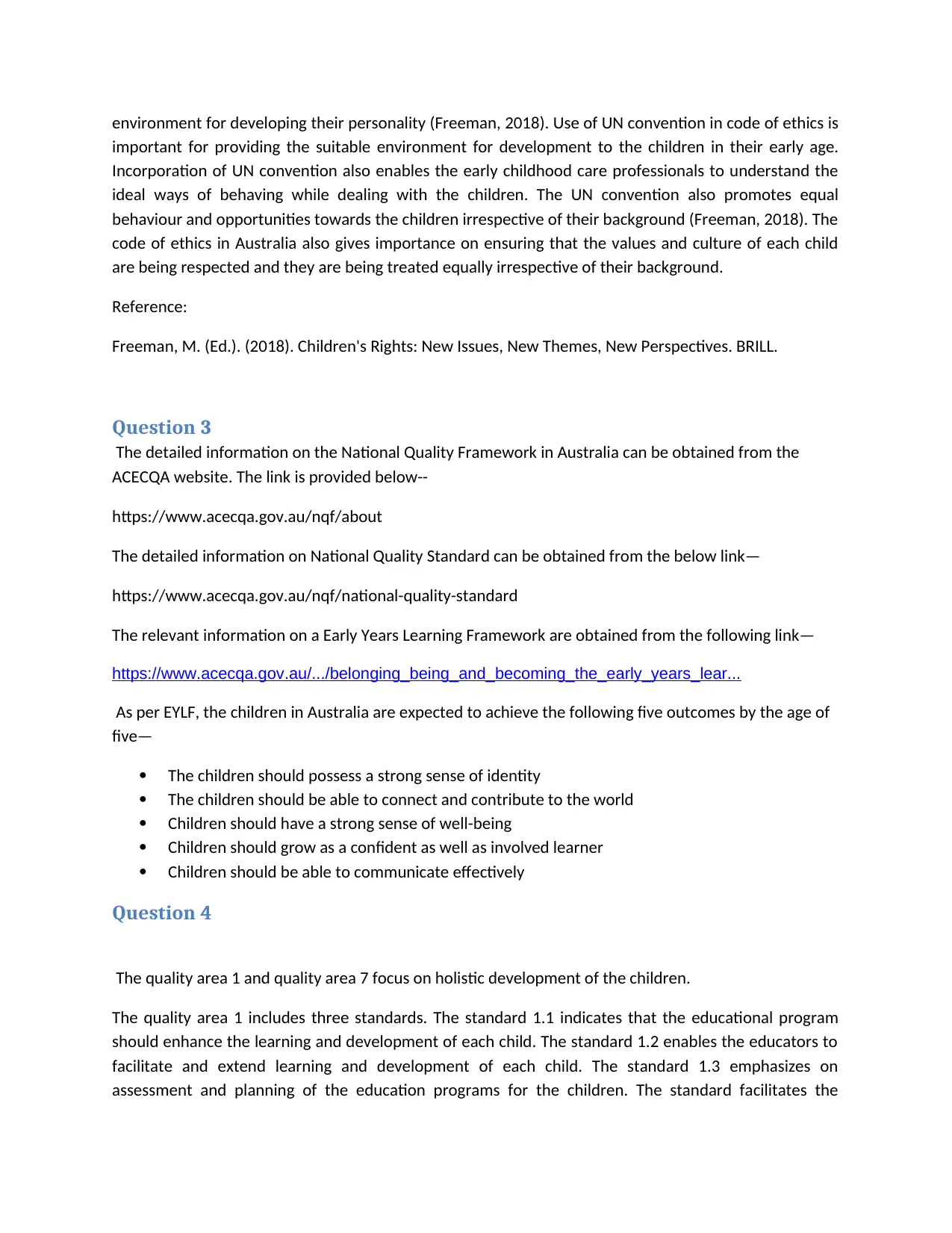
environment for developing their personality (Freeman, 2018). Use of UN convention in code of ethics is
important for providing the suitable environment for development to the children in their early age.
Incorporation of UN convention also enables the early childhood care professionals to understand the
ideal ways of behaving while dealing with the children. The UN convention also promotes equal
behaviour and opportunities towards the children irrespective of their background (Freeman, 2018). The
code of ethics in Australia also gives importance on ensuring that the values and culture of each child
are being respected and they are being treated equally irrespective of their background.
Reference:
Freeman, M. (Ed.). (2018). Children's Rights: New Issues, New Themes, New Perspectives. BRILL.
Question 3
The detailed information on the National Quality Framework in Australia can be obtained from the
ACECQA website. The link is provided below--
https://www.acecqa.gov.au/nqf/about
The detailed information on National Quality Standard can be obtained from the below link—
https://www.acecqa.gov.au/nqf/national-quality-standard
The relevant information on a Early Years Learning Framework are obtained from the following link—
https://www.acecqa.gov.au/.../belonging_being_and_becoming_the_early_years_lear...
As per EYLF, the children in Australia are expected to achieve the following five outcomes by the age of
five—
The children should possess a strong sense of identity
The children should be able to connect and contribute to the world
Children should have a strong sense of well-being
Children should grow as a confident as well as involved learner
Children should be able to communicate effectively
Question 4
The quality area 1 and quality area 7 focus on holistic development of the children.
The quality area 1 includes three standards. The standard 1.1 indicates that the educational program
should enhance the learning and development of each child. The standard 1.2 enables the educators to
facilitate and extend learning and development of each child. The standard 1.3 emphasizes on
assessment and planning of the education programs for the children. The standard facilitates the
important for providing the suitable environment for development to the children in their early age.
Incorporation of UN convention also enables the early childhood care professionals to understand the
ideal ways of behaving while dealing with the children. The UN convention also promotes equal
behaviour and opportunities towards the children irrespective of their background (Freeman, 2018). The
code of ethics in Australia also gives importance on ensuring that the values and culture of each child
are being respected and they are being treated equally irrespective of their background.
Reference:
Freeman, M. (Ed.). (2018). Children's Rights: New Issues, New Themes, New Perspectives. BRILL.
Question 3
The detailed information on the National Quality Framework in Australia can be obtained from the
ACECQA website. The link is provided below--
https://www.acecqa.gov.au/nqf/about
The detailed information on National Quality Standard can be obtained from the below link—
https://www.acecqa.gov.au/nqf/national-quality-standard
The relevant information on a Early Years Learning Framework are obtained from the following link—
https://www.acecqa.gov.au/.../belonging_being_and_becoming_the_early_years_lear...
As per EYLF, the children in Australia are expected to achieve the following five outcomes by the age of
five—
The children should possess a strong sense of identity
The children should be able to connect and contribute to the world
Children should have a strong sense of well-being
Children should grow as a confident as well as involved learner
Children should be able to communicate effectively
Question 4
The quality area 1 and quality area 7 focus on holistic development of the children.
The quality area 1 includes three standards. The standard 1.1 indicates that the educational program
should enhance the learning and development of each child. The standard 1.2 enables the educators to
facilitate and extend learning and development of each child. The standard 1.3 emphasizes on
assessment and planning of the education programs for the children. The standard facilitates the
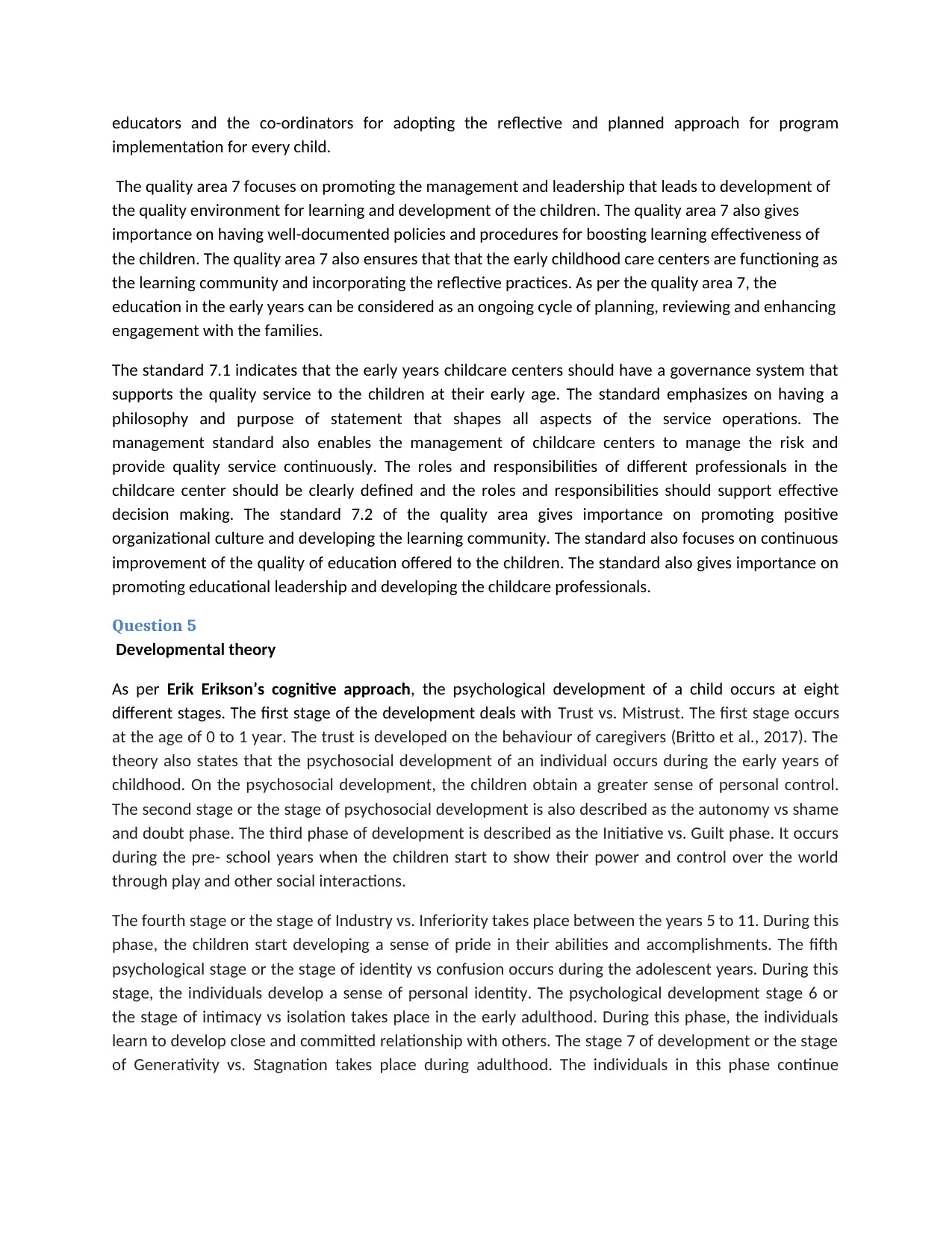
educators and the co-ordinators for adopting the reflective and planned approach for program
implementation for every child.
The quality area 7 focuses on promoting the management and leadership that leads to development of
the quality environment for learning and development of the children. The quality area 7 also gives
importance on having well-documented policies and procedures for boosting learning effectiveness of
the children. The quality area 7 also ensures that that the early childhood care centers are functioning as
the learning community and incorporating the reflective practices. As per the quality area 7, the
education in the early years can be considered as an ongoing cycle of planning, reviewing and enhancing
engagement with the families.
The standard 7.1 indicates that the early years childcare centers should have a governance system that
supports the quality service to the children at their early age. The standard emphasizes on having a
philosophy and purpose of statement that shapes all aspects of the service operations. The
management standard also enables the management of childcare centers to manage the risk and
provide quality service continuously. The roles and responsibilities of different professionals in the
childcare center should be clearly defined and the roles and responsibilities should support effective
decision making. The standard 7.2 of the quality area gives importance on promoting positive
organizational culture and developing the learning community. The standard also focuses on continuous
improvement of the quality of education offered to the children. The standard also gives importance on
promoting educational leadership and developing the childcare professionals.
Question 5
Developmental theory
As per Erik Erikson’s cognitive approach, the psychological development of a child occurs at eight
different stages. The first stage of the development deals with Trust vs. Mistrust. The first stage occurs
at the age of 0 to 1 year. The trust is developed on the behaviour of caregivers (Britto et al., 2017). The
theory also states that the psychosocial development of an individual occurs during the early years of
childhood. On the psychosocial development, the children obtain a greater sense of personal control.
The second stage or the stage of psychosocial development is also described as the autonomy vs shame
and doubt phase. The third phase of development is described as the Initiative vs. Guilt phase. It occurs
during the pre- school years when the children start to show their power and control over the world
through play and other social interactions.
The fourth stage or the stage of Industry vs. Inferiority takes place between the years 5 to 11. During this
phase, the children start developing a sense of pride in their abilities and accomplishments. The fifth
psychological stage or the stage of identity vs confusion occurs during the adolescent years. During this
stage, the individuals develop a sense of personal identity. The psychological development stage 6 or
the stage of intimacy vs isolation takes place in the early adulthood. During this phase, the individuals
learn to develop close and committed relationship with others. The stage 7 of development or the stage
of Generativity vs. Stagnation takes place during adulthood. The individuals in this phase continue
implementation for every child.
The quality area 7 focuses on promoting the management and leadership that leads to development of
the quality environment for learning and development of the children. The quality area 7 also gives
importance on having well-documented policies and procedures for boosting learning effectiveness of
the children. The quality area 7 also ensures that that the early childhood care centers are functioning as
the learning community and incorporating the reflective practices. As per the quality area 7, the
education in the early years can be considered as an ongoing cycle of planning, reviewing and enhancing
engagement with the families.
The standard 7.1 indicates that the early years childcare centers should have a governance system that
supports the quality service to the children at their early age. The standard emphasizes on having a
philosophy and purpose of statement that shapes all aspects of the service operations. The
management standard also enables the management of childcare centers to manage the risk and
provide quality service continuously. The roles and responsibilities of different professionals in the
childcare center should be clearly defined and the roles and responsibilities should support effective
decision making. The standard 7.2 of the quality area gives importance on promoting positive
organizational culture and developing the learning community. The standard also focuses on continuous
improvement of the quality of education offered to the children. The standard also gives importance on
promoting educational leadership and developing the childcare professionals.
Question 5
Developmental theory
As per Erik Erikson’s cognitive approach, the psychological development of a child occurs at eight
different stages. The first stage of the development deals with Trust vs. Mistrust. The first stage occurs
at the age of 0 to 1 year. The trust is developed on the behaviour of caregivers (Britto et al., 2017). The
theory also states that the psychosocial development of an individual occurs during the early years of
childhood. On the psychosocial development, the children obtain a greater sense of personal control.
The second stage or the stage of psychosocial development is also described as the autonomy vs shame
and doubt phase. The third phase of development is described as the Initiative vs. Guilt phase. It occurs
during the pre- school years when the children start to show their power and control over the world
through play and other social interactions.
The fourth stage or the stage of Industry vs. Inferiority takes place between the years 5 to 11. During this
phase, the children start developing a sense of pride in their abilities and accomplishments. The fifth
psychological stage or the stage of identity vs confusion occurs during the adolescent years. During this
stage, the individuals develop a sense of personal identity. The psychological development stage 6 or
the stage of intimacy vs isolation takes place in the early adulthood. During this phase, the individuals
learn to develop close and committed relationship with others. The stage 7 of development or the stage
of Generativity vs. Stagnation takes place during adulthood. The individuals in this phase continue
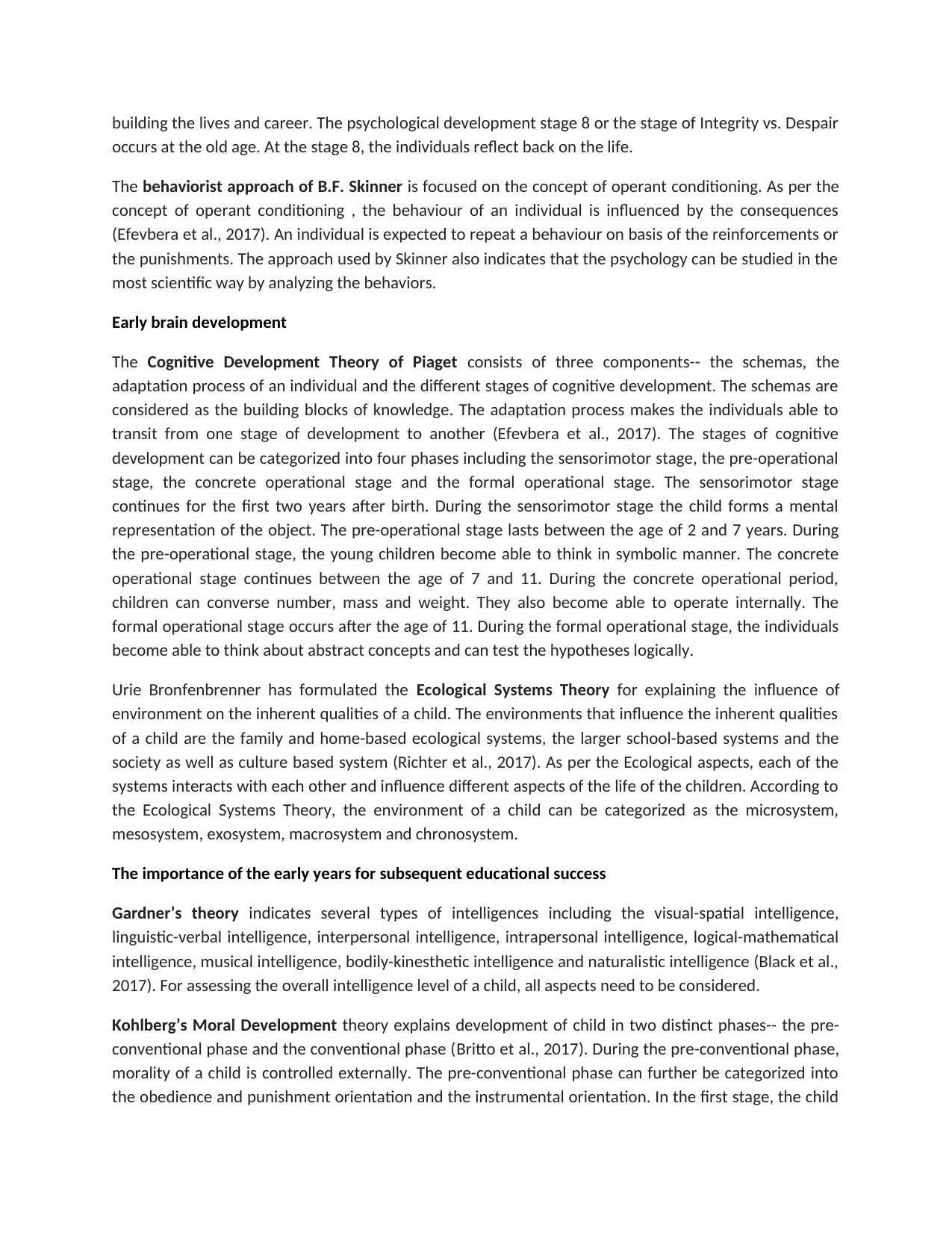
building the lives and career. The psychological development stage 8 or the stage of Integrity vs. Despair
occurs at the old age. At the stage 8, the individuals reflect back on the life.
The behaviorist approach of B.F. Skinner is focused on the concept of operant conditioning. As per the
concept of operant conditioning , the behaviour of an individual is influenced by the consequences
(Efevbera et al., 2017). An individual is expected to repeat a behaviour on basis of the reinforcements or
the punishments. The approach used by Skinner also indicates that the psychology can be studied in the
most scientific way by analyzing the behaviors.
Early brain development
The Cognitive Development Theory of Piaget consists of three components-- the schemas, the
adaptation process of an individual and the different stages of cognitive development. The schemas are
considered as the building blocks of knowledge. The adaptation process makes the individuals able to
transit from one stage of development to another (Efevbera et al., 2017). The stages of cognitive
development can be categorized into four phases including the sensorimotor stage, the pre-operational
stage, the concrete operational stage and the formal operational stage. The sensorimotor stage
continues for the first two years after birth. During the sensorimotor stage the child forms a mental
representation of the object. The pre-operational stage lasts between the age of 2 and 7 years. During
the pre-operational stage, the young children become able to think in symbolic manner. The concrete
operational stage continues between the age of 7 and 11. During the concrete operational period,
children can converse number, mass and weight. They also become able to operate internally. The
formal operational stage occurs after the age of 11. During the formal operational stage, the individuals
become able to think about abstract concepts and can test the hypotheses logically.
Urie Bronfenbrenner has formulated the Ecological Systems Theory for explaining the influence of
environment on the inherent qualities of a child. The environments that influence the inherent qualities
of a child are the family and home-based ecological systems, the larger school-based systems and the
society as well as culture based system (Richter et al., 2017). As per the Ecological aspects, each of the
systems interacts with each other and influence different aspects of the life of the children. According to
the Ecological Systems Theory, the environment of a child can be categorized as the microsystem,
mesosystem, exosystem, macrosystem and chronosystem.
The importance of the early years for subsequent educational success
Gardner’s theory indicates several types of intelligences including the visual-spatial intelligence,
linguistic-verbal intelligence, interpersonal intelligence, intrapersonal intelligence, logical-mathematical
intelligence, musical intelligence, bodily-kinesthetic intelligence and naturalistic intelligence (Black et al.,
2017). For assessing the overall intelligence level of a child, all aspects need to be considered.
Kohlberg’s Moral Development theory explains development of child in two distinct phases-- the pre-
conventional phase and the conventional phase (Britto et al., 2017). During the pre-conventional phase,
morality of a child is controlled externally. The pre-conventional phase can further be categorized into
the obedience and punishment orientation and the instrumental orientation. In the first stage, the child
occurs at the old age. At the stage 8, the individuals reflect back on the life.
The behaviorist approach of B.F. Skinner is focused on the concept of operant conditioning. As per the
concept of operant conditioning , the behaviour of an individual is influenced by the consequences
(Efevbera et al., 2017). An individual is expected to repeat a behaviour on basis of the reinforcements or
the punishments. The approach used by Skinner also indicates that the psychology can be studied in the
most scientific way by analyzing the behaviors.
Early brain development
The Cognitive Development Theory of Piaget consists of three components-- the schemas, the
adaptation process of an individual and the different stages of cognitive development. The schemas are
considered as the building blocks of knowledge. The adaptation process makes the individuals able to
transit from one stage of development to another (Efevbera et al., 2017). The stages of cognitive
development can be categorized into four phases including the sensorimotor stage, the pre-operational
stage, the concrete operational stage and the formal operational stage. The sensorimotor stage
continues for the first two years after birth. During the sensorimotor stage the child forms a mental
representation of the object. The pre-operational stage lasts between the age of 2 and 7 years. During
the pre-operational stage, the young children become able to think in symbolic manner. The concrete
operational stage continues between the age of 7 and 11. During the concrete operational period,
children can converse number, mass and weight. They also become able to operate internally. The
formal operational stage occurs after the age of 11. During the formal operational stage, the individuals
become able to think about abstract concepts and can test the hypotheses logically.
Urie Bronfenbrenner has formulated the Ecological Systems Theory for explaining the influence of
environment on the inherent qualities of a child. The environments that influence the inherent qualities
of a child are the family and home-based ecological systems, the larger school-based systems and the
society as well as culture based system (Richter et al., 2017). As per the Ecological aspects, each of the
systems interacts with each other and influence different aspects of the life of the children. According to
the Ecological Systems Theory, the environment of a child can be categorized as the microsystem,
mesosystem, exosystem, macrosystem and chronosystem.
The importance of the early years for subsequent educational success
Gardner’s theory indicates several types of intelligences including the visual-spatial intelligence,
linguistic-verbal intelligence, interpersonal intelligence, intrapersonal intelligence, logical-mathematical
intelligence, musical intelligence, bodily-kinesthetic intelligence and naturalistic intelligence (Black et al.,
2017). For assessing the overall intelligence level of a child, all aspects need to be considered.
Kohlberg’s Moral Development theory explains development of child in two distinct phases-- the pre-
conventional phase and the conventional phase (Britto et al., 2017). During the pre-conventional phase,
morality of a child is controlled externally. The pre-conventional phase can further be categorized into
the obedience and punishment orientation and the instrumental orientation. In the first stage, the child
Paraphrase This Document
Need a fresh take? Get an instant paraphrase of this document with our AI Paraphraser
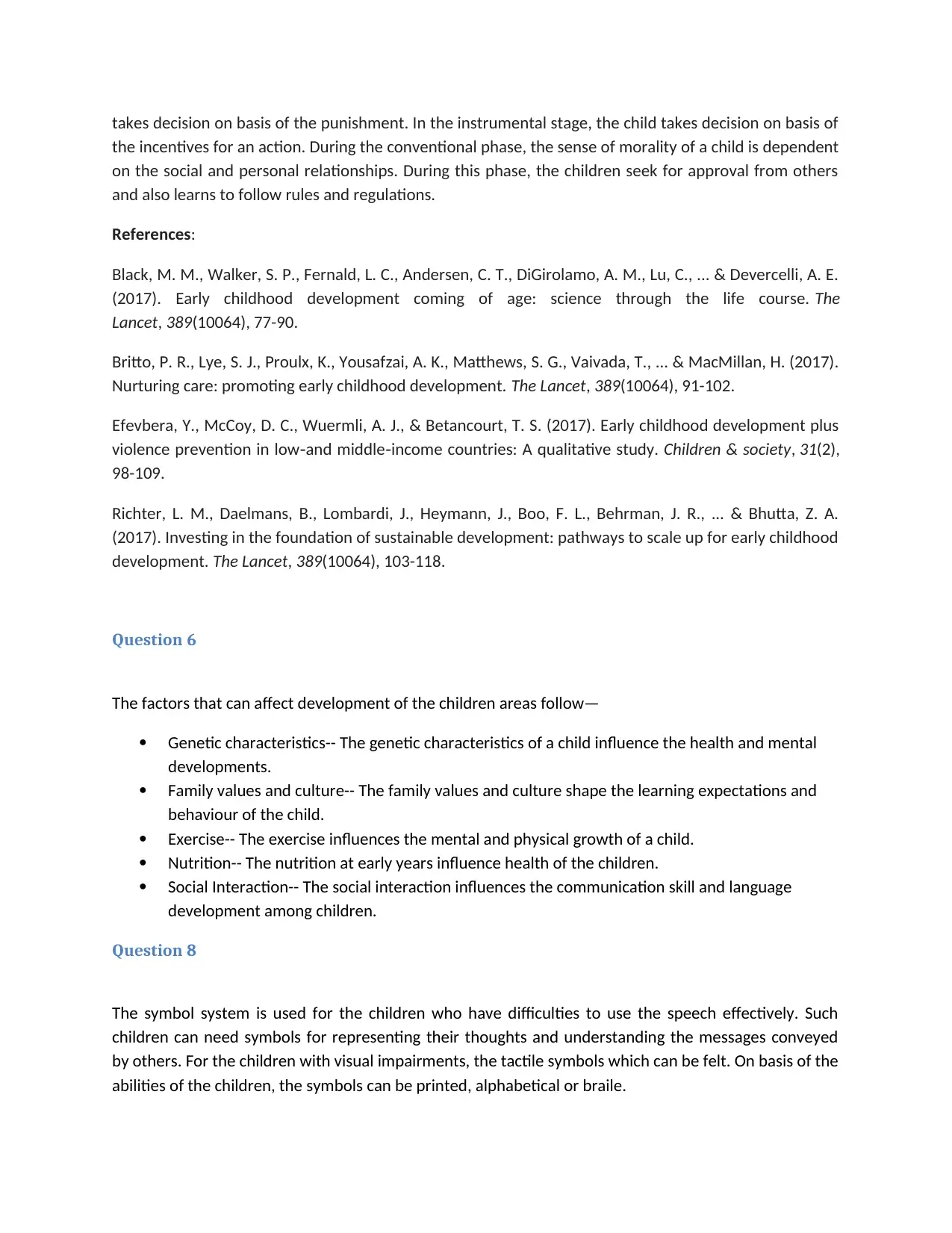
takes decision on basis of the punishment. In the instrumental stage, the child takes decision on basis of
the incentives for an action. During the conventional phase, the sense of morality of a child is dependent
on the social and personal relationships. During this phase, the children seek for approval from others
and also learns to follow rules and regulations.
References:
Black, M. M., Walker, S. P., Fernald, L. C., Andersen, C. T., DiGirolamo, A. M., Lu, C., ... & Devercelli, A. E.
(2017). Early childhood development coming of age: science through the life course. The
Lancet, 389(10064), 77-90.
Britto, P. R., Lye, S. J., Proulx, K., Yousafzai, A. K., Matthews, S. G., Vaivada, T., ... & MacMillan, H. (2017).
Nurturing care: promoting early childhood development. The Lancet, 389(10064), 91-102.
Efevbera, Y., McCoy, D. C., Wuermli, A. J., & Betancourt, T. S. (2017). Early childhood development plus
violence prevention in low and middle income countries: A qualitative study.‐ ‐ Children & society, 31(2),
98-109.
Richter, L. M., Daelmans, B., Lombardi, J., Heymann, J., Boo, F. L., Behrman, J. R., ... & Bhutta, Z. A.
(2017). Investing in the foundation of sustainable development: pathways to scale up for early childhood
development. The Lancet, 389(10064), 103-118.
Question 6
The factors that can affect development of the children areas follow—
Genetic characteristics-- The genetic characteristics of a child influence the health and mental
developments.
Family values and culture-- The family values and culture shape the learning expectations and
behaviour of the child.
Exercise-- The exercise influences the mental and physical growth of a child.
Nutrition-- The nutrition at early years influence health of the children.
Social Interaction-- The social interaction influences the communication skill and language
development among children.
Question 8
The symbol system is used for the children who have difficulties to use the speech effectively. Such
children can need symbols for representing their thoughts and understanding the messages conveyed
by others. For the children with visual impairments, the tactile symbols which can be felt. On basis of the
abilities of the children, the symbols can be printed, alphabetical or braile.
the incentives for an action. During the conventional phase, the sense of morality of a child is dependent
on the social and personal relationships. During this phase, the children seek for approval from others
and also learns to follow rules and regulations.
References:
Black, M. M., Walker, S. P., Fernald, L. C., Andersen, C. T., DiGirolamo, A. M., Lu, C., ... & Devercelli, A. E.
(2017). Early childhood development coming of age: science through the life course. The
Lancet, 389(10064), 77-90.
Britto, P. R., Lye, S. J., Proulx, K., Yousafzai, A. K., Matthews, S. G., Vaivada, T., ... & MacMillan, H. (2017).
Nurturing care: promoting early childhood development. The Lancet, 389(10064), 91-102.
Efevbera, Y., McCoy, D. C., Wuermli, A. J., & Betancourt, T. S. (2017). Early childhood development plus
violence prevention in low and middle income countries: A qualitative study.‐ ‐ Children & society, 31(2),
98-109.
Richter, L. M., Daelmans, B., Lombardi, J., Heymann, J., Boo, F. L., Behrman, J. R., ... & Bhutta, Z. A.
(2017). Investing in the foundation of sustainable development: pathways to scale up for early childhood
development. The Lancet, 389(10064), 103-118.
Question 6
The factors that can affect development of the children areas follow—
Genetic characteristics-- The genetic characteristics of a child influence the health and mental
developments.
Family values and culture-- The family values and culture shape the learning expectations and
behaviour of the child.
Exercise-- The exercise influences the mental and physical growth of a child.
Nutrition-- The nutrition at early years influence health of the children.
Social Interaction-- The social interaction influences the communication skill and language
development among children.
Question 8
The symbol system is used for the children who have difficulties to use the speech effectively. Such
children can need symbols for representing their thoughts and understanding the messages conveyed
by others. For the children with visual impairments, the tactile symbols which can be felt. On basis of the
abilities of the children, the symbols can be printed, alphabetical or braile.
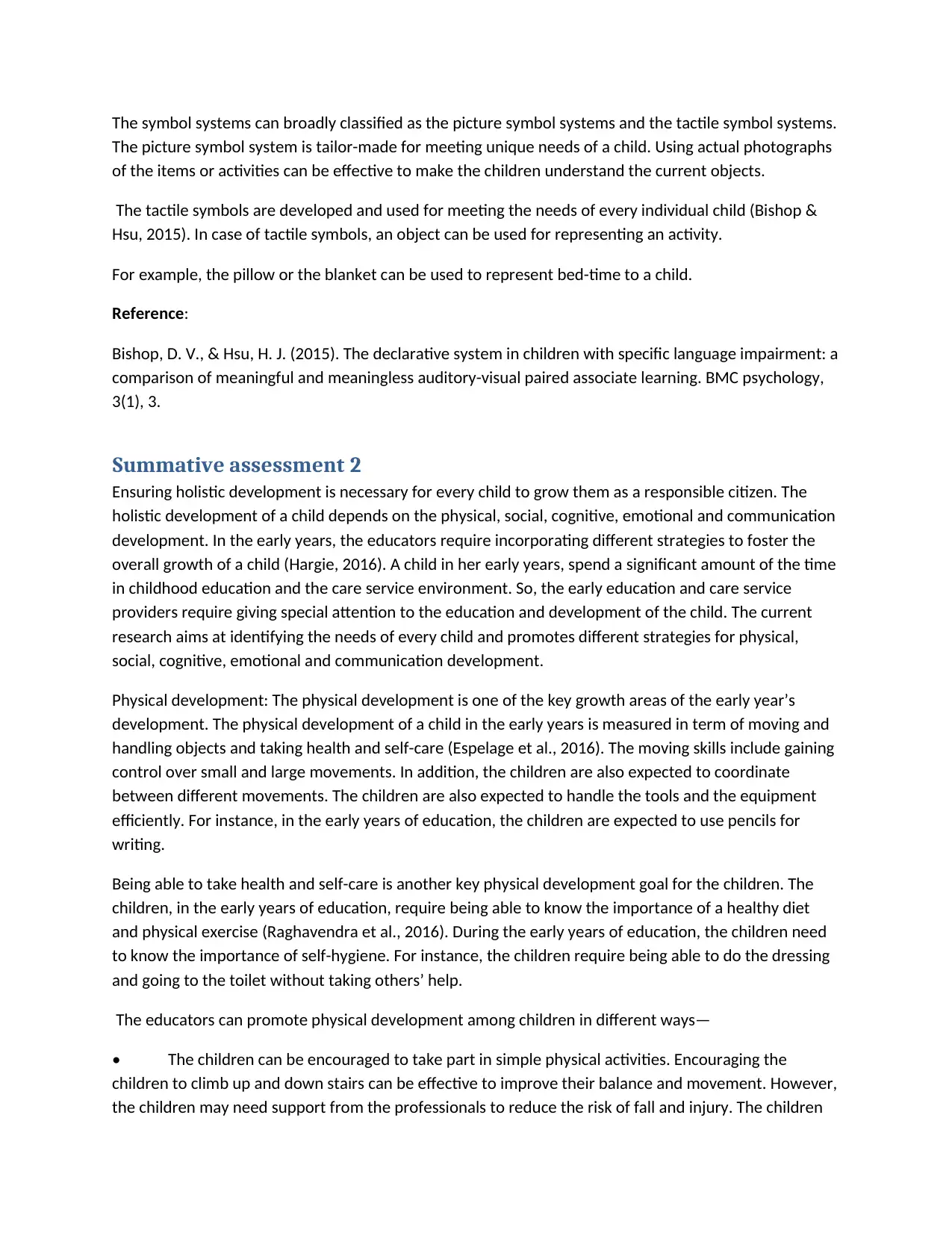
The symbol systems can broadly classified as the picture symbol systems and the tactile symbol systems.
The picture symbol system is tailor-made for meeting unique needs of a child. Using actual photographs
of the items or activities can be effective to make the children understand the current objects.
The tactile symbols are developed and used for meeting the needs of every individual child (Bishop &
Hsu, 2015). In case of tactile symbols, an object can be used for representing an activity.
For example, the pillow or the blanket can be used to represent bed-time to a child.
Reference:
Bishop, D. V., & Hsu, H. J. (2015). The declarative system in children with specific language impairment: a
comparison of meaningful and meaningless auditory-visual paired associate learning. BMC psychology,
3(1), 3.
Summative assessment 2
Ensuring holistic development is necessary for every child to grow them as a responsible citizen. The
holistic development of a child depends on the physical, social, cognitive, emotional and communication
development. In the early years, the educators require incorporating different strategies to foster the
overall growth of a child (Hargie, 2016). A child in her early years, spend a significant amount of the time
in childhood education and the care service environment. So, the early education and care service
providers require giving special attention to the education and development of the child. The current
research aims at identifying the needs of every child and promotes different strategies for physical,
social, cognitive, emotional and communication development.
Physical development: The physical development is one of the key growth areas of the early year’s
development. The physical development of a child in the early years is measured in term of moving and
handling objects and taking health and self-care (Espelage et al., 2016). The moving skills include gaining
control over small and large movements. In addition, the children are also expected to coordinate
between different movements. The children are also expected to handle the tools and the equipment
efficiently. For instance, in the early years of education, the children are expected to use pencils for
writing.
Being able to take health and self-care is another key physical development goal for the children. The
children, in the early years of education, require being able to know the importance of a healthy diet
and physical exercise (Raghavendra et al., 2016). During the early years of education, the children need
to know the importance of self-hygiene. For instance, the children require being able to do the dressing
and going to the toilet without taking others’ help.
The educators can promote physical development among children in different ways—
• The children can be encouraged to take part in simple physical activities. Encouraging the
children to climb up and down stairs can be effective to improve their balance and movement. However,
the children may need support from the professionals to reduce the risk of fall and injury. The children
The picture symbol system is tailor-made for meeting unique needs of a child. Using actual photographs
of the items or activities can be effective to make the children understand the current objects.
The tactile symbols are developed and used for meeting the needs of every individual child (Bishop &
Hsu, 2015). In case of tactile symbols, an object can be used for representing an activity.
For example, the pillow or the blanket can be used to represent bed-time to a child.
Reference:
Bishop, D. V., & Hsu, H. J. (2015). The declarative system in children with specific language impairment: a
comparison of meaningful and meaningless auditory-visual paired associate learning. BMC psychology,
3(1), 3.
Summative assessment 2
Ensuring holistic development is necessary for every child to grow them as a responsible citizen. The
holistic development of a child depends on the physical, social, cognitive, emotional and communication
development. In the early years, the educators require incorporating different strategies to foster the
overall growth of a child (Hargie, 2016). A child in her early years, spend a significant amount of the time
in childhood education and the care service environment. So, the early education and care service
providers require giving special attention to the education and development of the child. The current
research aims at identifying the needs of every child and promotes different strategies for physical,
social, cognitive, emotional and communication development.
Physical development: The physical development is one of the key growth areas of the early year’s
development. The physical development of a child in the early years is measured in term of moving and
handling objects and taking health and self-care (Espelage et al., 2016). The moving skills include gaining
control over small and large movements. In addition, the children are also expected to coordinate
between different movements. The children are also expected to handle the tools and the equipment
efficiently. For instance, in the early years of education, the children are expected to use pencils for
writing.
Being able to take health and self-care is another key physical development goal for the children. The
children, in the early years of education, require being able to know the importance of a healthy diet
and physical exercise (Raghavendra et al., 2016). During the early years of education, the children need
to know the importance of self-hygiene. For instance, the children require being able to do the dressing
and going to the toilet without taking others’ help.
The educators can promote physical development among children in different ways—
• The children can be encouraged to take part in simple physical activities. Encouraging the
children to climb up and down stairs can be effective to improve their balance and movement. However,
the children may need support from the professionals to reduce the risk of fall and injury. The children
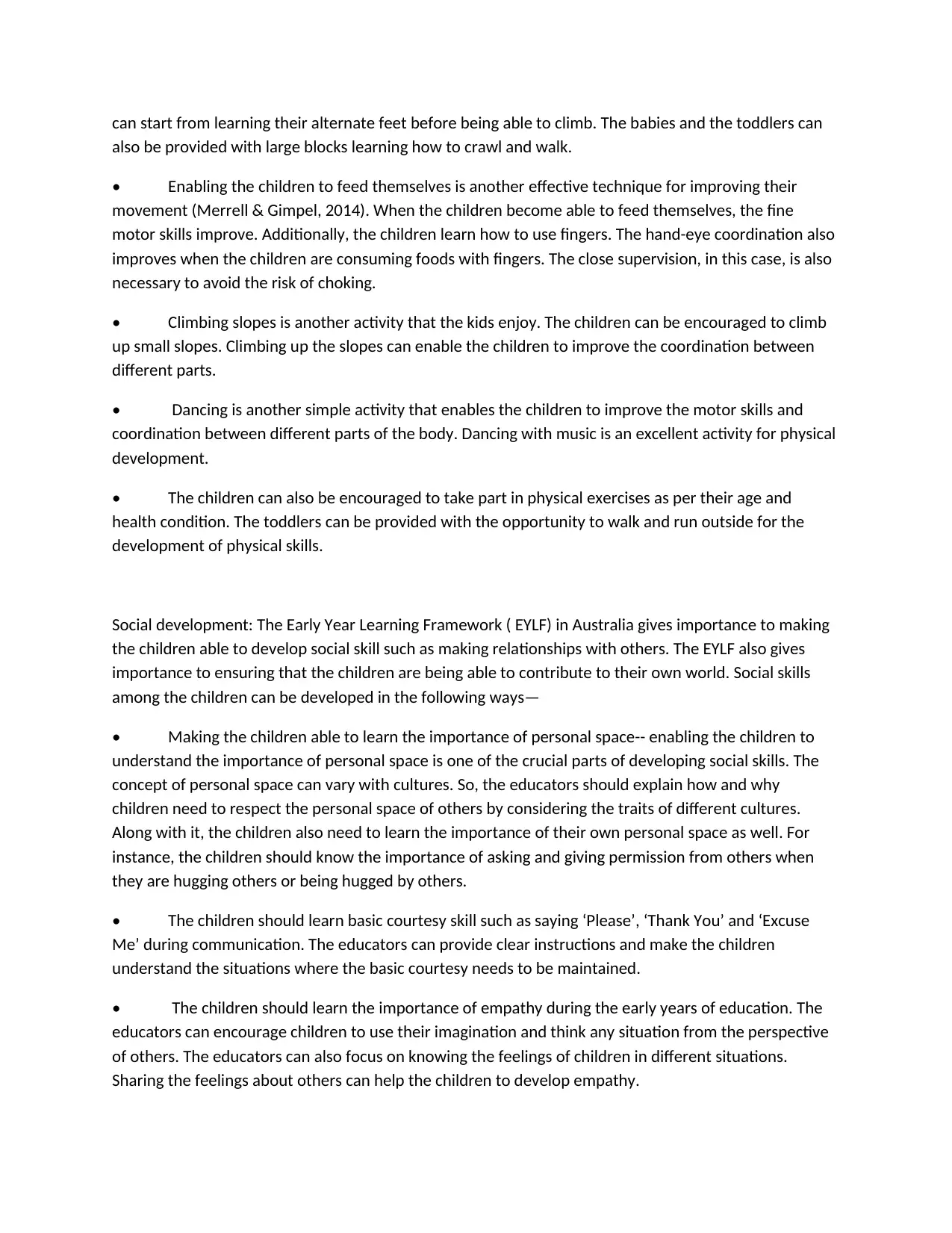
can start from learning their alternate feet before being able to climb. The babies and the toddlers can
also be provided with large blocks learning how to crawl and walk.
• Enabling the children to feed themselves is another effective technique for improving their
movement (Merrell & Gimpel, 2014). When the children become able to feed themselves, the fine
motor skills improve. Additionally, the children learn how to use fingers. The hand-eye coordination also
improves when the children are consuming foods with fingers. The close supervision, in this case, is also
necessary to avoid the risk of choking.
• Climbing slopes is another activity that the kids enjoy. The children can be encouraged to climb
up small slopes. Climbing up the slopes can enable the children to improve the coordination between
different parts.
• Dancing is another simple activity that enables the children to improve the motor skills and
coordination between different parts of the body. Dancing with music is an excellent activity for physical
development.
• The children can also be encouraged to take part in physical exercises as per their age and
health condition. The toddlers can be provided with the opportunity to walk and run outside for the
development of physical skills.
Social development: The Early Year Learning Framework ( EYLF) in Australia gives importance to making
the children able to develop social skill such as making relationships with others. The EYLF also gives
importance to ensuring that the children are being able to contribute to their own world. Social skills
among the children can be developed in the following ways—
• Making the children able to learn the importance of personal space-- enabling the children to
understand the importance of personal space is one of the crucial parts of developing social skills. The
concept of personal space can vary with cultures. So, the educators should explain how and why
children need to respect the personal space of others by considering the traits of different cultures.
Along with it, the children also need to learn the importance of their own personal space as well. For
instance, the children should know the importance of asking and giving permission from others when
they are hugging others or being hugged by others.
• The children should learn basic courtesy skill such as saying ‘Please’, ‘Thank You’ and ‘Excuse
Me’ during communication. The educators can provide clear instructions and make the children
understand the situations where the basic courtesy needs to be maintained.
• The children should learn the importance of empathy during the early years of education. The
educators can encourage children to use their imagination and think any situation from the perspective
of others. The educators can also focus on knowing the feelings of children in different situations.
Sharing the feelings about others can help the children to develop empathy.
also be provided with large blocks learning how to crawl and walk.
• Enabling the children to feed themselves is another effective technique for improving their
movement (Merrell & Gimpel, 2014). When the children become able to feed themselves, the fine
motor skills improve. Additionally, the children learn how to use fingers. The hand-eye coordination also
improves when the children are consuming foods with fingers. The close supervision, in this case, is also
necessary to avoid the risk of choking.
• Climbing slopes is another activity that the kids enjoy. The children can be encouraged to climb
up small slopes. Climbing up the slopes can enable the children to improve the coordination between
different parts.
• Dancing is another simple activity that enables the children to improve the motor skills and
coordination between different parts of the body. Dancing with music is an excellent activity for physical
development.
• The children can also be encouraged to take part in physical exercises as per their age and
health condition. The toddlers can be provided with the opportunity to walk and run outside for the
development of physical skills.
Social development: The Early Year Learning Framework ( EYLF) in Australia gives importance to making
the children able to develop social skill such as making relationships with others. The EYLF also gives
importance to ensuring that the children are being able to contribute to their own world. Social skills
among the children can be developed in the following ways—
• Making the children able to learn the importance of personal space-- enabling the children to
understand the importance of personal space is one of the crucial parts of developing social skills. The
concept of personal space can vary with cultures. So, the educators should explain how and why
children need to respect the personal space of others by considering the traits of different cultures.
Along with it, the children also need to learn the importance of their own personal space as well. For
instance, the children should know the importance of asking and giving permission from others when
they are hugging others or being hugged by others.
• The children should learn basic courtesy skill such as saying ‘Please’, ‘Thank You’ and ‘Excuse
Me’ during communication. The educators can provide clear instructions and make the children
understand the situations where the basic courtesy needs to be maintained.
• The children should learn the importance of empathy during the early years of education. The
educators can encourage children to use their imagination and think any situation from the perspective
of others. The educators can also focus on knowing the feelings of children in different situations.
Sharing the feelings about others can help the children to develop empathy.
Secure Best Marks with AI Grader
Need help grading? Try our AI Grader for instant feedback on your assignments.
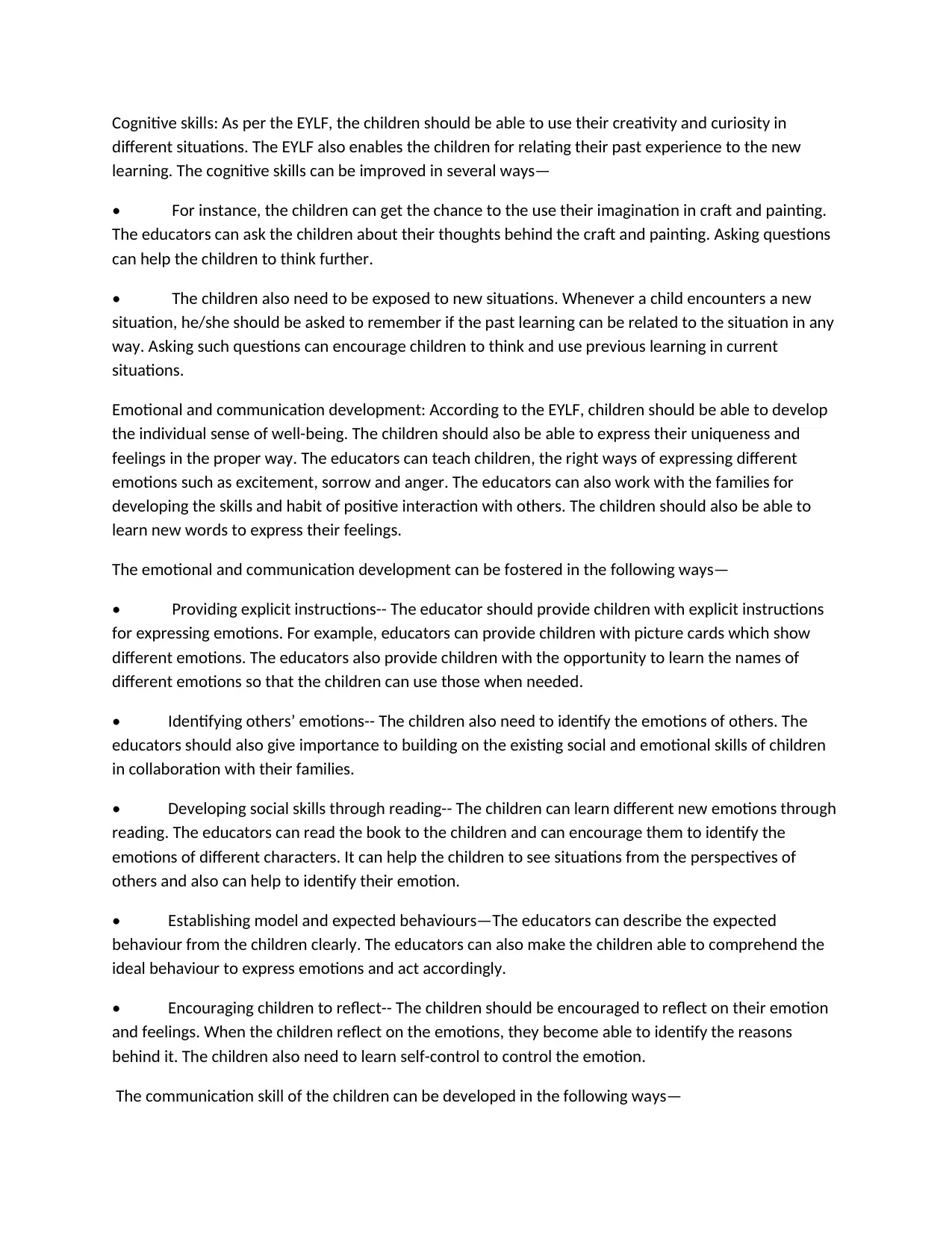
Cognitive skills: As per the EYLF, the children should be able to use their creativity and curiosity in
different situations. The EYLF also enables the children for relating their past experience to the new
learning. The cognitive skills can be improved in several ways—
• For instance, the children can get the chance to the use their imagination in craft and painting.
The educators can ask the children about their thoughts behind the craft and painting. Asking questions
can help the children to think further.
• The children also need to be exposed to new situations. Whenever a child encounters a new
situation, he/she should be asked to remember if the past learning can be related to the situation in any
way. Asking such questions can encourage children to think and use previous learning in current
situations.
Emotional and communication development: According to the EYLF, children should be able to develop
the individual sense of well-being. The children should also be able to express their uniqueness and
feelings in the proper way. The educators can teach children, the right ways of expressing different
emotions such as excitement, sorrow and anger. The educators can also work with the families for
developing the skills and habit of positive interaction with others. The children should also be able to
learn new words to express their feelings.
The emotional and communication development can be fostered in the following ways—
• Providing explicit instructions-- The educator should provide children with explicit instructions
for expressing emotions. For example, educators can provide children with picture cards which show
different emotions. The educators also provide children with the opportunity to learn the names of
different emotions so that the children can use those when needed.
• Identifying others’ emotions-- The children also need to identify the emotions of others. The
educators should also give importance to building on the existing social and emotional skills of children
in collaboration with their families.
• Developing social skills through reading-- The children can learn different new emotions through
reading. The educators can read the book to the children and can encourage them to identify the
emotions of different characters. It can help the children to see situations from the perspectives of
others and also can help to identify their emotion.
• Establishing model and expected behaviours—The educators can describe the expected
behaviour from the children clearly. The educators can also make the children able to comprehend the
ideal behaviour to express emotions and act accordingly.
• Encouraging children to reflect-- The children should be encouraged to reflect on their emotion
and feelings. When the children reflect on the emotions, they become able to identify the reasons
behind it. The children also need to learn self-control to control the emotion.
The communication skill of the children can be developed in the following ways—
different situations. The EYLF also enables the children for relating their past experience to the new
learning. The cognitive skills can be improved in several ways—
• For instance, the children can get the chance to the use their imagination in craft and painting.
The educators can ask the children about their thoughts behind the craft and painting. Asking questions
can help the children to think further.
• The children also need to be exposed to new situations. Whenever a child encounters a new
situation, he/she should be asked to remember if the past learning can be related to the situation in any
way. Asking such questions can encourage children to think and use previous learning in current
situations.
Emotional and communication development: According to the EYLF, children should be able to develop
the individual sense of well-being. The children should also be able to express their uniqueness and
feelings in the proper way. The educators can teach children, the right ways of expressing different
emotions such as excitement, sorrow and anger. The educators can also work with the families for
developing the skills and habit of positive interaction with others. The children should also be able to
learn new words to express their feelings.
The emotional and communication development can be fostered in the following ways—
• Providing explicit instructions-- The educator should provide children with explicit instructions
for expressing emotions. For example, educators can provide children with picture cards which show
different emotions. The educators also provide children with the opportunity to learn the names of
different emotions so that the children can use those when needed.
• Identifying others’ emotions-- The children also need to identify the emotions of others. The
educators should also give importance to building on the existing social and emotional skills of children
in collaboration with their families.
• Developing social skills through reading-- The children can learn different new emotions through
reading. The educators can read the book to the children and can encourage them to identify the
emotions of different characters. It can help the children to see situations from the perspectives of
others and also can help to identify their emotion.
• Establishing model and expected behaviours—The educators can describe the expected
behaviour from the children clearly. The educators can also make the children able to comprehend the
ideal behaviour to express emotions and act accordingly.
• Encouraging children to reflect-- The children should be encouraged to reflect on their emotion
and feelings. When the children reflect on the emotions, they become able to identify the reasons
behind it. The children also need to learn self-control to control the emotion.
The communication skill of the children can be developed in the following ways—
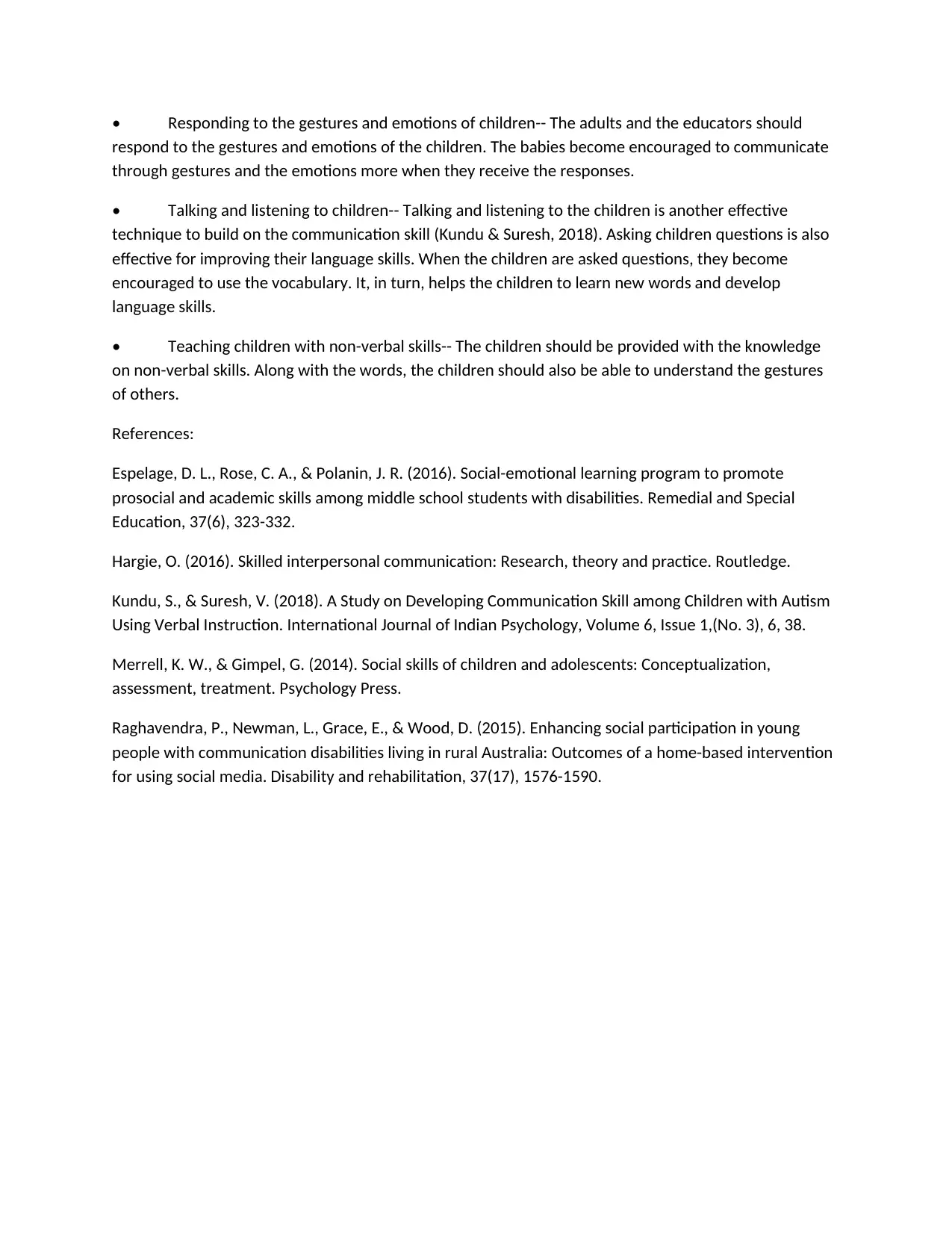
• Responding to the gestures and emotions of children-- The adults and the educators should
respond to the gestures and emotions of the children. The babies become encouraged to communicate
through gestures and the emotions more when they receive the responses.
• Talking and listening to children-- Talking and listening to the children is another effective
technique to build on the communication skill (Kundu & Suresh, 2018). Asking children questions is also
effective for improving their language skills. When the children are asked questions, they become
encouraged to use the vocabulary. It, in turn, helps the children to learn new words and develop
language skills.
• Teaching children with non-verbal skills-- The children should be provided with the knowledge
on non-verbal skills. Along with the words, the children should also be able to understand the gestures
of others.
References:
Espelage, D. L., Rose, C. A., & Polanin, J. R. (2016). Social-emotional learning program to promote
prosocial and academic skills among middle school students with disabilities. Remedial and Special
Education, 37(6), 323-332.
Hargie, O. (2016). Skilled interpersonal communication: Research, theory and practice. Routledge.
Kundu, S., & Suresh, V. (2018). A Study on Developing Communication Skill among Children with Autism
Using Verbal Instruction. International Journal of Indian Psychology, Volume 6, Issue 1,(No. 3), 6, 38.
Merrell, K. W., & Gimpel, G. (2014). Social skills of children and adolescents: Conceptualization,
assessment, treatment. Psychology Press.
Raghavendra, P., Newman, L., Grace, E., & Wood, D. (2015). Enhancing social participation in young
people with communication disabilities living in rural Australia: Outcomes of a home-based intervention
for using social media. Disability and rehabilitation, 37(17), 1576-1590.
respond to the gestures and emotions of the children. The babies become encouraged to communicate
through gestures and the emotions more when they receive the responses.
• Talking and listening to children-- Talking and listening to the children is another effective
technique to build on the communication skill (Kundu & Suresh, 2018). Asking children questions is also
effective for improving their language skills. When the children are asked questions, they become
encouraged to use the vocabulary. It, in turn, helps the children to learn new words and develop
language skills.
• Teaching children with non-verbal skills-- The children should be provided with the knowledge
on non-verbal skills. Along with the words, the children should also be able to understand the gestures
of others.
References:
Espelage, D. L., Rose, C. A., & Polanin, J. R. (2016). Social-emotional learning program to promote
prosocial and academic skills among middle school students with disabilities. Remedial and Special
Education, 37(6), 323-332.
Hargie, O. (2016). Skilled interpersonal communication: Research, theory and practice. Routledge.
Kundu, S., & Suresh, V. (2018). A Study on Developing Communication Skill among Children with Autism
Using Verbal Instruction. International Journal of Indian Psychology, Volume 6, Issue 1,(No. 3), 6, 38.
Merrell, K. W., & Gimpel, G. (2014). Social skills of children and adolescents: Conceptualization,
assessment, treatment. Psychology Press.
Raghavendra, P., Newman, L., Grace, E., & Wood, D. (2015). Enhancing social participation in young
people with communication disabilities living in rural Australia: Outcomes of a home-based intervention
for using social media. Disability and rehabilitation, 37(17), 1576-1590.
1 out of 42
Related Documents
Your All-in-One AI-Powered Toolkit for Academic Success.
+13062052269
info@desklib.com
Available 24*7 on WhatsApp / Email
![[object Object]](/_next/static/media/star-bottom.7253800d.svg)
Unlock your academic potential
© 2024 | Zucol Services PVT LTD | All rights reserved.




